Table of Contents
- KVM over IP Matrix System (CCKM & KE Matrix Manager) User Manual
- EMC Information
- RoHS
- User Information
- Package Contents
- Contents
- About This Manual
- Conventions
- Product Information
- Chapter 1 Introduction
- Overview
- Features
- Requirements
- Components
- KE6900T (Transmitter) Front View
- KE6900T (Transmitter) Rear View
- KE6900R (Receiver) Front View
- KE6900R (Receiver) Rear View
- KE6910T / KE6912T (Transmitter) Front View
- KE6910T / KE6912T (Transmitter) Rear View
- KE6910R / KE6912R (Receiver) Front View
- KE6910R / KE6912R (Receiver) Rear View
- KE6940T (Transmitter) Front View
- KE6940T (Transmitter) Rear View
- KE6940R (Receiver) Front View
- KE6940R (Receiver) Rear View
- KE6900ST (Transmitter) Front, Rear and Top View
- KE8950T / KE8952T (Transmitter) Front View
- KE8950T / KE8952T (Transmitter) Rear View
- KE8950R / KE8952R (Receiver) Front View
- KE8950R / KE8952R (Receiver) Rear View
- KE8900ST (Transmitter) Front, Rear and Side View
- KE8900SR (Receiver) Front, Rear and Side View
- KE9900ST (Transmitter) Front, Rear and Side View
- KE9950T / KE9952T (Transmitter) Front View
- KE9950T / KE9952T (Transmitter) Rear View
- KE9950R / KE9952R (Receiver) Front View
- KE9950R / KE9952R (Receiver) Rear View
- Chapter 2 Hardware Setup
- Rack Mounting
- Wall Mounting
- KE6900 Point-to-Point Installation
- KE6910 Point-to-Point Installation
- KE8950 Point-to-Point Installation
- KE6900ST Point-to-Point Installation
- KE8900S Point-to-Point Installation
- KE9900ST Point-to-Point Installation
- KE9950 Point-to-Point Installation
- KE6900 LAN Installation
- KE6910 LAN Installation
- KE8950 LAN Installation
- KE9950 LAN Installation
- Network Configuration
- Default IP Addresses
- KE I/O Ports
- LED Display
- Authentication Lock (KE6910 / KE6912 only)
- Chapter 3 OSD Operation
- Chapter 4 Software Installation
- Chapter 5 Browser / Telnet Operation
- Chapter 6 System Status
- Chapter 7 System Settings
- Chapter 8 Connections
- Chapter 9 Scheduled Profile
- Chapter 10 Sessions
- Chapter 11 Firmware Upgrade Utility
- Chapter 12 CLI Commands
- Appendix
ATEN KE6912R User Manual
Displayed below is the user manual for KE6912R by ATEN which is a product in the KVM Extenders category. This manual has 324 pages.
Related Manuals

KVM over IP Matrix System
KE6900 / KE6900ST / KE6910 / KE6912 / KE6940 / KE8900S / KE8950 /
KE8952 / KE9900ST / KE9950 / KE9952
CCKM KE Matrix Manager Software
User Manual
www.aten.com

KVM over IP Matrix System User Manual
ii
EMC Information
FEDERAL COMMUNICATIONS COMMISSION INTERFERENCE
STATEMENT: This equipment has been tested and found to comply with the
limits for a Class A digital device, pursuant to Part 15 of the FCC Rules. These
limits are designed to provide reasonable protection against harmful
interference when the equipment is operated in a commercial environment.
This equipment generates, uses, and can radiate radio frequency energy and, if
not installed and used in accordance with the instruction manual, may cause
harmful interference to radio communications. Operation of this equipment in
a residential area is likely to cause harmful interference in which case the user
will be required to correct the interference at his own expense.
The device complies with Part 15 of the FCC Rules. Operation is subject to the
following two conditions: (1) this device may not cause harmful interference,
and (2) this device must accept any interference received, including
interference that may cause undesired operation.
FCC Caution: Any changes or modifications not expressly approved by the
party responsible for compliance could void the user's authority to operate this
equipment.
Warning: Operation of this equipment in a residential environment could
cause radio interference.
KCC Statement
RoHS
This product is RoHS compliant.

KVM over IP Matrix System User Manual
iii
User Information
Online Registration
Be sure to register your product at our online support center:
Telephone Support
For telephone support, call this number:
User Notice
All information, documentation, and specifications contained in this manual
are subject to change without prior notification by the manufacturer. The
manufacturer makes no representations or warranties, either expressed or
implied, with respect to the contents hereof and specifically disclaims any
warranties as to merchantability or fitness for any particular purpose. Any of
the manufacturer's software described in this manual is sold or licensed as is.
Should the programs prove defective following their purchase, the buyer (and
not the manufacturer, its distributor, or its dealer), assumes the entire cost of all
necessary servicing, repair and any incidental or consequential damages
resulting from any defect in the software.
The manufacturer of this system is not responsible for any radio and/or TV
interference caused by unauthorized modifications to this device. It is the
responsibility of the user to correct such interference.
The manufacturer is not responsible for any damage incurred in the operation
of this system if the correct operational voltage setting was not selected prior
to operation. PLEASE VERIFY THAT THE VOLTAGE SETTING IS
CORRECT BEFORE USE.
International http://eservice.aten.com
International 886-2-8692-6959
China 86-400-810-0-810
Japan 81-3-5615-5811
Korea 82-2-467-6789
North America 1-888-999-ATEN ext 4988
1-949-428-1111

KVM over IP Matrix System User Manual
iv
Package Contents
KE6900 / KE6940
The KE6900 / KE6940 package consists of:
1 KE6900T / KE6940T DVI Single/Dual Display KVM over IP Extender
(Transmitter)
1 KE6900R / KE6940R DVI Single/Dual Display KVM over IP Extender
(Receiver)
1 USB DVI-D KVM Cable (for KE6900T/KE6940T)
1 DVI-D Cable 1.8 m (for KE6940T)
1 Foot Pad Set
2 Power Adapters
1 Mounting Kit
1 User Instructions*
KE6900ST
The KE6900ST package consists of:
1 KE6900ST DVI KVM over IP Extender Lite
1 USB DVI-D KVM Cable
1 Foot Pad Set
1 Power Adapter
1 Mounting Kit
1 User Instructions*
KE6910 / KE6912
The KE6910 / KE6912 package consists of:
1 KE6910T / KE6912T DVI-D Dual Link KVM over IP Extender
(Transmitter)
1 KE6910R / KE6912R DVI-D Dual Link KVM over IP Extender (Receiver)

KVM over IP Matrix System User Manual
v
1 USB DVI-D KVM Cable (for KE6910T/KE6912T)
2 Power Adapters (for KE6910T / KE6910R)
2 Power Cords (for KE6910T / KE6910R)
1 Foot Pad Set
2 Power Adapters
1 Mounting Kit (for KE6910T / KE6912T)
1 User Instructions*
KE8900S
The KE8900S package consists of:
1 KE8900ST Slim HDMI KVM over IP Extender (Transmitter)
1 KE8900SR Slim HDMI KVM over IP Extender (Receiver)
1 USB HDMI KVM Cable
1 Foot Pad Set
2 Power Adapters
2 Mounting Kits
2 HDMI Lockpro
1 User Instructions*
KE8950 / KE8952
The KE8950 / KE8952 package consists of:
1 KE8950T / KE8952T 4K HDMI Single Display KVM over IP Extender
(Transmitter)
1 KE8950R / KE8952R 4K HDMI Single Display KVM over IP Extender
(Receiver)
1 USB HDMI KVM Cable
1 Foot Pad Set
2 Power Cords (for KE8950T/KE8950R)
2 Power Adapters (for KE8950T/KE8950R)

KVM over IP Matrix System User Manual
vi
1 Mounting Kit (for KE8950T or KE8952T)
2 HDMI Lockpro
1 User Instructions*
KE9900ST
The KE9900ST package consists of:
1 KE9900ST Slim DisplayPort KVM over IP Extender (Transmitter)
1 DisplayPort Cable
1 USB 2.0 Type-A to Type-B Cable
1 Power Adapter
1 Mounting Kit
1 User Instructions*
KE9950 / KE9952
The KE9950 / KE9952 package consists of:
1 KE9950T / KE9952T 4K DisplayPort KVM over IP Extender
(Transmitter)
1 KE9950R / KE9952R 4K DisplayPort KVM over IP Extender (Receiver)
1 DisplayPort Cable (for KE9950T / KE9952T)
1 USB 2.0 Type-A to Type-B Cable (for KE9950T / KE9952T)
1 Foot Pad Set (for KE9950T / KE9952T)
2 Power Cords (for KE9950T / KE9950R)
2 Power Adapters (for KE9950T / KE9950R)
1 Mounting Kit (for KE9950T / KE9952T)
1 User Instructions*
*Features may have been added to the KE6900 / KE6900ST / KE6910 /
KE6912 / KE6940 / KE8900S / KE8950 / KE8952 / KE9900ST / KE9950 /
KE9952 since this manual was published. Please visit our website to
download the most up-to-date version.

KVM over IP Matrix System User Manual
vii
Check to make sure that all of the components are present and in good order. If anything
is missing, or was damaged in shipping, contact your dealer. Read this manual
thoroughly and follow the installation and operation procedures carefully to prevent any
damage to the KE6900 / KE6900ST / KE6910 / KE6912 / KE6940 / KE8900S / KE8950
/ KE8952 / KE9900ST / KE9950 / KE9952 or to any other devices on the installation.
Copyright © 2019 ATEN® International Co., Ltd.
Manual Date: 2019-06-05
Altusen and the ATEN logo are registered trademarks of ATEN International Co., Ltd. All rights reserved. All
other brand names and trademarks are the registered property of their respective owners.

KVM over IP Matrix System User Manual
viii
Contents
EMC Information . . . . . . . . . . . . . . . . . . . . . . . . . . . . . . . . . . . . . . . . . . . . ii
User Information . . . . . . . . . . . . . . . . . . . . . . . . . . . . . . . . . . . . . . . . . . . .iii
Online Registration . . . . . . . . . . . . . . . . . . . . . . . . . . . . . . . . . . . . . . . .iii
Telephone Support . . . . . . . . . . . . . . . . . . . . . . . . . . . . . . . . . . . . . . . .iii
User Notice . . . . . . . . . . . . . . . . . . . . . . . . . . . . . . . . . . . . . . . . . . . . .iii
Package Contents . . . . . . . . . . . . . . . . . . . . . . . . . . . . . . . . . . . . . . . . . . .iv
KE6900 / KE6940 . . . . . . . . . . . . . . . . . . . . . . . . . . . . . . . . . . . . . . . . .iv
KE6900ST . . . . . . . . . . . . . . . . . . . . . . . . . . . . . . . . . . . . . . . . . . . . . .iv
KE6910 / KE6912 . . . . . . . . . . . . . . . . . . . . . . . . . . . . . . . . . . . . . . . . .iv
KE8900S . . . . . . . . . . . . . . . . . . . . . . . . . . . . . . . . . . . . . . . . . . . . . . . v
KE8950 / KE8952 . . . . . . . . . . . . . . . . . . . . . . . . . . . . . . . . . . . . . . . . . v
KE9900ST . . . . . . . . . . . . . . . . . . . . . . . . . . . . . . . . . . . . . . . . . . . . . .vi
KE9950 / KE9952 . . . . . . . . . . . . . . . . . . . . . . . . . . . . . . . . . . . . . . . . .vi
Contents . . . . . . . . . . . . . . . . . . . . . . . . . . . . . . . . . . . . . . . . . . . . . . . . . viii
About This Manual . . . . . . . . . . . . . . . . . . . . . . . . . . . . . . . . . . . . . . . . . . xv
Conventions . . . . . . . . . . . . . . . . . . . . . . . . . . . . . . . . . . . . . . . . . . . . . . xvii
Product Information . . . . . . . . . . . . . . . . . . . . . . . . . . . . . . . . . . . . . . . . xvii
Chapter 1.Introduction
Overview. . . . . . . . . . . . . . . . . . . . . . . . . . . . . . . . . . . . . . . . . . . . . . . . . . . 1
Features . . . . . . . . . . . . . . . . . . . . . . . . . . . . . . . . . . . . . . . . . . . . . . . . . . . 3
Supported Video Resolutions . . . . . . . . . . . . . . . . . . . . . . . . . . . . . . . . 5
Requirements . . . . . . . . . . . . . . . . . . . . . . . . . . . . . . . . . . . . . . . . . . . . . . 6
Console . . . . . . . . . . . . . . . . . . . . . . . . . . . . . . . . . . . . . . . . . . . . . . . . . 6
Computers. . . . . . . . . . . . . . . . . . . . . . . . . . . . . . . . . . . . . . . . . . . . . . . 6
Cables . . . . . . . . . . . . . . . . . . . . . . . . . . . . . . . . . . . . . . . . . . . . . . . . . . 6
Software . . . . . . . . . . . . . . . . . . . . . . . . . . . . . . . . . . . . . . . . . . . . . . . . 6
Operating Systems . . . . . . . . . . . . . . . . . . . . . . . . . . . . . . . . . . . . . . . . 8
Components . . . . . . . . . . . . . . . . . . . . . . . . . . . . . . . . . . . . . . . . . . . . . . . 9
KE6900T (Transmitter) Front View . . . . . . . . . . . . . . . . . . . . . . . . . . . 9
KE6900T (Transmitter) Rear View . . . . . . . . . . . . . . . . . . . . . . . . . . . 10
KE6900R (Receiver) Front View . . . . . . . . . . . . . . . . . . . . . . . . . . . . 12
KE6900R (Receiver) Rear View . . . . . . . . . . . . . . . . . . . . . . . . . . . . . 14
KE6910T / KE6912T (Transmitter) Front View . . . . . . . . . . . . . . . . . 16
KE6910T / KE6912T (Transmitter) Rear View . . . . . . . . . . . . . . . . . . 17
KE6910R / KE6912R (Receiver) Front View . . . . . . . . . . . . . . . . . . . 19
KE6910R / KE6912R (Receiver) Rear View . . . . . . . . . . . . . . . . . . . . 20
KE6940T (Transmitter) Front View . . . . . . . . . . . . . . . . . . . . . . . . . . 22
KE6940T (Transmitter) Rear View . . . . . . . . . . . . . . . . . . . . . . . . . . . 23
KE6940R (Receiver) Front View . . . . . . . . . . . . . . . . . . . . . . . . . . . . 25
KE6940R (Receiver) Rear View . . . . . . . . . . . . . . . . . . . . . . . . . . . . . 27
KE6900ST (Transmitter) Front, Rear and Top View . . . . . . . . . . . . . 29
KE8950T / KE8952T (Transmitter) Front View . . . . . . . . . . . . . . . . . 31
KE8950T / KE8952T (Transmitter) Rear View . . . . . . . . . . . . . . . . . . 32

KVM over IP Matrix System User Manual
ix
KE8950R / KE8952R (Receiver) Front View . . . . . . . . . . . . . . . . . . . 34
KE8950R / KE8952R (Receiver) Rear View . . . . . . . . . . . . . . . . . . . 36
KE8900ST (Transmitter) Front, Rear and Side View . . . . . . . . . . . . . 38
KE8900SR (Receiver) Front, Rear and Side View . . . . . . . . . . . . . . . 40
KE9900ST (Transmitter) Front, Rear and Side View . . . . . . . . . . . . . 42
KE9950T / KE9952T (Transmitter) Front View . . . . . . . . . . . . . . . . . . 44
KE9950T / KE9952T (Transmitter) Rear View . . . . . . . . . . . . . . . . . . 45
KE9950R / KE9952R (Receiver) Front View . . . . . . . . . . . . . . . . . . . 47
KE9950R / KE9952R (Receiver) Rear View . . . . . . . . . . . . . . . . . . . . 48
Chapter 2.Hardware Setup
Rack Mounting . . . . . . . . . . . . . . . . . . . . . . . . . . . . . . . . . . . . . . . . . . . . . 51
KE6900T/KE6940T . . . . . . . . . . . . . . . . . . . . . . . . . . . . . . . . . . . . . . . 51
KE6900ST . . . . . . . . . . . . . . . . . . . . . . . . . . . . . . . . . . . . . . . . . . . . . 53
KE6910 / KE6912 . . . . . . . . . . . . . . . . . . . . . . . . . . . . . . . . . . . . . . . . 54
KE8900ST / KE9900ST. . . . . . . . . . . . . . . . . . . . . . . . . . . . . . . . . . . .55
KE8950T / KE8952T . . . . . . . . . . . . . . . . . . . . . . . . . . . . . . . . . . . . . 57
KE9950 / KE9952 . . . . . . . . . . . . . . . . . . . . . . . . . . . . . . . . . . . . . . . . 59
Wall Mounting . . . . . . . . . . . . . . . . . . . . . . . . . . . . . . . . . . . . . . . . . . . . .60
KE6900T/KE6940T . . . . . . . . . . . . . . . . . . . . . . . . . . . . . . . . . . . . . . . 60
KE6900ST . . . . . . . . . . . . . . . . . . . . . . . . . . . . . . . . . . . . . . . . . . . . . .61
KE6910 / KE6912 . . . . . . . . . . . . . . . . . . . . . . . . . . . . . . . . . . . . . . . . 62
KE8900ST / KE9900ST . . . . . . . . . . . . . . . . . . . . . . . . . . . . . . . . . . .63
KE8950T / KE8952T . . . . . . . . . . . . . . . . . . . . . . . . . . . . . . . . . . . . . . 64
KE9950 / KE9952 . . . . . . . . . . . . . . . . . . . . . . . . . . . . . . . . . . . . . . . . 65
KE6900 Point-to-Point Installation . . . . . . . . . . . . . . . . . . . . . . . . . . . . . .66
KE6900 Point-to-Point Installation 1 of 2. . . . . . . . . . . . . . . . . . . . . . .67
KE6900 Point-to-Point Installation 2 of 2 . . . . . . . . . . . . . . . . . . . . 68
KE6910 Point-to-Point Installation . . . . . . . . . . . . . . . . . . . . . . . . . . . . . .69
KE6910 Point-to-Point Installation 1 of 2. . . . . . . . . . . . . . . . . . . . . . .70
KE6910 Point-to-Point Installation 1 of 2 . . . . . . . . . . . . . . . . . . . . . . 71
KE8950 Point-to-Point Installation . . . . . . . . . . . . . . . . . . . . . . . . . . . . . .72
KE8950 Point-to-Point Installation 1 of 2. . . . . . . . . . . . . . . . . . . . . . .73
KE8950 Point-to-Point Installation 2 of 2 . . . . . . . . . . . . . . . . . . . . 74
KE6900ST Point-to-Point Installation . . . . . . . . . . . . . . . . . . . . . . . . . . . . 75
Setting up a LAN Installation . . . . . . . . . . . . . . . . . . . . . . . . . . . . . 75
KE8900S Point-to-Point Installation . . . . . . . . . . . . . . . . . . . . . . . . . . . . . 77
Setting up a LAN Installation . . . . . . . . . . . . . . . . . . . . . . . . . . . . . 77
KE9900ST Point-to-Point Installation . . . . . . . . . . . . . . . . . . . . . . . . . . . . 79
Setting up a LAN Installation . . . . . . . . . . . . . . . . . . . . . . . . . . . . . 79
KE9950 Point-to-Point Installation . . . . . . . . . . . . . . . . . . . . . . . . . . . . . .81
KE9950 Point-to-Point Installation 1 of 2. . . . . . . . . . . . . . . . . . . . . . .82
KE9950 Point-to-Point Installation 2 of 2 . . . . . . . . . . . . . . . . . . . . 83
KE6900 LAN Installation . . . . . . . . . . . . . . . . . . . . . . . . . . . . . . . . . . . . . 84
KE6900 Network Installation Diagram 1 of 2 . . . . . . . . . . . . . . . . . . . 86
KE6900 Network Installation Diagram 2 of 2 . . . . . . . . . . . . . . . . . 87

KVM over IP Matrix System User Manual
x
KE6910 LAN Installation . . . . . . . . . . . . . . . . . . . . . . . . . . . . . . . . . . . . . 88
KE6910 Network Installation Diagram 1 of 2 . . . . . . . . . . . . . . . . . . . 89
KE6910 Network Installation Diagram 2 of 2. . . . . . . . . . . . . . . . . 90
KE8950 LAN Installation . . . . . . . . . . . . . . . . . . . . . . . . . . . . . . . . . . . . . 91
KE8950 Network Installation Diagram 1 of 2 . . . . . . . . . . . . . . . . . . . 93
KE8950 Network Installation Diagram 2 of 2. . . . . . . . . . . . . . . . . 94
KE9950 LAN Installation . . . . . . . . . . . . . . . . . . . . . . . . . . . . . . . . . . . . . 95
KE9950 Network Installation Diagram 1 of 2 . . . . . . . . . . . . . . . . . . . 96
KE9950 Network Installation Diagram 2 of 2. . . . . . . . . . . . . . . . . 97
Network Configuration . . . . . . . . . . . . . . . . . . . . . . . . . . . . . . . . . . . . . . . 98
Exit OSD . . . . . . . . . . . . . . . . . . . . . . . . . . . . . . . . . . . . . . . . . . . . . . 99
Default IP Addresses . . . . . . . . . . . . . . . . . . . . . . . . . . . . . . . . . . . . . . . . 99
KE I/O Ports . . . . . . . . . . . . . . . . . . . . . . . . . . . . . . . . . . . . . . . . . . . . . . 100
LED Display . . . . . . . . . . . . . . . . . . . . . . . . . . . . . . . . . . . . . . . . . . . . . . 101
Authentication Lock (KE6910 / KE6912 only). . . . . . . . . . . . . . . . . . . . . 101
Chapter 3.OSD Operation
Overview. . . . . . . . . . . . . . . . . . . . . . . . . . . . . . . . . . . . . . . . . . . . . . . . . 103
Invoking the OSD . . . . . . . . . . . . . . . . . . . . . . . . . . . . . . . . . . . . . . . . . . 103
Touch Screen Calibration . . . . . . . . . . . . . . . . . . . . . . . . . . . . . . . . . 103
OSD Hotkeys . . . . . . . . . . . . . . . . . . . . . . . . . . . . . . . . . . . . . . . . . . . . . 104
Microphone Hotkey . . . . . . . . . . . . . . . . . . . . . . . . . . . . . . . . . . . . . . 104
OSD Interface . . . . . . . . . . . . . . . . . . . . . . . . . . . . . . . . . . . . . . . . . . . . 105
Receiver Configuration . . . . . . . . . . . . . . . . . . . . . . . . . . . . . . . . . . . . . . 106
Network . . . . . . . . . . . . . . . . . . . . . . . . . . . . . . . . . . . . . . . . . . . . . . . 106
Properties . . . . . . . . . . . . . . . . . . . . . . . . . . . . . . . . . . . . . . . . . . . . . 107
Regular Version. . . . . . . . . . . . . . . . . . . . . . . . . . . . . . . . . . . . . . 107
Slim Version . . . . . . . . . . . . . . . . . . . . . . . . . . . . . . . . . . . . . . . . 110
System . . . . . . . . . . . . . . . . . . . . . . . . . . . . . . . . . . . . . . . . . . . . . . . 113
Transmitter Configuration . . . . . . . . . . . . . . . . . . . . . . . . . . . . . . . . . . . 114
Network . . . . . . . . . . . . . . . . . . . . . . . . . . . . . . . . . . . . . . . . . . . . . . . 114
Properties . . . . . . . . . . . . . . . . . . . . . . . . . . . . . . . . . . . . . . . . . . . . . 115
System . . . . . . . . . . . . . . . . . . . . . . . . . . . . . . . . . . . . . . . . . . . . . . . 118
User Preferences . . . . . . . . . . . . . . . . . . . . . . . . . . . . . . . . . . . . . . . . . . 119
Connecting . . . . . . . . . . . . . . . . . . . . . . . . . . . . . . . . . . . . . . . . . . . . . . . 120
Connections Page. . . . . . . . . . . . . . . . . . . . . . . . . . . . . . . . . . . . . . . 121
List Mode . . . . . . . . . . . . . . . . . . . . . . . . . . . . . . . . . . . . . . . . . . 121
Array Mode . . . . . . . . . . . . . . . . . . . . . . . . . . . . . . . . . . . . . . . . . 124
Profile Page . . . . . . . . . . . . . . . . . . . . . . . . . . . . . . . . . . . . . . . . . . . 126
Push Content . . . . . . . . . . . . . . . . . . . . . . . . . . . . . . . . . . . . . . . . . . 128
Pull Content . . . . . . . . . . . . . . . . . . . . . . . . . . . . . . . . . . . . . . . . . . . 130
Chapter 4.Software Installation
Overview. . . . . . . . . . . . . . . . . . . . . . . . . . . . . . . . . . . . . . . . . . . . . . . . . 133
Download - Trial Version . . . . . . . . . . . . . . . . . . . . . . . . . . . . . . . . . . . . 133
KE Matrix Manager Software Install . . . . . . . . . . . . . . . . . . . . . . . . . . . 135
Upgrading Trial Version . . . . . . . . . . . . . . . . . . . . . . . . . . . . . . . . . . . . . 138

KVM over IP Matrix System User Manual
xi
Linux Installation . . . . . . . . . . . . . . . . . . . . . . . . . . . . . . . . . . . . . . . . . .139
Chapter 5.Browser / Telnet Operation
Overview . . . . . . . . . . . . . . . . . . . . . . . . . . . . . . . . . . . . . . . . . . . . . . . . . 143
Logging In . . . . . . . . . . . . . . . . . . . . . . . . . . . . . . . . . . . . . . . . . . . . . . . . 143
The KE Matrix Manager Main Page . . . . . . . . . . . . . . . . . . . . . . . . . . . . 144
Web Components . . . . . . . . . . . . . . . . . . . . . . . . . . . . . . . . . . . . . . .144
Installation Wizard . . . . . . . . . . . . . . . . . . . . . . . . . . . . . . . . . . . . . . . . . 146
Instant Link . . . . . . . . . . . . . . . . . . . . . . . . . . . . . . . . . . . . . . . . . . . . . . . 149
RS-232 / Telnet . . . . . . . . . . . . . . . . . . . . . . . . . . . . . . . . . . . . . . . . . . . 151
Telnet . . . . . . . . . . . . . . . . . . . . . . . . . . . . . . . . . . . . . . . . . . . . . . . .151
RS-232 . . . . . . . . . . . . . . . . . . . . . . . . . . . . . . . . . . . . . . . . . . . . . . . 152
Configuration Menu . . . . . . . . . . . . . . . . . . . . . . . . . . . . . . . . . . . . . .153
Main Menu . . . . . . . . . . . . . . . . . . . . . . . . . . . . . . . . . . . . . . . . . .153
1. Network . . . . . . . . . . . . . . . . . . . . . . . . . . . . . . . . . . . . . . . . . .154
2. Properties . . . . . . . . . . . . . . . . . . . . . . . . . . . . . . . . . . . . . . . . 154
3. System . . . . . . . . . . . . . . . . . . . . . . . . . . . . . . . . . . . . . . . . . .155
Chapter 6.System Status
Overview . . . . . . . . . . . . . . . . . . . . . . . . . . . . . . . . . . . . . . . . . . . . . . . . . 157
System Status . . . . . . . . . . . . . . . . . . . . . . . . . . . . . . . . . . . . . . . . . . . . 158
Transmitter . . . . . . . . . . . . . . . . . . . . . . . . . . . . . . . . . . . . . . . . . . . . . . . 160
Transmitter Configuration . . . . . . . . . . . . . . . . . . . . . . . . . . . . . . . . . 162
Copy & Paste . . . . . . . . . . . . . . . . . . . . . . . . . . . . . . . . . . . . . . .167
Virtual Transmitter . . . . . . . . . . . . . . . . . . . . . . . . . . . . . . . . . . . . . .168
Intelligent Dual Video Output Management . . . . . . . . . . . . . . . .169
Transmitter Group . . . . . . . . . . . . . . . . . . . . . . . . . . . . . . . . . . . . . . 170
Transmitter Permissions . . . . . . . . . . . . . . . . . . . . . . . . . . . . . . . . . . 171
Receiver . . . . . . . . . . . . . . . . . . . . . . . . . . . . . . . . . . . . . . . . . . . . . . . . . 173
Receiver Configuration . . . . . . . . . . . . . . . . . . . . . . . . . . . . . . . . . . . 175
Copy & Paste . . . . . . . . . . . . . . . . . . . . . . . . . . . . . . . . . . . . . . .179
Receiver Group . . . . . . . . . . . . . . . . . . . . . . . . . . . . . . . . . . . . . . . . 180
Video Wall . . . . . . . . . . . . . . . . . . . . . . . . . . . . . . . . . . . . . . . . . . . . . 181
Receiver Permissions . . . . . . . . . . . . . . . . . . . . . . . . . . . . . . . . . . . . 184
Account . . . . . . . . . . . . . . . . . . . . . . . . . . . . . . . . . . . . . . . . . . . . . . . . .185
Users . . . . . . . . . . . . . . . . . . . . . . . . . . . . . . . . . . . . . . . . . . . . . . . . 186
Adding Users. . . . . . . . . . . . . . . . . . . . . . . . . . . . . . . . . . . . . . . . . . .186
Modifying Users . . . . . . . . . . . . . . . . . . . . . . . . . . . . . . . . . . . . . . . . 188
Deleting Users . . . . . . . . . . . . . . . . . . . . . . . . . . . . . . . . . . . . . . . . .188
Groups . . . . . . . . . . . . . . . . . . . . . . . . . . . . . . . . . . . . . . . . . . . . . . .189
Adding Groups . . . . . . . . . . . . . . . . . . . . . . . . . . . . . . . . . . . . . . . . . 189
Modifying Groups . . . . . . . . . . . . . . . . . . . . . . . . . . . . . . . . . . . . . . . 190
Deleting Groups . . . . . . . . . . . . . . . . . . . . . . . . . . . . . . . . . . . . . . . . 190
Permissions . . . . . . . . . . . . . . . . . . . . . . . . . . . . . . . . . . . . . . . . . . . . . .191
Assigning Device Permissions . . . . . . . . . . . . . . . . . . . . . . . . . . . . . 191
Profile . . . . . . . . . . . . . . . . . . . . . . . . . . . . . . . . . . . . . . . . . . . . . . . . . . . 193
Adding a Profile . . . . . . . . . . . . . . . . . . . . . . . . . . . . . . . . . . . . . . . . 194

KVM over IP Matrix System User Manual
xii
Adding a Schedule . . . . . . . . . . . . . . . . . . . . . . . . . . . . . . . . . . . . . . 197
Log . . . . . . . . . . . . . . . . . . . . . . . . . . . . . . . . . . . . . . . . . . . . . . . . . . . . . 198
Chapter 7.System Settings
Overview. . . . . . . . . . . . . . . . . . . . . . . . . . . . . . . . . . . . . . . . . . . . . . . . . 199
General . . . . . . . . . . . . . . . . . . . . . . . . . . . . . . . . . . . . . . . . . . . . . . . . . . 199
Connection Redundancy (KE6910 / 6912 only) . . . . . . . . . . . . . . . . 202
ANMS . . . . . . . . . . . . . . . . . . . . . . . . . . . . . . . . . . . . . . . . . . . . . . . . . . 205
Event Destination . . . . . . . . . . . . . . . . . . . . . . . . . . . . . . . . . . . . . . . 205
Authentication & Authorization . . . . . . . . . . . . . . . . . . . . . . . . . . . . . 207
FW Upgrade . . . . . . . . . . . . . . . . . . . . . . . . . . . . . . . . . . . . . . . . . . . . . 210
Firmware Upgrade Recovery . . . . . . . . . . . . . . . . . . . . . . . . . . . . . . 211
Redundancy . . . . . . . . . . . . . . . . . . . . . . . . . . . . . . . . . . . . . . . . . . . . . . 212
Backup / Restore . . . . . . . . . . . . . . . . . . . . . . . . . . . . . . . . . . . . . . . . . . 214
Backup . . . . . . . . . . . . . . . . . . . . . . . . . . . . . . . . . . . . . . . . . . . . . . . 215
Restore . . . . . . . . . . . . . . . . . . . . . . . . . . . . . . . . . . . . . . . . . . . . . . . 215
Certificates . . . . . . . . . . . . . . . . . . . . . . . . . . . . . . . . . . . . . . . . . . . . . . . 216
Private Certificate . . . . . . . . . . . . . . . . . . . . . . . . . . . . . . . . . . . . . . . 216
Certificate Signing Request . . . . . . . . . . . . . . . . . . . . . . . . . . . . . . . 217
Sessions . . . . . . . . . . . . . . . . . . . . . . . . . . . . . . . . . . . . . . . . . . . . . . . . 219
Chapter 8.Connections
Overview. . . . . . . . . . . . . . . . . . . . . . . . . . . . . . . . . . . . . . . . . . . . . . . . . 221
Connections . . . . . . . . . . . . . . . . . . . . . . . . . . . . . . . . . . . . . . . . . . . . . . 222
Chapter 9.Scheduled Profile
Overview. . . . . . . . . . . . . . . . . . . . . . . . . . . . . . . . . . . . . . . . . . . . . . . . . 225
Chapter 10.Sessions
Overview. . . . . . . . . . . . . . . . . . . . . . . . . . . . . . . . . . . . . . . . . . . . . . . . . 227
Chapter 11.Firmware Upgrade Utility
Preparation . . . . . . . . . . . . . . . . . . . . . . . . . . . . . . . . . . . . . . . . . . . . . . . 229
Starting the Upgrade . . . . . . . . . . . . . . . . . . . . . . . . . . . . . . . . . . . . . . . 230
Upgrade Succeeded . . . . . . . . . . . . . . . . . . . . . . . . . . . . . . . . . . . . . . . 232
Firmware Upgrade Recovery . . . . . . . . . . . . . . . . . . . . . . . . . . . . . . . . . 233
Chapter 12.CLI Commands
Serial Control Protocol Commands . . . . . . . . . . . . . . . . . . . . . . . . . . . . 235
Configuring the Serial Port . . . . . . . . . . . . . . . . . . . . . . . . . . . . . . . . 235
Device/Profile Commands . . . . . . . . . . . . . . . . . . . . . . . . . . . . . . . . 236
Telnet . . . . . . . . . . . . . . . . . . . . . . . . . . . . . . . . . . . . . . . . . . . . . . . . 236
Verification . . . . . . . . . . . . . . . . . . . . . . . . . . . . . . . . . . . . . . . . . . . . 236
Switch Port Command . . . . . . . . . . . . . . . . . . . . . . . . . . . . . . . . . . . 237
Mute Command . . . . . . . . . . . . . . . . . . . . . . . . . . . . . . . . . . . . . . . . 241
Profile Command . . . . . . . . . . . . . . . . . . . . . . . . . . . . . . . . . . . . . . . 243
EDID Command . . . . . . . . . . . . . . . . . . . . . . . . . . . . . . . . . . . . . . . . 245
Reset Command . . . . . . . . . . . . . . . . . . . . . . . . . . . . . . . . . . . . . . . 247

KVM over IP Matrix System User Manual
xiii
RS-232 Command . . . . . . . . . . . . . . . . . . . . . . . . . . . . . . . . . . . . . . 248
OSD Command . . . . . . . . . . . . . . . . . . . . . . . . . . . . . . . . . . . . . . . . 251
List Command . . . . . . . . . . . . . . . . . . . . . . . . . . . . . . . . . . . . . . . . . 252
Read Command . . . . . . . . . . . . . . . . . . . . . . . . . . . . . . . . . . . . . . . .254
Set Command . . . . . . . . . . . . . . . . . . . . . . . . . . . . . . . . . . . . . . . . . 258
Appendix
Safety Instructions. . . . . . . . . . . . . . . . . . . . . . . . . . . . . . . . . . . . . . . . . . 267
General . . . . . . . . . . . . . . . . . . . . . . . . . . . . . . . . . . . . . . . . . . . . . . .267
Rack Mounting . . . . . . . . . . . . . . . . . . . . . . . . . . . . . . . . . . . . . . . . . 269
Technical Support . . . . . . . . . . . . . . . . . . . . . . . . . . . . . . . . . . . . . . . . .270
International . . . . . . . . . . . . . . . . . . . . . . . . . . . . . . . . . . . . . . . . . . . 270
North America . . . . . . . . . . . . . . . . . . . . . . . . . . . . . . . . . . . . . . . . . 270
Specifications . . . . . . . . . . . . . . . . . . . . . . . . . . . . . . . . . . . . . . . . . . . . .271
KE6900T / KE6940T . . . . . . . . . . . . . . . . . . . . . . . . . . . . . . . . . . . . 271
KE6900R / KE6940R . . . . . . . . . . . . . . . . . . . . . . . . . . . . . . . . . . . . 273
KE6900ST . . . . . . . . . . . . . . . . . . . . . . . . . . . . . . . . . . . . . . . . . . . .274
KE6910 . . . . . . . . . . . . . . . . . . . . . . . . . . . . . . . . . . . . . . . . . . . . . . .275
KE6912 . . . . . . . . . . . . . . . . . . . . . . . . . . . . . . . . . . . . . . . . . . . . . . .277
KE8900S . . . . . . . . . . . . . . . . . . . . . . . . . . . . . . . . . . . . . . . . . . . . . 279
KE8950T / KE8952T . . . . . . . . . . . . . . . . . . . . . . . . . . . . . . . . . . . . 280
KE8950R / KE8952R . . . . . . . . . . . . . . . . . . . . . . . . . . . . . . . . . . . . 281
KE9900ST . . . . . . . . . . . . . . . . . . . . . . . . . . . . . . . . . . . . . . . . . . . .282
KE9950 . . . . . . . . . . . . . . . . . . . . . . . . . . . . . . . . . . . . . . . . . . . . . . .283
KE9952 . . . . . . . . . . . . . . . . . . . . . . . . . . . . . . . . . . . . . . . . . . . . . . .285
Optional Rack Mounting . . . . . . . . . . . . . . . . . . . . . . . . . . . . . . . . . . . . . 287
Dual Rack Mounting . . . . . . . . . . . . . . . . . . . . . . . . . . . . . . . . . . . . . 287
Transmitter Dual Rack Mounting . . . . . . . . . . . . . . . . . . . . . . . . . 287
Receiver Dual Rack Mounting . . . . . . . . . . . . . . . . . . . . . . . . . . .289
Single Rack Mounting . . . . . . . . . . . . . . . . . . . . . . . . . . . . . . . . . . . 291
IP Installer . . . . . . . . . . . . . . . . . . . . . . . . . . . . . . . . . . . . . . . . . . . . . . .293
Trusted Certificates . . . . . . . . . . . . . . . . . . . . . . . . . . . . . . . . . . . . . . . . 294
Overview . . . . . . . . . . . . . . . . . . . . . . . . . . . . . . . . . . . . . . . . . . . . . 294
Self-Signed Private Certificates . . . . . . . . . . . . . . . . . . . . . . . . . . . . . . . 295
Examples . . . . . . . . . . . . . . . . . . . . . . . . . . . . . . . . . . . . . . . . . . . . .295
Importing the Files . . . . . . . . . . . . . . . . . . . . . . . . . . . . . . . . . . . . . . 295
RS-232 Pin Assignments . . . . . . . . . . . . . . . . . . . . . . . . . . . . . . . . . . . .296
Transmitter Front RS-232 Port . . . . . . . . . . . . . . . . . . . . . . . . . . 296
Multicast IP Address . . . . . . . . . . . . . . . . . . . . . . . . . . . . . . . . . . . . . . . 297
KE Multicast Rule . . . . . . . . . . . . . . . . . . . . . . . . . . . . . . . . . . . . . . . 297
Multicast IP Formula . . . . . . . . . . . . . . . . . . . . . . . . . . . . . . . . . . . . . 297
If X is between 0 ~ 127 . . . . . . . . . . . . . . . . . . . . . . . . . . . . . . . . 297
If X is between 128 ~ 192 . . . . . . . . . . . . . . . . . . . . . . . . . . . . . . 298
If X is 192 or higher . . . . . . . . . . . . . . . . . . . . . . . . . . . . . . . . . . . 298
Keys to Network Performance . . . . . . . . . . . . . . . . . . . . . . . . . . . . . . . . 299
Build a Network Diagram . . . . . . . . . . . . . . . . . . . . . . . . . . . . . . . . . 299

KVM over IP Matrix System User Manual
xiv
Other Factors . . . . . . . . . . . . . . . . . . . . . . . . . . . . . . . . . . . . . . . 299
Choose a High Performance Switch . . . . . . . . . . . . . . . . . . . . . . . . 301
Layer 2 or Layer 3 Switches . . . . . . . . . . . . . . . . . . . . . . . . . . . . 301
Considerations . . . . . . . . . . . . . . . . . . . . . . . . . . . . . . . . . . . . . . . . . 301
Number of ports . . . . . . . . . . . . . . . . . . . . . . . . . . . . . . . . . . . . . 301
Stackable verse Standalone . . . . . . . . . . . . . . . . . . . . . . . . . . . . 301
What Stackable Switches Can do: . . . . . . . . . . . . . . . . . . . . . . . 302
Switch Specifications. . . . . . . . . . . . . . . . . . . . . . . . . . . . . . . . . . 302
Configuring Switches and KE Devices . . . . . . . . . . . . . . . . . . . . . . . 303
KE transmitter Settings:. . . . . . . . . . . . . . . . . . . . . . . . . . . . . . . . 303
Recommended Network Switches . . . . . . . . . . . . . . . . . . . . . . . . . . 303
Setup CCKM Server IP address on Windows . . . . . . . . . . . . . . . . . . . . 305
Limited Warranty. . . . . . . . . . . . . . . . . . . . . . . . . . . . . . . . . . . . . . . . . . . 306

KVM over IP Matrix System User Manual
xv
About This Manual
This User Manual is provided to help you get the most from your KVM over
IP Matrix System. It covers all aspects of installation, configuration and
operation. An overview of the information found in the manual is provided
below.
Chapter 1, Introduction, introduces you to the KVM over IP Matrix
System. Its purpose, features and benefits are presented, and its front and back
panel components are described.
Chapter 2, Hardware Setup, provides step-by-step instructions for setting
up your installation, and explains some basic operation procedures.
Chapter 3, OSD Operation, explains the fundamental concepts involved in
operating the KE6900 / KE6900ST / KE6910 / KE6912 / KE6940 / KE8900S
/ KE8950 / KE8952 / KE9900ST / KE9950 / KE9952, and provides a complete
description of the On Screen Displays (OSDs) and how to work with them.
Chapter 4, Software Installation, explains the administrative procedures
that are required to download and install the KE Matrix Manager software on
Windows and Linux computers.
Chapter 5, Browser / Telnet Operation, explains how to log in to the KE
Matrix Manager with a web browser, and describes the features, functions, and
how to work with the browser's main interface.
Chapter 6, System Status, explains how to use the KE Matrix Manager’s
System Status panel to manage Transmitters, Receivers, Users, Profiles and
Logs.
Chapter 7, System Settings, explains the KE Matrix Manager’s system
settings, which include the General, ANMS, LDAP/AD, RADIUS, TACACS+
authentication, F/W Upgrade, Redundancy, Backup/Restore, Certificates, and
Sessions tabs.
Chapter 8, Connections, describes how to use the KE Matrix Manager ‘s
Connections panel to view and disconnect Transmitter and Receiver
connections.
Chapter 9, Scheduled Profile, describes how to use the KE Matrix
Manager’s Scheduled Profile panel to view active profile schedules.
Chapter 10, Sessions, describes how to use the KE Matrix Manager’s
Sessions panel to view and disconnect user sessions.
Chapter 11, Firmware Upgrade Utility, explains how to download and
use the Firmware Upgrade Utility to install new firmware on the devices.

KVM over IP Matrix System User Manual
xvi
Chapter 12, CLI Commands, provides a complete list of the serial
protocol and TCP/IP commands used when utilizing the RS-232 Serial Port or
a network connection to configure the KE devices.
An Appendix, at the end of the manual provides technical and
troubleshooting information.

KVM over IP Matrix System User Manual
xvii
Conventions
This manual uses the following conventions:
Product Information
For information about all ATEN products and how they can help you connect
without limits, visit ATEN on the Web or contact an ATEN Authorized
Reseller. Visit ATEN on the Web for a list of locations and telephone numbers:
Monospaced Indicates text that you should key in.
[ ] Indicates keys you should press. For example, [Enter] means
to press the Enter key. If keys need to be chorded, they appear
together in the same bracket with a plus sign between them:
[Ctrl+Alt].
1. Numbered lists represent procedures with sequential steps.
♦Bullet lists provide information, but do not involve sequential
steps.
→Indicates selecting the option (on a menu or dialog box, for
example), that comes next. For example, Start → Run means
to open the Start menu, and then select Run.
Indicates critical information.
International http://www.aten.com
North America http://www.aten-usa.com

KVM over IP Matrix System User Manual
xviii
This Page Intentionally Left Blank

1
Chapter 1
Introduction
Overview
The KVM over IP Matrix System is a solution that combines KE Series
Extenders (KE6900, KE6940, KE6900ST, KE6910, KE6912, KE8900S,
KE8950, KE8952, KE9900ST, KE9950, KE9952), with the KE Matrix
Manager Software (CCKM) to extend, control and monitor access to
computers, across a network, in a multitude of ways. The system lets you setup
a matrix of remote KVM consoles that access computers across a network, with
the flexibility to control and configure each connection.
The KE Extenders consist of transmitters that connects to the computer and
receivers that provide console access from a separate location. The computer
is accessed from the remote console via a standard TCP/IP network or direct
Ethernet cable connection. This is perfect for any installation where you need
to place the console where it is convenient, but you want the computer to reside
in a secure location - away from the keyboard, mouse and display.
KE6900 is a single view extender that supports one DVI display at each end.
The KE6940 is a dual view extender that supports two DVI displays at each
end, allowing the video output to display across two monitors.
KE8950 and KE8952 are single view 4K HDMI extenders that support HDCP
1.4 and HDMI 1.4a. The KE89 Series connect unit-to-unit or over a TCP/IP
network via a Gigabit Ethernet or SFP port. Additionally, the KE8952’s
Gigabit LAN port supports Power over Ethernet (PoE) which provides a
network connection and powers the unit from a network switch over Cat 5e
cable.
KE6910 and KE6912 support one DVI display at each end, providing video
resolutions up to 2560 x 2048 @ 50Hz and flawless and lossless video
compression quality with minimal latency. The extenders also support 2K x 2K
video resolution (2048 x 2048 @ 60Hz), which is used widely in the Air Traffic
Control (ATC) industry. KE6910 provides dual power supplies for redundancy
while KE6912 features Power over Ethernet (PoE) function
The KE9950 / KE9952 is a 4K DisplayPort Single Display KVM over IP
Extender that supports one DisplayPort display at each end, providing video
resolutions up to 3840 x 2160 @30Hz (4:4:4) as well as flawless and lossless
video compression quality with minimal latency.

KVM over IP Matrix System User Manual
2
KE6910, KE6912, KE8950, KE8952, KE9950 and KE9952 support Fiber
Channel over Ethernet via SFP fiber modules* which connect to a network
switch at speeds up to 1 Gbps.
The KE Extenders have a local On Screen Display (OSD) on the receiver end
to configure both units - for easy setup and operation. Both the transmitter and
receiver have RS-232 ports to connect to a serial terminal for configuration or
serial devices such as touchscreens and barcode scanners.
Slimmer versions of KE Extenders are also available. These are KE6900ST,
KE8900S or KE9900ST, and are cost and space saving alternatives for
installations with extenders that don't need a local console or audio
transmission, but want the connectivity features of advanced KE models.
KE6900ST is a slim KVM over IP Transmitter that supports DVI input.
KE8900S offers a slim KVM over IP Transmitter (KE8900ST) and a slim
KVM over IP Receiver (KE8900SR) to respectively support HDMI video
input from the computer and one HDMI monitor output. KE9900ST is a slim
KVM over IP Transmitter that supports DisplayPort input. In addition to a DC
power jack, both the KE8900ST and KE9900ST transmitters have an extra DC
terminal block each for convenient installation.
As KVM over IP Matrix Extenders, they can make console-to-computer
connections in several ways: one-to-one (Extender mode), one-to-many
(Splitter mode), many-to-one (Switch mode), or many-to-many (Matrix mode).
The KE Matrix Manager Software (CCKM) allows you to define matrix
connections and manage KE Extenders with features such as auto-detection of
KE Extenders, username/password authentication, switching and sharing of
connections, scheduling, permissions and more. Whether you're extending
computer access for Monitoring, Broadcasting, Editing or Workstation setup,
the KVM over IP Matrix System gives you the flexibility and control to
manage one or hundreds of extended connections.
Note: The SFP module is sold separately. You can choose the 2A-136G, a
multi-mode SFP module that provides 1 GbE connectivity up to 550 meters; or
the 2A-137G, a single-mode SFP module that provides 1 GbE connectivity up
to 10 kilometers. Visit ATEN's website or contact your ATEN dealer for more
information.

Chapter 1. Introduction
3
Features
Remote KVM console access of computers over LAN or Ethernet cable
connection
Dual console operation – control your system from both the Transmitter
and Receiver by USB keyboard, monitor, and mouse
RS-232 serial ports allows you to connect to a serial terminal for
configuration, and serial devices such as touchscreens and barcode
scanners1
Superior video quality2 – up to 1920 x 1200 @ 60 Hz with 24-bit color
depth (KE69 Series); up to 3840 x 2160 @ 30 Hz (4:4:4) with 36-bit color
depth (KE89 Series, KE99 Series)
Supports standard resolutions from 640 x 480 to 1920 x 1200 @ 60 Hz
(KE69 Series); and resolutions from 640 x 480 to 3840 x 2160 @ 30 Hz
(KE89 Series, KE99 Series)
Supports 2K x 2K video resolution (2048 x 2048 @ 60Hz) (KE6910/
KE6912)
OSD (On Screen Display) on the Receiver configures Tx / Rx devices
Supports KE Matrix Manager Web GUI administration3
Supports Power over Ethernet (PoE) functionality – compliant with IEEE
802.3at and 802.3af standards (KE6912, KE8952 and KE9952 only)
Boundless Switching – simply move the mouse cursor across screen
boundaries to switch between different receivers
Intelligent Dual Video Output Management – split two video sources from
a dual display Transmitter and connect to each from different Receivers
(KE6940 only)
Gigabit Ethernet port
Remote login security
DVI digital and analog monitor support (KE6900/KE6900ST/KE6910/
KE6912/KE6940)
HDMI monitor support (KE8900S/KE8950/KE8952)
DisplayPort monitor support (KE9900ST/KE9950/KE9952)
Built-in ESD protection and surge protection
Supports 2 channel analog (KE69 Series) and 7.1 channel surround sound
(KE89/KE99 Series) stereo speakers and microphone

KVM over IP Matrix System User Manual
4
Auto-MDIX - automatically detects cable type
Supports widescreen formats
Supports High-Quality Video streaming
Virtual Media Support
Hot pluggable
Rack Mountable
Upgradeable firmware
Supports digital audio (KE8900S/KE8950/KE8952/KE9900ST/KE9950/
KE9952)
Adaptive Fast Switching – automatically fast switches between different
Tx video resolutions on a Rx display within 0.3 second (KE6910/KE6912)
Authentication Lock – automatically logs in when the power of the system
is resumed after power off (KE6910/KE6912)
Connection Redundancy – automatically connects to another transmitter
(Tx) after disconnection with the original Tx, ensuring constant access to
servers (KE6910/KE6912)
Disconnection Alert – Pop-up warning message and looping alarm
beeping notify users the disconnection status (KE6910/KE6912)
Rx access control – users at the Tx local console can enable / disable Rx
access by simply pressing a control button4
Note: 1. RS-232 serial ports support Tx/Rx/CTS/RTS/DTR/DSR signals only.
2. Refer to Supported Video Resolutions below for details.
3. The KE Matrix Manager web GUI can be updated from the CCKM
page on our website (www.aten.com) or via eService website (http://
eservice.aten.com). The free version supports up to 8 KE devices. To
obtain a license for the full version of the software, please contact
your ATEN dealer.
4. The KVM over IP Access Control Box (2XRT-0015G) is sold
separately. Contact your ATEN dealer for product information.

Chapter 1. Introduction
5
Supported Video Resolutions
Resolutions KE9950/
KE9952 KE9900ST KE8950/
KE8952 KE8900S KE6910/
KE6912
KE6900/
KE6940 KE6900ST
3840 x 2160 @ 24/25/30 Hz ●●
3440 x 1440 @ 50 Hz ●●
2560 x 2048 @ 50 Hz ●
2560 x 1600 @ 60 Hz ●●●
2560 x 1440 @ 60 Hz ●●●
2560 x 1080 @ 24/25/30/50/
60/100/120 Hz
●●
2048 x 2048 @ 30/60 Hz ●
2048 x 1536 @ 60 Hz ●●●
2048 x 1536 @ 30 Hz ●
2048 x 1152 @ 60 Hz ●
1600 x 1600 @ 60 Hz ●
1920 x 2160 @ 60 Hz ●
1920 x 2160 @ 30 Hz ●●●
1920 x 1440 @ 60 Hz ●●●
1920 x 1200 @ 60 Hz ●●●●●●●
1920 x 1080 @ 60 Hz ●●●●●●●
1600 x 1200 @ 60 Hz ●●●●●●●
1680 x 1050 @ 60 Hz ●●●●●●●
1400 x 1050 @ 60 Hz ●●●●●●●
1280 x 1024 @ 60/75 Hz ●●●●●●●
1280 x 960 @ 60 Hz ●●●●●●●
1280 x 800 @ 60 Hz ●
1600 x 900 @ 60 Hz ●●●●●●●
1440 x 900 @ 60 Hz ●●●●●●●
1152 x 864 @ 75 Hz ●●●●●●●
1366 x 768 @ 60 Hz ●●●●●●●
1280 x 720 @ 60 Hz ●●●●●●●
1024 x 768 @ 60/70/75/85 Hz ●●●●●●●
848 x 480 @ 60 Hz ●
800 x 600 @ 56/60/72/75/85
Hz
●●●●●●●
720 x 400 @ 70/85 Hz ●●●●●●●
640 x 480 @ 60/72/75/85 Hz ●●●●●●●

KVM over IP Matrix System User Manual
6
Requirements
Console
(KE6900/KE6900ST/KE6910/KE6912) One DVI compatible monitor
capable of the highest possible resolution
(KE6940) Two DVI compatible monitors capable of the highest possible
resolution
(KE8900S/KE8950/KE8952) One HDMI compatible monitor capable of
the highest possible resolution
(KE9900ST/KE9950/KE9952) One DisplayPort compatible monitor
capable of the highest possible resolution
A USB mouse
A USB keyboard
Microphone and speakers
Computers
The following equipment must be installed on each computer that is to be
connected to the system:
(KE6900/KE6900ST/KE6910/KE6912) One DVI port
(KE6940) Two DVI ports
(KE8900S/KE8950/KE8952) One HDMI port
(KE9900ST/KE9950/KE9952) One DisplayPort port
USB Type A port
Audio ports
Cables
For optimal signal integrity and to simplify the setup, we strongly
recommend that you only use the high quality custom USB KVM Cable
that is provided with this package.
Software
The minimum hardware and software requirements for the computer running
the KE Matrix Manager software are:
Processor: Intel or AMD processor 1 GHz or above
RAM: 2GB or above

Chapter 1. Introduction
7
HDD: 16GB or above
Web browser
Java Runtime Environment (JRE) 6 with update 11 or later
Operating System Requirements:
Windows 8.1, 10, 2012 R2, 2016
Linux (CentOS 7, Ubuntu 14.04, 16.04)

KVM over IP Matrix System User Manual
8
Operating Systems
The KE Series supports the following operating systems which can display
standard DisplayPort/HDMI/DVI/VGA signals:
OS Version
Windows 2000 or later
Linux RedHat 6.0 or later
SUSE 8.2 or later
Mandriva (Mandrake) 9.0 or later
UNIX AIX 4.3 or later
FreeBSD 3.51 or later
Sun Solaris 8 or later
Novell Netware 5.0 or later
Mac OS 9 or later

Chapter 1. Introduction
9
Components
KE6900T (Transmitter) Front View
No. Component Description
1 Audio Ports These mini stereo ports are for the speakers (green)
and microphone (pink).
2 KVM Ports The USB KVM cable supplied with the package that
links the Transmitter to the computer plugs into these
ports.
3 RS-232 Port This RS-232 serial port is for connecting to the
computer for serial control.
4 Remote / Local LED Lights Green to indicate which side of the installation
(Local or Remote) currently has KVM control of the
computer.
5 LAN LED This LED indicates the network status.
Lights when connected to the LAN and blinks when
the Ethernet connection is active:
Orange: 10 Mbps
Orange + Green: 100 Mbps
Green: 1000 Mbps
Off when not connected to the LAN.
6 Power LED Lights blue to indicate the unit is turned on.
43
1
5
26

KVM over IP Matrix System User Manual
10
KE6900T (Transmitter) Rear View
No. Component Description
1 Grounding Terminal The wire used to ground the unit connects here.
2 Reset This switch must be pushed with a thin object, such as
the end of a paper clip.
Press and release to reboot the device.
Power off, hold reset then power on the device
while pressing reset to recover from a firmware
upgrade failure.
Press and hold it in for more then three seconds
resets the unit back to its factory default
settings.
3 Audio Ports These mini stereo ports are for the speakers (green)
and microphone (pink).
4 Power Jack The cable from the DC Power adapter connects here.
5 Function Switch Use this slide switch to set the unit’s mode to:
Auto: Shared (simultaneous) KVM control of the
computer at the Transmitter and Receiver console.*
RS-232 Config: The device is ready to be
configured via serial commands through the RS-232
port. When connected to a KVM over IP Access
Control Box (2XRT-0015G), users can enable /
disable control privileges of the connected
receivers.
Local: Only the local Transmitter has KVM control
of the computer. The Receiver’s KVM access to the
computer is locked.
Note: In Auto mode, RS-232 and audio functions will
work on the Receiver but not on the Transmitter.
6 RS-232 Port This RS-232 serial port is for connecting to a serial
terminal.
46
2
5
3
789
1

Chapter 1. Introduction
11
7 Console Ports The unit’s USB keyboard and USB mouse plug into
these ports.
8 LAN Port The cable that connects the unit to the LAN plugs in
here.
9 DVI-I Output The cable from the local DVI monitor plugs in here.
No. Component Description

KVM over IP Matrix System User Manual
12
KE6900R (Receiver) Front View
No. Component Description
1 Power LED Lights blue to indicate the unit is turned on.
2 LAN LED This LED indicates the network status.
Lights when connected to the LAN and blinks when
the Ethernet connection is active:
Orange: 10 Mbps
Orange + Green: 100 Mbps
Green: 1000 Mbps
Off when not connected to the LAN.
3 Local LED Lights green to Indicate the Transmitter has KVM
access of the computer.
4 Remote LED Lights green to Indicate the Receiver has KVM access
of the computer.
5 Graphics Pushbutton Sets the displays image quality to the highest possible
grade so that images are optimized. This toggle button
turns off the Video Pushbutton option.
Graphics mode is selected by default.
6 OSD Pushbutton Use this pushbutton to open the OSD menu.
7 Video Pushbutton Sets the displays image quality to a grade that is
optimized for video playback. This toggle button turns
off the Graphics Pushbutton option.
1432
Graphics OSD Video
POWER LAN LOCAL REMOTE
56 7 8

Chapter 1. Introduction
13
8 USB Port Use this port for virtual media or a USB peripheral
device.
Note: 1. When using a USB disk plugged into this
port, see USB Mode, page 177.
2. This USB port does not support isochronous
endpoints, therefore USB peripherals that
stream audio or video data, such as
speakers or webcams, will not work.
No. Component Description

KVM over IP Matrix System User Manual
14
KE6900R (Receiver) Rear View
No. Component Description
1 Grounding
Terminal
The wire used to ground the unit connects here.
2 Reset This switch must be pushed with a thin object, such as the
end of a paper clip.
Press and release to reboot the device.
Power off, hold reset then power on the device while
pressing reset to recover from a firmware upgrade
failure.
Press and hold it in for more then three seconds
resets the unit back to its factory default settings.
3 Audio Ports These mini stereo ports are for the local speakers (green)
and microphone (pink).
4 USB Port Use this port for virtual media or a USB peripheral device.
Note: 1. When using a USB disk plugged into this port, see
USB Mode, page 177.
2. This USB port does not support isochronous
endpoints, therefore USB peripherals that stream
audio or video data, such as speakers or
webcams, will not work.
5 Power Jack The cable from the DC Power adapter connects here.
6 Function Switch Use this slide switch to set the unit’s mode:
Extension: Sets the device to use the normal TX to RX
extension mode.
RS-232 Config: The device is ready to be configured via
serial commands through the RS-232 port.
7 RS-232 Port This RS-232 serial port is for connecting to a serial terminal.
2
567
34
8910
1

Chapter 1. Introduction
15
8 Console Ports The unit’s USB keyboard and USB mouse plug into these
ports. When using a keyboard or mouse with special
functions, see USB Mode, page 177.
9 LAN Port The cable that connects the unit to the LAN plugs in here.
10 DVI-I Output The cable from the local DVI monitor plugs in here.
No. Component Description

KVM over IP Matrix System User Manual
16
KE6910T / KE6912T (Transmitter) Front View
No. Component Description
1 Audio Ports These mini stereo ports are for the speakers (green)
and microphone (pink).
2 KVM Ports The USB KVM cable supplied with the package that
links the Transmitter to the computer plugs into these
ports.
3 RS-232 Port This RS-232 serial port is for connecting to the
computer for serial control.
4 Remote / Local LED Lights green to indicate which side of the installation
(Local or Remote) has KVM control of the computer.
5 LAN LED This LED indicates the network status.
Lights when connected to the LAN and blinks when
the Ethernet connection is active:
Orange: 10 Mbps
Orange + Green: 100 Mbps
Green: 1000 Mbps
Off when not connected to the LAN.
6 Power LED Lights blue to indicate the unit is turned on.
243
1
5 6

Chapter 1. Introduction
17
KE6910T / KE6912T (Transmitter) Rear View
No. Component Description
1 Grounding Terminal The wire used to ground the unit connects here.
2 Reset This switch must be pushed with a thin object, such as
the end of a paper clip.
Press and release to reboot the device.
Power off, hold reset then power on the device
while pressing reset to recover from a firmware
upgrade failure.
Press and hold it in for more then three seconds
resets the unit back to its factory default
settings.
3 Audio Ports These mini stereo ports are for the local speakers
(green) and microphone (pink).
4 Power Jack The cable from the DC Power adapter connects here.
5 Function Switch Use this slide switch to set the unit’s mode to:
Auto: Shared (simultaneous) KVM control of the
computer at the Transmitter and Receiver console.*
RS-232 Config: The device is ready to be
configured via serial commands through the RS-232
port. When connected to a KVM over IP Access
Control Box (2XRT-0015G), users can enable /
disable control privileges of the connected
receivers.
Local: Only the local Transmitter has KVM control
of the computer. The Receiver’s KVM access to the
computer is locked.
Note: In Auto mode, RS-232 and audio functions will
work on the Receiver but not on the Transmitter.
6 RS-232 Port This RS-232 serial port is for connecting to a serial
terminal.
2
456
3
789
1
*
10 11

KVM over IP Matrix System User Manual
18
7 Console Ports The unit’s USB keyboard and USB mouse plug into
these ports.
8 LAN Port The cable that connects the unit to the LAN plugs in
here.
9 SFP Slot The Gigabit Ethernet (GbE) optical fiber cable that
connects the unit to the LAN plugs in here.
10 DVI-D Output The cable from the local DVI monitor plugs in here.
11 Power Jack
(KE6910T only)
Connect a second power source for power
redundancy.
No. Component Description

Chapter 1. Introduction
19
KE6910R / KE6912R (Receiver) Front View
No. Component Description
1 Power LED Lights blue to indicate the unit is turned on.
2 LAN LED This LED indicates the network status.
Lights when connected to the LAN and blinks when
the Ethernet connection is active:
Orange: 10 Mbps
Orange + Green: 100 Mbps
Green: 1000 Mbps
Off when not connected to the LAN.
3 Local LED Lights green to Indicate the Transmitter has KVM
access of the computer.
4 Remote LED Lights green to Indicate the Receiver has KVM access
of the computer.
5 Graphics Pushbutton Sets the displays image quality to the highest possible
grade so that images are optimized. This toggle button
turns off the Video Pushbutton option.
Graphics mode is selected by default.
6 OSD Pushbutton Use this pushbutton to open the OSD menu.
7 Video Pushbutton Sets the displays image quality to a grade that is
optimized for video playback. This toggle button turns
off the Graphics Pushbutton option.
8 USB Port Use this port for virtual media or a USB peripheral
device.
Note: 1. When using a USB disk plugged into this
port, see USB Mode, page 177.
2. This USB port does not support isochronous
endpoints, therefore USB peripherals that
stream audio or video data, such as
speakers or webcams, will not work.
1432
Graphics OSD Video
POWER LAN LOCAL REMOTE
56 7 8

KVM over IP Matrix System User Manual
20
KE6910R / KE6912R (Receiver) Rear View
No. Component Description
1 Grounding Terminal The wire used to ground the unit connects here.
2 Reset This switch must be pushed with a thin object, such as
the end of a paper clip.
Press and release to reboot the device.
Power off, hold reset then power on the device
while pressing reset to recover from a firmware
upgrade failure.
Press and hold it in for more then three seconds
resets the unit back to its factory default
settings.
3 Audio Ports These mini stereo ports are for the local speakers
(green) and microphone (pink).
4 USB Port Use this port for virtual media or a USB peripheral
device.
Note: 1. When using a USB disk plugged into this
port, see USB Mode, page 177.
2. This USB port does not support isochronous
endpoints, therefore USB peripherals that
stream audio or video data, such as
speakers or webcams, will not work.
5 Power Jack The cable from the DC Power adapter connects here.
6 Function Switch Use this slide switch to set the unit’s mode:
Extension: Sets the device to use the normal TX to
RX extension mode.
RS-232 Config: The device is ready to be
configured via serial commands through the RS-232
port.
7 RS-232 Port This RS-232 serial port is for connecting to a serial
terminal.
2
567
3
8910
1
*
11 12
4

Chapter 1. Introduction
21
8 Console Ports The unit’s USB keyboard and USB mouse plug into
these ports.
9 LAN Port The cable that connects the unit to the LAN plugs in
here.
10 SFP Slot The Gigabit Ethernet (GbE) optical fiber cable that
connects the unit to the LAN plugs in here.
11 DVI-D Output The cable from the local DVI monitor plugs in here.
12 Power Jack
(KE6910R only)
Connect a second power source for power
redundancy.
No. Component Description

KVM over IP Matrix System User Manual
22
KE6940T (Transmitter) Front View
No. Component Description
1 Audio Ports These mini stereo ports are for the speakers (green)
and microphone (pink).
2 KVM Ports The USB KVM cable supplied with the package that
links the Transmitter to the computer plugs into these
ports.
3 RS-232 Port This RS-232 serial port is for connecting to the
computer for serial control.
4 Remote / Local LED Lights green to indicate which side of the installation
(Local or Remote) has KVM control of the computer.
5 LAN LED This LED indicates the network status.
Lights when connected to the LAN and blinks when
the Ethernet connection is active:
Orange: 10 Mbps
Orange + Green: 100 Mbps
Green: 1000 Mbps
Off when not connected to the LAN.
6 Power LED Lights blue to indicate the unit is turned on.
243
1
5 6

Chapter 1. Introduction
23
KE6940T (Transmitter) Rear View
No. Component Description
1 Grounding Terminal The wire used to ground the unit connects here.
2 Reset This switch must be pushed with a thin object, such as
the end of a paper clip.
Press and release to reboot the device.
Power off, hold reset then power on the device
while pressing reset to recover from a firmware
upgrade failure.
Press and hold it in for more then three seconds
resets the unit back to its factory default
settings.
3 Audio Ports These mini stereo ports are for the local speakers
(green) and microphone (pink).
4 Power Jack The cable from the DC Power adapter connects here.
5 Function Switch Use this slide switch to set the unit’s mode to:
Auto: Shared (simultaneous) KVM control of the
computer at the Transmitter and Receiver console.*
RS-232 Config: The device is ready to be
configured via serial commands through the RS-232
port. When connected to a KVM over IP Access
Control Box (2XRT-0015G), users can enable /
disable control privileges of the connected
receivers.
Local: Only the local Transmitter has KVM control
of the computer. The Receiver’s KVM access to the
computer is locked.
Note: In Auto mode, RS-232 and audio functions will
work on the Receiver but not on the Transmitter.
6 RS-232 Port This RS-232 serial port is for connecting to a serial
terminal.
2
456
3
789
1

KVM over IP Matrix System User Manual
24
7 Console Ports The unit’s USB keyboard and USB mouse plug into
these ports.
8 LAN Port The cable that connects the unit to the LAN plugs in
here.
9 DVI-I Output The cable from the local DVI monitor plugs in here.
No. Component Description

Chapter 1. Introduction
25
KE6940R (Receiver) Front View
No. Component Description
1 Power LED Lights blue to indicate the unit is turned on.
2 LAN LED This LED indicates the network status.
Lights when connected to the LAN and blinks when
the Ethernet connection is active:
Orange: 10 Mbps
Orange + Green: 100 Mbps
Green: 1000 Mbps
Off when not connected to the LAN.
3 Local LED Lights green to Indicate the Transmitter has KVM
access of the computer.
4 Remote LED Lights green to Indicate the Receiver has KVM access
of the computer.
5 Graphics Pushbutton Sets the displays image quality to the highest possible
grade so that images are optimized. This toggle button
turns off the Video Pushbutton option.
Graphics mode is selected by default.
6 OSD Pushbutton Use this pushbutton to open the OSD menu.
7 Video Pushbutton Sets the displays image quality to a grade that is
optimized for video playback. This toggle button turns
off the Graphics Pushbutton option.
1432
Graphics OSD Video
POWER LAN LOCAL REMOTE
56 7 8

KVM over IP Matrix System User Manual
26
8 USB Port Use this port for virtual media or a USB peripheral
device.
Note: 1. When using a USB disk plugged into this
port, see USB Mode, page 177.
2. This USB port does not support isochronous
endpoints, therefore USB peripherals that
stream audio or video data, such as
speakers or webcams, will not work.
No. Component Description

Chapter 1. Introduction
27
KE6940R (Receiver) Rear View
No. Component Description
1 Grounding
Terminal
The wire used to ground the unit connects here.
2 Reset This switch must be pushed with a thin object, such as the
end of a paper clip.
Press and release to reboot the device.
Power off, hold reset then power on the device
while pressing reset to recover from a firmware
upgrade failure.
Press and hold it in for more then three seconds
resets the unit back to its factory default settings.
3 Audio Ports These mini stereo ports are for the local speakers (green)
and microphone (pink).
4 USB Port Use this port for virtual media or a USB peripheral device.
Note: 1. When using a USB disk plugged into this port,
see USB Mode, page 177.
2. This USB port does not support isochronous
endpoints, therefore USB peripherals that
stream audio or video data, such as speakers or
webcams, will not work.
5 Power Jack The cable from the DC Power adapter connects here.
6 Function Switch Use this slide switch to set the unit’s mode:
Extension: Sets the device to use the normal TX to RX
extension mode.
RS-232 Config: The device is ready to be configured
via serial commands through the RS-232 port.
7 RS-232 Port This RS-232 serial port is for connecting to a serial
terminal.
2
567
3
8910
4
1

KVM over IP Matrix System User Manual
28
8 Console Ports The unit’s USB keyboard and USB mouse plug into these
ports.
9 LAN Port The cable that connects the unit to the LAN plugs in here.
10 DVI-I Output The cable from the local DVI monitors plug in here.
No. Component Description

Chapter 1. Introduction
29
KE6900ST (Transmitter) Front, Rear and Top View
No. Component Description
1 Reset This switch must be pushed with a thin object, such as
the end of a paper clip.
Press and release to reboot the device.
Power off, hold reset then power on the device
while pressing reset to recover from a firmware
upgrade failure.
Press and hold it in for more then three seconds
resets the unit back to its factory default settings.
2 KVM Port The USB KVM cable supplied with the package that links
the Transmitter to the computer plugs into these ports.
3 RS-232 Port This RS-232 serial port is for connecting to the computer
for serial control.
Note: When a LAN connection is detected serial
commands bypass the KE6900ST and are sent across
the network to the receiver. When no LAN connection is
detected serial commands are automatically directed to
the KE6900ST for local configuration and control.
4 LAN Port The cable that connects the unit to the LAN plugs in
here.
5 Power Jack The cable from the DC Power adapter connects here.
45
3
Rear View
2
1
Front View
6 7
Top View

KVM over IP Matrix System User Manual
30
6 LAN LED This LED indicates the network status.
Lights when connected to the LAN and blinks when
the Ethernet connection is active:
Orange: 10 Mbps
Orange + Green: 100 Mbps
Green: 1000 Mbps
Off when not connected to the LAN.
7 Power LED Lights blue to indicate the unit is turned on.
No. Component Description

Chapter 1. Introduction
31
KE8950T / KE8952T (Transmitter) Front View
No. Component Description
1 Audio Ports These mini stereo ports are for the speakers (green)
and microphone (pink).
2 KVM Ports The USB KVM cable supplied with the package that
links the Transmitter to the computer plugs into these
ports.
3 RS-232 Port This RS-232 serial port is for connecting to the
computer for serial control.
4 Remote / Local LED Lights Green to indicate which side of the installation
(Local or Remote) currently has KVM control of the
computer.
5 LAN LED This LED indicates the network status.
Lights when connected to the LAN and blinks when
the Ethernet connection is active:
Orange: 10 Mbps
Orange + Green: 100 Mbps
Green: 1000 Mbps
Off when not connected to the LAN.
6 Power LED Lights blue to indicate the unit is turned on.
43
1
5
26

KVM over IP Matrix System User Manual
32
KE8950T / KE8952T (Transmitter) Rear View
No. Component Description
1 Grounding Terminal The wire used to ground the unit connects here.
2 Reset This switch must be pushed with a thin object, such as
the end of a paper clip.
Press and release to reboot the device.
Power off, hold reset then power on the device
while pressing reset to recover from a firmware
upgrade failure.
Press and hold it in for more then three seconds
resets the unit back to its factory default
settings.
3 Audio Ports These mini stereo ports are for the speakers (green)
and microphone (pink).
4 Power Jack The cable from the DC Power adapter connects here.
5 Function Switch Use this slide switch to set the unit’s mode to:
Auto: Shared (simultaneous) KVM control of the
computer at the Transmitter and Receiver console.*
RS-232 Config: The device is ready to be
configured via serial commands through the RS-232
port. When connected to a KVM over IP Access
Control Box (2XRT-0015G), users can enable /
disable control privileges of the connected
receivers.
Local: Only the local Transmitter has KVM control
of the computer. The Receiver’s KVM access to the
computer is locked.
Note: In Auto mode, RS-232 and audio functions will
work on the Receiver but not on the Transmitter.
6 RS-232 Port This RS-232 serial port is for connecting to a serial
terminal.
46
2
5
3
78 10
9
1

Chapter 1. Introduction
33
7 Console Ports The unit’s USB keyboard and USB mouse plug into
these ports.
8 LAN Port The cable that connects the unit to the LAN plugs in
here.
9 SFP Port The Gigabit Ethernet (GbE) optical fiber cable that
connects the unit to the LAN plugs in here.
10 HDMI Output The cable from the local HDMI monitor plugs in here.
No. Component Description

KVM over IP Matrix System User Manual
34
KE8950R / KE8952R (Receiver) Front View
No. Component Description
1 Power LED Lights blue to indicate the unit is turned on.
2 LAN LED This LED indicates the network status.
Lights when connected to the LAN and blinks when
the Ethernet connection is active:
Orange: 10 Mbps
Orange + Green: 100 Mbps
Green: 1000 Mbps
Off when not connected to the LAN.
3 Local LED Lights green to Indicate the Transmitter has KVM
access of the computer.
4 Remote LED Lights green to Indicate the Receiver has KVM access
of the computer.
5 Graphics Pushbutton Sets the displays image quality to the highest possible
grade so that images are optimized. This toggle button
turns off the Video Pushbutton option.
Graphics mode is selected by default.
6 OSD Pushbutton Use this pushbutton to open the OSD menu.
7 Video Pushbutton Sets the displays image quality to a grade that is
optimized for video playback. This toggle button turns
off the Graphics Pushbutton option.
1432
Graphics OSD Video
POWER LAN LOCAL REMOTE
56 7 8

Chapter 1. Introduction
35
8 USB Port Use this port for virtual media or a USB peripheral
device.
Note: 1. When using a USB disk plugged into this
port, see USB Mode, page 177.
2. This USB port does not support isochronous
endpoints, therefore USB peripherals that
stream audio or video data, such as
speakers or webcams, will not work.
No. Component Description

KVM over IP Matrix System User Manual
36
KE8950R / KE8952R (Receiver) Rear View
No. Component Description
1 Grounding
Terminal
The wire used to ground the unit connects here.
2 Reset This switch must be pushed with a thin object, such as the
end of a paper clip.
Press and release to reboot the device.
Power off, hold reset then power on the device while
pressing reset to recover from a firmware upgrade
failure.
Press and hold it in for more then three seconds
resets the unit back to its factory default settings.
3 Audio Ports These mini stereo ports are for the local speakers (green)
and microphone (pink).
4 USB Port Use this port for virtual media or a USB peripheral device.
Note: 1. When using a USB disk plugged into this port, see
USB Mode, page 177.
2. This USB port does not support isochronous
endpoints, therefore USB peripherals that stream
audio or video data, such as speakers or
webcams, will not work.
5 Power Jack The cable from the DC Power adapter connects here.
6 Function Switch Use this slide switch to set the unit’s mode:
Extension: Sets the device to use the normal TX to RX
extension mode.
RS-232 Config: The device is ready to be configured via
serial commands through the RS-232 port.
7 RS-232 Port This RS-232 serial port is for connecting to a serial terminal.
2
56 7
3
89
4
10 11
1

Chapter 1. Introduction
37
8 Console Ports The unit’s USB keyboard and USB mouse plug into these
ports. When using a keyboard or mouse with special
functions, see USB Mode, page 177.
9 LAN Port The cable that connects the unit to the LAN plugs in here.
10 SFP Port The Gigabit Ethernet (GbE) optical fiber cable that connects
the unit to the LAN plugs in here.
11 HDMI Output The cable from the local HDMI monitor plugs in here.
No. Component Description

KVM over IP Matrix System User Manual
38
KE8900ST (Transmitter) Front, Rear and Side View
No. Component Description
1 Reset This switch must be pushed with a thin object, such as the
end of a paper clip.
Press and release to reboot the device.
Power off, hold reset then power on the device while
pressing reset to recover from a firmware upgrade
failure.
Press and hold it in for more then three seconds
resets the unit back to its factory default settings.

Chapter 1. Introduction
39
2 LAN LED This LED indicates the network status.
Lights when connected to the LAN and blinks when the
Ethernet connection is active:
Orange: 10 Mbps
Orange + Green: 100 Mbps
Green: 1000 Mbps
Off when not connected to the LAN.
3 Power LED Lights blue to indicate the unit is turned on.
4 LAN Port The cable that connects the unit to the LAN plugs in here.
5 RS-232 Port This RS-232 serial port is for connecting to the computer for
serial control.
Note: When a LAN connection is detected serial
commands bypass the KE8900ST and are sent across the
network to the receiver. When no LAN connection is
detected serial commands are automatically directed to the
KE8900ST for local configuration and control.
6 USB Type-B
Port
The USB port that links the Transmitter to the computer .
7 HDMI Input The cable from the local HDMI monitor plugs in here.
8 3-Pole Terminal
Block
Insert DC + and - wires (DC 12 to 48V) to the terminal block
for power input.
9 Power Jack The cable from the DC Power adapter connects here.
10 Grounding
Terminal
The wire used to ground the unit connects here.
No. Component Description

KVM over IP Matrix System User Manual
40
KE8900SR (Receiver) Front, Rear and Side View
No. Component Description
1 USB Peripheral
Port
Use this port for virtual media or a USB peripheral device.
Note: 1. When using a USB disk plugged into this port, see
USB Mode, page 177.
2. This USB port does not support isochronous
endpoints, therefore USB peripherals that stream
audio or video data, such as speakers or
webcams, will not work.
2 Console Ports The unit’s USB keyboard and USB mouse plug into these
ports.

Chapter 1. Introduction
41
3 Reset This switch must be pushed with a thin object, such as the
end of a paper clip.
Press and release to reboot the device.
Power off, hold reset then power on the device while
pressing reset to recover from a firmware upgrade
failure.
Press and hold it in for more then three seconds
resets the unit back to its factory default settings.
4 LAN LED This LED indicates the network status.
Lights when connected to the LAN and blinks when the
Ethernet connection is active:
Orange: 10 Mbps
Orange + Green: 100 Mbps
Green: 1000 Mbps
Off when not connected to the LAN.
5 Power LED Lights blue to indicate the unit is turned on.
6 LAN Port The cable that connects the unit to the LAN plugs in here.
7 RS-232 Port This RS-232 serial port is for connecting to the computer for
serial control.
Note: When a LAN connection is detected serial
commands bypass the KE8900ST and are sent across the
network to the receiver. When no LAN connection is
detected serial commands are automatically directed to the
KE8900ST for local configuration and control.
8 HDMI Output The cable from the local HDMI monitor plugs in here.
9 Power Jack The cable from the DC Power adapter connects here.
10 Grounding
Terminal
The wire used to ground the unit connects here.
No. Component Description

KVM over IP Matrix System User Manual
42
KE9900ST (Transmitter) Front, Rear and Side View
No. Component Description
1 Reset This switch must be pushed with a thin object, such as the
end of a paper clip.
Press and release to reboot the device.
Power off, hold reset then power on the device while
pressing reset to recover from a firmware upgrade
failure.
Press and hold it in for more then three seconds
resets the unit back to its factory default settings.
2 LAN LED This LED indicates the network status.
Lights when connected to the LAN and blinks when the
Ethernet connection is active:
Orange: 10 Mbps
Orange + Green: 100 Mbps
Green: 1000 Mbps
Off when not connected to the LAN.
3 Power LED Lights blue to indicate the unit is turned on.

Chapter 1. Introduction
43
4 LAN Port The cable that connects the unit to the LAN plugs in here.
5 RS-232 Port This RS-232 serial port is for connecting to the computer for
serial control.
Note: When a LAN connection is detected serial
commands bypass the KE8900ST and are sent across the
network to the receiver. When no LAN connection is
detected serial commands are automatically directed to the
KE8900ST for local configuration and control.
6 USB Type-B
Port
The USB port that links the Transmitter to the computer.
7 DisplayPort
Input
The cable from the local DisplayPort monitor plugs in here.
8 3-Pole Terminal
Block
Insert DC + and - wires (DC 12 to 48V) to the terminal block
for power input.
9 Power Jack The cable from the DC Power adapter connects here.
10 Grounding
Terminal
The wire used to ground the unit connects here.
No. Component Description

KVM over IP Matrix System User Manual
44
KE9950T / KE9952T (Transmitter) Front View
No. Component Description
1 Audio Ports These mini stereo ports are for the speakers (green)
and microphone (pink).
2 KVM Ports The USB KVM cable supplied with the package that
links the Transmitter to the computer plugs into these
ports.
3 RS-232 Port This RS-232 serial port is for connecting to the
computer for serial control.
4 Remote / Local LED Lights Green to indicate which side of the installation
(Local or Remote) currently has KVM control of the
computer.
5 LAN LED This LED indicates the network status.
Lights when connected to the LAN and blinks when
the Ethernet connection is active:
Orange: 10 Mbps
Orange + Green: 100 Mbps
Green: 1000 Mbps
Off when not connected to the LAN.
6 Power LED Lights blue to indicate the unit is turned on.

Chapter 1. Introduction
45
KE9950T / KE9952T (Transmitter) Rear View
No. Component Description
1 Grounding Terminal The wire used to ground the unit connects here.
2 Reset This switch must be pushed with a thin object, such as
the end of a paper clip.
Press and release to reboot the device.
Power off, hold reset then power on the device
while pressing reset to recover from a firmware
upgrade failure.
Press and hold it in for more then three seconds
resets the unit back to its factory default
settings.
3 Audio Ports These mini stereo ports are for the local speakers
(green) and microphone (pink).
4 Power Jack The cable from the DC Power adapter connects here.
5 Function Switch Use this slide switch to set the unit’s mode to:
Auto: Shared (simultaneous) KVM control of the
computer at the Transmitter and Receiver console.*
RS-232 Config/Access Control: The device is
ready to be configured via serial commands through
the RS-232 port. When connected to a KVM over IP
Access Control Box (2XRT-0015G), users can
enable / disable control privileges of the connected
receivers.
Local: Only the local Transmitter has KVM control
of the computer. The Receiver’s KVM access to the
computer is locked.
Note: In Auto mode, RS-232 and audio functions will
work on the Receiver but not on the Transmitter.
6 RS-232 Port This RS-232 serial port is for connecting to a serial
terminal.

KVM over IP Matrix System User Manual
46
7 Console Ports The unit’s USB keyboard and USB mouse plug into
these ports.
8 LAN Port The cable that connects the unit to the LAN plugs in
here.
9 SFP Slot The Gigabit Ethernet (GbE) optical fiber cable that
connects the unit to the LAN plugs in here.
10 DisplayPort Output The cable from the local DisplayPort monitor plugs in
here.
11 Power Jack
(KE9950T only)
Connect a second power source for power
redundancy.
No. Component Description

Chapter 1. Introduction
47
KE9950R / KE9952R (Receiver) Front View
No. Component Description
1 Power LED Lights blue to indicate the unit is turned on.
2 LAN LED This LED indicates the network status.
Lights when connected to the LAN and blinks when
the Ethernet connection is active:
Orange: 10 Mbps
Orange + Green: 100 Mbps
Green: 1000 Mbps
Off when not connected to the LAN.
3 Local LED Lights green to Indicate the Transmitter has KVM
access of the computer.
4 Remote LED Lights green to Indicate the Receiver has KVM access
of the computer.
5 Graphics Pushbutton Sets the displays image quality to the highest possible
grade so that images are optimized. This toggle button
turns off the Video Pushbutton option.
Graphics mode is selected by default.
6 OSD Pushbutton Use this pushbutton to open the OSD menu.
7 Video Pushbutton Sets the displays image quality to a grade that is
optimized for video playback. This toggle button turns
off the Graphics Pushbutton option.
8 USB Port Use this port for virtual media or a USB peripheral
device.
Note: 1. When using a USB disk plugged into this
port, see USB Mode, page 177.
2. This USB port does not support isochronous
endpoints, therefore USB peripherals that
stream audio or video data, such as
speakers or webcams, will not work.
1432
Graphics OSD Video
POWER LAN LOCAL REMOTE
56 7 8

KVM over IP Matrix System User Manual
48
KE9950R / KE9952R (Receiver) Rear View
No. Component Description
1 Grounding Terminal The wire used to ground the unit connects here.
2 Reset This switch must be pushed with a thin object, such as
the end of a paper clip.
Press and release to reboot the device.
Power off, hold reset then power on the device
while pressing reset to recover from a firmware
upgrade failure.
Press and hold it in for more then three seconds
resets the unit back to its factory default
settings.
3 Audio Ports These mini stereo ports are for the local speakers
(green) and microphone (pink).
4 USB Port Use this port for virtual media or a USB peripheral
device.
Note: 1. When using a USB disk plugged into this
port, see USB Mode, page 177.
2. This USB port does not support isochronous
endpoints, therefore USB peripherals that
stream audio or video data, such as
speakers or webcams, will not work.
5 Power Jack The cable from the DC Power adapter connects here.
6 Function Switch Use this slide switch to set the unit’s mode:
Extension: Sets the device to use the normal TX to
RX extension mode.
RS-232 Config: The device is ready to be
configured via serial commands through the RS-232
port.
7 RS-232 Port This RS-232 serial port is for connecting to a serial
terminal.

Chapter 1. Introduction
49
8 Console Ports The unit’s USB keyboard and USB mouse plug into
these ports.
9 LAN Port The cable that connects the unit to the LAN plugs in
here.
10 SFP Slot The Gigabit Ethernet (GbE) optical fiber cable that
connects the unit to the LAN plugs in here.
11 DisplayPort Output The cable from the local DisplayPort monitor plugs in
here.
12 Power Jack
(KE9950R only)
Connect a second power source for power
redundancy.
No. Component Description

KVM over IP Matrix System User Manual
50
This Page Intentionally Left Blank

51
Chapter 2
Hardware Setup
Rack Mounting
For convenience and flexibility, the Transmitter can be mounted on system
racks. To rack mount a unit do the following:
KE6900T/KE6940T
1. Unscrew the screws from the side shown in the diagram below:
2. Use the screws from step 1 to screw the mounting bracket to the bottom of
the Transmitter as shown below:
1. Important safety information regarding the placement of this
device is found on page 267. Please review it before proceeding.
2. Make sure that the power to all devices connected to the
installation is turned off. You must unplug the power cords of any
computers that have the Keyboard Power On function.
M3 x 5
M3 x 5

KVM over IP Matrix System User Manual
52
3. Screw the bracket into a convenient location on the rack.
Note: Rack screws are not provided. We recommend that you use M5 x 12
Phillips Type I cross recessed type screws.

Chapter 2. Hardware Setup
53
KE6900ST
1. Using the screws provided in the Mounting Kit, screw the mounting
bracket into the bottom of the Transmitter as show below:
2. Screw the bracket into a convenient location on the rack.
Note: Rack screws are not provided. We recommend that you use M5 x 12
Phillips Type I cross recessed type screws.
M3 x 5

KVM over IP Matrix System User Manual
54
KE6910 / KE6912
1. Unscrew the screws from the side shown in the diagram below:
2. Use the screws from step 1 to screw the mounting bracket to the bottom of
the unit.
3. Screw the mounting bracket to any convenient location on the rack.
Note: Rack screws are not provided to mount the unit. We recommend that
you use M5 x 12 Phillips type I cross screws.
M3 x 5
M3 x 5

Chapter 2. Hardware Setup
55
KE8900ST / KE9900ST
KE8900ST is used in the diagrams below.
1. Unscrew the screws from the side shown in the diagram below:
2. Use the screws from step 1 to screw the mounting bracket to the bottom of
the Transmitter as shown below:
3. Screw the mounting bracket to any convenient location on the rack.
Note: The KE8900ST / KE8900SR can be installed in the ATEN VE-RMK
1U Extender Rack Mount Kit. To purchase this kit contact your local
dealer.
M3 x 5
M3 x 5

KVM over IP Matrix System User Manual
56

Chapter 2. Hardware Setup
57
KE8950T / KE8952T
1. Unscrew the screws from the side shown in the diagram below:
2. Use the screws from step 1 to screw the mounting bracket to the bottom of
the unit.
3. Screw the mounting bracket to any convenient location on the rack.
Note: Rack screws are not provided to mount the unit. We recommend that
you use M5 x 12 Phillips type I cross screws.
M3 x 5
M3 x 5

KVM over IP Matrix System User Manual
58

Chapter 2. Hardware Setup
59
KE9950 / KE9952
1. Unscrew the screws from the side shown in the diagram below:
2. Use the screws from step 1 to screw the mounting bracket to the bottom of
the unit.
3. Screw the mounting bracket to any convenient location on the rack.
Note: Rack screws are not provided to mount the unit. We recommend that
you use M5 x 12 Phillips type I cross screws.
M3 x 5
M3 x 5

KVM over IP Matrix System User Manual
60
Wall Mounting
For convenience the Transmitter can be mounted to a wall.
KE6900T/KE6940T
1. Unscrew the screws from the side shown in the diagram below:
2. Use the screws from step 1 to screw the mounting bracket to the bottom of
the Transmitter as shown below:
3. Use the center hole to screw the bracket to a secure wall surface.
M3 x 5
M3 x 5

Chapter 2. Hardware Setup
61
KE6900ST
1. Using the screws provided in the Mounting Kit, screw the mounting
bracket into the bottom of the Transmitter as shown below:
2. Use the center hole to screw the bracket to a secure wall surface.
M3 x 5

KVM over IP Matrix System User Manual
62
KE6910 / KE6912
1. Unscrew the screws from the side shown in the diagram below:
2. Use the screws from step 1 to screw the mounting bracket to the bottom of
the unit.
3. Use the center hole to screw the bracket to a secure wall surface.
M3 x 5
M3 x 5

Chapter 2. Hardware Setup
63
KE8900ST / KE9900ST
KE8900ST is used in the diagrams below.
1. Unscrew the screws from the side shown in the diagram below:
2. Use the screws from step 1 to screw the mounting bracket to the bottom of
the Transmitter as shown below:
3. Use the mounting bracket’s center screw hole to mount the unit on a wall.
M3 x 5
M3 x 5

KVM over IP Matrix System User Manual
64
KE8950T / KE8952T
1. Unscrew the screws from the side shown in the diagram below:
2. Use the screws from step 1 to screw the mounting bracket to the bottom of
the unit.
3. Use the mounting bracket’s center screw hole to mount the unit on a wall.
M3 x 5
M3 x 5

Chapter 2. Hardware Setup
65
KE9950 / KE9952
1. Unscrew the screws from the side shown in the diagram below:
2. Use the screws from step 1 to screw the mounting bracket to the bottom of
the unit.
3. Use the mounting bracket’s center screw hole to mount the unit on a wall.
M3 x 5
M3 x 5

KVM over IP Matrix System User Manual
66
KE6900 Point-to-Point Installation
Setting up the KE6900 / KE6940 system in a point-to-point configuration is
simply a matter of plugging in the cables.
Note: In a point-to-point configuration, no administrator setup is necessary.
Make sure that all the equipment is powered off. Refer to the installation
diagrams on the next two pages and do the following:
1. On the Transmitter side, plug the mouse, keyboard, DVI monitor,
microphone and speakers into the ports on the Console section of the
KE6900T / KE6940T. Each port is marked with an appropriate icon to
indicate itself.*
2. Connect the USB KVM cable provided to the KVM Ports on the front of
the KE6900T / KE6940T.
3. Connect the other end of the USB KVM cable to the keyboard, video,
mouse, speaker and microphone ports on the computer.
4. For control of serial devices, connect the RS-232 serial port on the
Transmitter to a serial port on the computer.
5. Connect a Cat 5e/6 cable to the KE6900T / KE6940T’s LAN port.
6. Plug the power adapter into an AC source; and plug the other end into the
KE6900T / KE6940T’s Power Jack.
7. On the Receiver side, plug the mouse, keyboard, DVI monitor,
microphone, and speakers into the ports on the Console section of the
KE6900R / KE6940R.**
8. Connect the other end of the Cat 5e/6 cable to the KE6900R / KE6940R's
LAN port.
9. Plug the second power adapter into an AC source; and plug the other end
into the KE6900R / KE6940R's Power Jack.
10. Power on the computer.
Note: 1. If installing the KE6940 with two DVI monitors, connect the second
DVI monitor via a DVI cable into the additional ports on the KE6940
and computer.
2. A keyboard or mouse with special functions may need to use the USB
ports for advanced features to work (see USB Mode, page 177).

Chapter 2. Hardware Setup
67
KE6900 Point-to-Point Installation 1 of 2
Note: The diagram above shows the KE6900T and KE6900R. The KE6940
installation is the same except that an additional DVI monitor can be
connected at each end for a dual-view display setup.
KE6900R
6
KE6900T
9
8
Cat 5e/6 cable
5
1
Cat 5e/6 cable
7

KVM over IP Matrix System User Manual
68
KE6900 Point-to-Point Installation 2 of 2
Note: The serial port on the Transmitter (shown above) connects to the
computer; the serial port on the Receiver (not shown) connects to a
serial device (optional).
2
USB KVM
cable
Local PC
3
4
KE6900T

Chapter 2. Hardware Setup
69
KE6910 Point-to-Point Installation
Setting up the KE6910 / KE6912 system in a point-to-point configuration is
simply a matter of plugging in the cables.
Note: In a point-to-point configuration, no administrator setup is necessary.
Make sure that all the equipment is powered off. Refer to the installation
diagrams on the next two pages and do the following:
1. (Optional) Use the grounding wire to connect the extender’s grounding
terminal to a suitable grounded object.
2. On the transmitter side, plug the mouse, keyboard, DVI-D monitor, serial
devices, microphone and speakers into the ports on the Console section of
the KE6910T / KE6912T.
3. Connect the USB DVI-D KVM cable provided with this package into the
KVM Ports and the audio ports on the front of the KE6910T / KE6912T.
4. Connect the other end of the USB DVI-D KVM cable into the keyboard,
video, mouse, speaker and microphone ports on the computer.
5. For control of serial devices, connect the RS-232 port on the front of the
transmitter to a serial port on the computer.
6. Connect a Cat 5e/6 cable to the KE6910T / KE6912T’s LAN port.
7. On the receiver side, plug the mouse, keyboard, DVI-D monitor, serial
devices, microphone, and speakers into the ports on the Console section of
the KE6910R / KE6912R.
8. Connect the other end of the Cat 5e/6 cable to the KE6910R / KE6912R's
LAN port.
9. Instead of connecting through the LAN ports, you can choose to connect
the KE6910 / KE6912 through the SFP slots. To do so, plug SFP modules
into the transmitter and receiver's SFP slots, then connect each end of
Gigabit Ethernet (GbE) optical fiber between the SFP modules.*
10. Plug the power adapters into AC sources with the power cords; then plug
the other ends into the transmitter and receiver’s power jacks respectively.
The KE6912 supports Power over Ethernet (PoE), thus the power can be
supplied through PoE network switch, without the need of a power
adapter.

KVM over IP Matrix System User Manual
70
11. (Optional) For power redundancy, plug the second power adapters into AC
sources with the power cords; then plug the other ends into the transmitter
and receiver’s power jacks.**
12. Power on the computer.
Note: 1. The SFP module 2A-136G / 2A-137G is sold separately. Contact your
ATEN dealer for product information.
2. Available for KE6910T and KE6910R only. The second power
adapter with the power cord is sold separately. Contact your ATEN
dealer for product information. Power redundancy for KE6912T and
KE6912R can be achieved with the PoE function.
KE6910 Point-to-Point Installation 1 of 2

Chapter 2. Hardware Setup
71
KE6910 Point-to-Point Installation 1 of 2

KVM over IP Matrix System User Manual
72
KE8950 Point-to-Point Installation
Setting up the KE8950 / KE8952 system in a point-to-point configuration is
simply a matter of plugging in the cables.
Note: In a point-to-point configuration, no administrator setup is necessary.
Make sure that all the equipment is powered off. Refer to the installation
diagrams on the next two pages and do the following:
1. On the transmitter side, plug the mouse, keyboard, HDMI monitor,
microphone and speakers into the ports on the Console section of the
KE8950T / KE8952T. Each port is marked with an appropriate icon to
indicate its function.
2. Connect the USB HDMI KVM cable provided with this package into the
KVM Ports on the front of the KE8950T / KE8952T.
3. Connect the other end of the USB HDMI KVM cable into the keyboard,
video, mouse, speaker and microphone ports on the computer.
4. For control of serial devices, connect the RS-232 serial port on the
transmitter to a serial port on the computer.
5. Connect a Cat 5e/6 cable to the KE8950T / KE8952T’s LAN port, or a
Gigabit Ethernet (GbE) optical fiber cable to the SFP port.
6. Plug the power adapter into an AC source; then plug the other end into the
KE8950T / KE8952T’s power jack.*
7. On the receiver side, plug the mouse, keyboard, HDMI monitor,
microphone, and speakers into the ports on the Console section of the
KE8950R / KE8952R.
8. Connect the other end of the Cat 5e/6 cable to the KE8950R / KE8952R's
LAN port; or the other end of the Gigabit Ethernet (GbE) optical fiber
cable to the SFP port.
9. Plug the second power adapter into an AC source; then plug the other end
into the KE8950R / KE8952R's power jack.*
10. Power on the computer.
Note: Power adapters are not provided with KE8952 units. Please contact
your ATEN dealer to purchase additional power adapters.

Chapter 2. Hardware Setup
73
KE8950 Point-to-Point Installation 1 of 2
Note: Power adapters are not provided with the KE8952. Please contact your
ATEN dealer to purchase additional power adapters, or use the Power
over Ethernet (PoE) feature to supply power to the KE8952.
KE8950R (Rear)
6
KE8950T (Rear)
8
5
1
Cat 5e/6 Cable
7
Optical Fiber Cable
Cat 5e/6 Cable Optical Fiber Cable
9
DC 5V
DC 5V

KVM over IP Matrix System User Manual
74
KE8950 Point-to-Point Installation 2 of 2
Note: The serial port on the Transmitter (shown above) connects to the
computer; the serial port on the Receiver (not shown) connects to a
serial device (optional).
2
USB HDMI KVM
Cable
Local PC
3
4
KE8950T (Front)

Chapter 2. Hardware Setup
75
KE6900ST Point-to-Point Installation
The KE6900ST DVI KVM over IP Extender Lite is a cost saving alternative
for installations with Transmitters that don't need a local console or audio
transmission but want the connectivity features of advanced KE models.
Setting up the KE6900ST system in a point-to-point configuration is simply a
matter of plugging in the cables. Make sure that all the equipment is powered
off. Refer to the installation diagrams on the next page and do the following:
1. Connect the USB DVI-D KVM Cable (provided with this package) to the
USB and DVI-D ports on the front of the KE6900ST.
2. Connect the other end of the USB DVI-D KVM Cable to USB and DVI
video ports on the computer.
3. For control of serial devices, connect the RS-232 serial port on the
KE6900ST to a serial port on the computer.
4. Plug the power adapter (provided with this package) into an AC source;
and plug the other end into the KE6900ST Power Jack.
5. Connect a Cat 5e/6 cable to the KE6900ST’s LAN port.
6. Connect the other end of the Cat 5e/6 cable to the KE69x0R's* LAN port.
7. On the Receiver side, plug the mouse, keyboard and DVI monitor into the
ports on the Console section of the KE69x0R.*
8. Plug the second power adapter into an AC source; and plug the other end
into the KE69x0R's Power Jack.
9. Power on the computer.
Note: KE69x0R units are required and sold separately.
Setting up a LAN Installation
Setting up the KE6900ST on a network allows point-to-point, point-to-
multipoint, and multipoint-to-multipoint computer to console operation by
connecting multiple KE69x0 devices on the same TCP/IP LAN. To setup a
LAN installation, simply connect the Cat 5e/6 cable (in step 5 above) to the
network instead of directly between two KE69x0 devices and see KE6900 LAN
Installation, page 84 for details.

KVM over IP Matrix System User Manual
76
1
USB KVM
cable
Local PC
3
2
KE6900ST (Front) KE6900ST (Rear)
KE6900R
5
Cat 5e/5 cable
4
6
8
7

Chapter 2. Hardware Setup
77
KE8900S Point-to-Point Installation
The KE8900S Slim HDMI KVM over IP Extender is a cost saving alternative
for installations that don't need a local console or audio transmission but want
the connectivity features of advanced KE models.
Setting up the KE8900S system in a point-to-point configuration is simply a
matter of plugging in the cables. Make sure that all the equipment is powered
off. Refer to the installation diagrams on the next page and do the following:
1. (Optional) Connect the grounding terminals of KE8900ST and KE8900SR
to a suitable grounded object using grounding wires.
2. Connect the USB HDMI KVM Cable provided with this package between
a computer and the KE8900ST. Please use the USB Type-B end of the
USB HDMI KVM Cable for the KE8900ST as it has a USB Type-B port.
3. Connect a Cat 5e/6 cable between the LAN ports of KE8900ST and
KE8900SR.
4. Connect a USB mouse/keyboard to the front panel of the KE8900SR and
HDMI monitor to the rear panel of the KE8900SR.
5. Plug the power adapters into power sockets; then plug the other ends
respectively into KE8900ST and KE8900SR’s power jacks. For
KE8900ST, you can choose to use the terminal block for power input.
Insert DC + and - wires (DC 12 to 48V) to the terminal block according to
the icon.*
6. (Optional) For control of serial devices, connect the RS-232 serial port on
the KE8900ST to a serial port on the computer.
7. Power on the computer.
Setting up a LAN Installation
Setting up the units on a network allows point-to-point, point-to-multipoint,
and multipoint-to-multipoint computer to console operation by connecting
multiple KE Series devices on the same TCP/IP LAN. To set up a LAN
installation, simply connect the Cat 5e/6 cable (in step 3) to the network instead
of directly between two KE Series devices. As an example, please refer to
KE6900 LAN Installation.

KVM over IP Matrix System User Manual
78
KE8900SR (Rear)
KE8900SR (Front)
KE8900ST (Rear)
DC 5V
DC 5V
4
5
6
5
1
1
2
3
4

Chapter 2. Hardware Setup
79
KE9900ST Point-to-Point Installation
The KE9900ST DisplayPort KVM over IP Extender Lite is a cost saving
alternative for installations with Transmitters that don't need a local console or
audio transmission but want the connectivity features of advanced KE models.
Setting up the KE9900ST system in a point-to-point configuration is simply a
matter of plugging in the cables. Make sure that all the equipment is powered
off. Refer to the installation diagrams on the next page and do the following:
1. (Optional) Connect the grounding terminal of the KE9900ST to a suitable
grounded object using a grounding wire.
2. Connect the supplied DisplayPort Cable between the DisplayPort ports of
the computer and the KE9900ST.
3. With the supplied USB 2.0 Type-A to Type-B cable, connect the USB
Type-A end to the computer and the Type-B end to the KE9900ST.
4. (Optional) For control of serial devices, connect the RS-232 serial port on
the KE9900ST to a serial port on the computer.
5. Connect a Cat 5e/6 cable between the LAN ports of KE9900ST and the
receiver unit* (e.g. KE8900SR).
6. Connect a USB mouse/keyboard and HDMI monitor to their respective
ports on the KE8900SR.
7. Power the KE8900SR (e.g. plugging power adapter between the unit and a
power socket).
8. Plug the power adapter into a power socket; then plug the other end into
KE9900ST’s power jack. Alternatively, you can choose to use the terminal
block for power input. Insert DC + and - wires (DC 12 to 48V) to the
terminal block according to the icon.
9. Power on the computer.
Note: A KE Series receiver unit is required and sold separately.
Setting up a LAN Installation
Setting up the units on a network allows point-to-point, point-to-multipoint,
and multipoint-to-multipoint computer to console operation by connecting
multiple KE Series devices on the same TCP/IP LAN. To set up a LAN
installation, simply connect the Cat 5e/6 cable (in step 5) to the network instead

Chapter 2. Hardware Setup
81
KE9950 Point-to-Point Installation
Setting up the KE9950 / KE9952 system in a point-to-point configuration is
simply a matter of plugging in the cables.
Note: In a point-to-point configuration, no administrator setup is necessary.
Make sure that all the equipment is powered off. Refer to the installation
diagrams on the next two pages and do the following:
1. (Optional) Connect the extender’s grounding terminal to a suitable
grounded object using the grounding wire.
2. On the transmitter side, plug the mouse, keyboard, DisplayPort monitor,
serial devices, microphone and speakers into the ports on the Console
section of the KE9950T / KE9952T.
3. Connect the DisplayPort cable, the USB 2.0 Type-A to Type-B cable
provided with this package and the audio ports into the KVM Ports on the
front of the KE9950T / KE9952T.
4. Connect the other end of the DisplayPort cable and the USB 2.0 Type-A to
Type-B and audio cables into the keyboard, video, mouse, speaker and
microphone ports on the computer.
5. For control of serial devices, connect the RS-232 port on the front of the
transmitter to a serial port on the computer.
6. Connect a Cat 5e/6 cable to the KE9950T / KE9952T’s LAN port.
7. On the receiver side, plug the mouse, keyboard, DisplayPort monitor,
serial devices, microphone and speakers into the ports on the Console
section of the KE9950R / KE9952R.
8. Connect the other end of the Cat 5e/6 cable to the KE9950R / KE9952R's
LAN port.
9. Instead of connecting through the LAN ports, you can choose to connect
the KE9950 / KE9952 through the SFP slots. To do so, plug SFP modules
into the transmitter and receiver's SFP slots, then connect each end of
Gigabit Ethernet (GbE) optical fiber between the SFP modules.*
10. Plug the power adapters into AC sources with the power cords and plug
the other ends into the transmitter and receiver’s power jacks respectively.
The KE9952 supports Power over Ethernet (PoE) where power can be
supplied through a PoE network switch instead of using a power adapter.

KVM over IP Matrix System User Manual
82
11. (Optional) For power redundancy, plug the second power adapters into AC
sources with the power cords and plug the other ends into the transmitter
and receiver’s second power jacks.**
12. Power on the computer.
Note: 1. The SFP module 2A-136G / 2A-137G is sold separately. Contact your
ATEN dealer for product information.
2. Available for KE9950T andKE9950R only. The second power
adapter with the power cord is sold separately. Contact your ATEN
dealer for product information. Power redundancy for KE9952T and
KE9952R can be achieved with the PoE function.
KE9950 Point-to-Point Installation 1 of 2

Chapter 2. Hardware Setup
83
Note: Power adapters are not provided with the KE9952. Please contact your
ATEN dealer to purchase additional power adapters, or use the Power
over Ethernet (PoE) feature to supply power to the KE9952.
KE9950 Point-to-Point Installation 2 of 2
Note: The serial port on the Transmitter (shown above) connects to the
computer; the serial port on the Receiver (not shown) connects to a
serial device (optional).

KVM over IP Matrix System User Manual
84
KE6900 LAN Installation
Setting up the units on a network allows point-to-point, point-to-multipoint,
and multipoint-to-multipoint computer to console operation by connecting
multiple KE6900 / KE6900ST / KE6940 devices on the same TCP/IP LAN.
Prior to setup we recommended laying out the plans for your KE installation
using our performance guide (see Keys to Network Performance, page 299).
Note: 1. The units are preconfigured with factory-default network settings. If
you install only one set of KE Series units, you do not need to change
these default network settings. See Default IP Addresses, page 99, for
further details.
2. In a network setup with multiple units, each Transmitter and Receiver
must be configured with a unique IP address. See Network
Configuration, page 98, for further details.
3. We recommended using 1000Mbps Gigabit Ethernet switches (wire
speeds, non-blocking with 1Gbps/1.5Mpps performance per port)
between KE Series devices installed on different LAN segments. 10/
100Mbps switches might cause poor performance.
4. In multipoint configurations, the IGMP and flow control function of
your network switches/hubs must be enabled to avoid the
deterioration of data throughput. To ensure functionality use a layer 3
switch that supports IGMP queries.
5. If your network uses cascaded switches, please check to ensure the
data throughput is sufficient.
6. To get the best performance, we suggest creating a private network
for KE devices, as they are bandwidth-intensive devices.
Make sure that all the equipment is powered off. Refer to the installation
diagram on the following page, and do the following:
1. On the Transmitter side, plug the mouse, keyboard, DVI monitor,
microphone and speakers into the ports on the Console section of the
KE6900T / KE6940T.* Each port is marked with an appropriate icon to
indicate itself.
2. Connect the USB KVM cable provided to the KVM Ports on the front of
the KE6900T / KE6940T.
3. Connect the other end of the USB KVM cable to the keyboard, video,
mouse, speaker and microphone ports on the computer.

Chapter 2. Hardware Setup
85
4. For control of serial devices, connect the RS-232 serial port on the
Transmitter to a serial port on the computer.
5. Use a Cat 5e/6 cable to connect the KE6900T / KE6940T’s LAN port to
the local area TCP/IP network.
6. Plug the power adapter into an AC source; and plug the other end into the
KE6900T / KE6940T’s Power Jack.
7. On the Receiver side, plug the mouse, keyboard, DVI monitor,
microphone, and speakers into the ports on the Console section of the
KE6900R / KE6940R.**
8. Use a Cat 5e/6 cable to connect the KE6900R / KE6940R’s LAN port to
the local area TCP/IP network.
9. Plug the second power adapter into an AC source; and plug the other end
into the KE6900R / KE6940R's Power Jack.
10. Use the OSD on the Receiver to configure the network settings for both
devices (See Network Configuration, page 98).
11. Repeat these steps for each Transmitter and Receiver you wish to install on
the network.
12. Power on the computer(s).
Note: 1. If installing the KE6940 with two DVI monitors, connect the second
DVI monitor via a DVI cable into the additional ports on the KE6940
and computer.
2. A keyboard or mouse with special functions may need to use the USB
ports for advanced features to work (see USB Mode, page 177).

KVM over IP Matrix System User Manual
86
KE6900 Network Installation Diagram 1 of 2
Note: The diagram above shows the KE6900T and KE6900R. The KE6940
installation is the same except that an additional DVI monitor can be
connected at each end for a dual-view display setup.
6
KE6900T
5
1
Cat 5e/6 cable
KE6900R
9
8
Cat 5e/6 cable
7
TCP/IP
LAN

Chapter 2. Hardware Setup
87
KE6900 Network Installation Diagram 2 of 2
Note: The serial port on the Transmitter (shown above) connects to the
computer; the serial port on the Receiver (not shown) connects to a
serial device (optional).
2
USB KVM
cable
Local PC
3
4
KE6900T

KVM over IP Matrix System User Manual
88
KE6910 LAN Installation
Setting up the units on a network allows point-to-point, point-to-multipoint,
and multipoint-to-multipoint computer to console operation by connecting
multiple KE6910 / KE6912 devices on the same TCP/IP LAN. Prior to setup
we recommended laying out the plans for your KE installation using our
performance guide (see Keys to Network Performance, page 299).
Note: 1. The units are preconfigured with factory-default network settings. If
you install only one set of KE Series units, you do not need to change
these default network settings. See Default IP Addresses, page 99, for
further details.
2. In a network setup with multiple units, each Transmitter and Receiver
must be configured with a unique IP address. See Network
Configuration, page 98, for further details.
3. We recommended using 1000Mbps Gigabit Ethernet switches (wire
speeds, non-blocking with 1Gbps/1.5Mpps performance per port)
between KE Series devices installed on different LAN segments. 10/
100Mbps switches might cause poor performance.
4. In multipoint configurations, the IGMP and flow control function of
your network switches/hubs must be enabled to avoid the
deterioration of data throughput. To ensure functionality use a layer 3
switch that supports IGMP queries.
5. If your network uses cascaded switches, please check to ensure the
data throughput is sufficient.
6. To get the best performance, we suggest creating a private network
for KE devices, as they are bandwidth-intensive devices.
Make sure that all the equipment is powered off.
The installation is similar to that of KE6910 / KE6912 on page 62, with the
difference in connecting the transmitter and the receiver to a local area TCP/IP
network. Refer to the diagrams on the following page and connect accordingly.
Repeat these steps for each Transmitter and Receiver you wish to install on the
network then power on the computer(s).

Chapter 2. Hardware Setup
89
KE6910 Network Installation Diagram 1 of 2
KE6910R (Rear)
KE6910T (Rear)
Cat 5e/6 cable Optical Fiber Cable
Cat 5e/6 cable Optical Fiber Cable
DC 5V
DC 5V
TCP/IP
LAN

KVM over IP Matrix System User Manual
90
KE6910 Network Installation Diagram 2 of 2
KE6910T (Front)

Chapter 2. Hardware Setup
91
KE8950 LAN Installation
Setting up the units on a network allows point-to-point, point-to-multipoint,
and multipoint-to-multipoint computer to console operation by connecting
multiple KE8950 / KE8952 devices on the same TCP/IP LAN. Prior to setup
we recommended laying out the plans for your KE installation using our
performance guide (see Keys to Network Performance, page 299).
Note: 1. The units are preconfigured with factory-default network settings. If
you install only one set of KE Series units, you do not need to change
these default network settings. See Default IP Addresses, page 99, for
further details.
2. In a network setup with multiple units, each Transmitter and Receiver
must be configured with a unique IP address. See Network
Configuration, page 98, for further details.
3. We recommended using 1000Mbps Gigabit Ethernet switches (wire
speeds, non-blocking with 1Gbps/1.5Mpps performance per port)
between KE Series devices installed on different LAN segments. 10/
100Mbps switches might cause poor performance.
4. In multipoint configurations, the IGMP and flow control function of
your network switches/hubs must be enabled to avoid the
deterioration of data throughput. To ensure functionality use a layer 3
switch that supports IGMP queries.
5. If your network uses cascaded switches, please check to ensure the
data throughput is sufficient.
6. To get the best performance, we suggest creating a private network
for KE devices, as they are bandwidth-intensive devices.
Make sure that all the equipment is powered off. Refer to the installation
diagram on the following page, and do the following:
1. On the Transmitter side, plug the mouse, keyboard, HDMI monitor,
microphone and speakers into the ports on the Console section of the
KE8950T / KE8952T. Each port is marked with an appropriate icon to
indicate itself.
2. Connect the USB KVM cable provided to the KVM Ports on the front of
the KE8950T / KE8952T.
3. Connect the other end of the USB KVM cable to the keyboard, video,
mouse, speaker and microphone ports on the computer.

KVM over IP Matrix System User Manual
92
4. For control of serial devices, connect the RS-232 serial port on the
Transmitter to a serial port on the computer.
5. Connect a Cat 5e/6 cable to the LAN port, or a Gigabit Ethernet (GbE)
optical fiber cable to the SFP port* to connect the KE8950T / KE8952T to
the local area TCP/IP network.**
6. Plug the power adapter into an AC source; and plug the other end into the
KE8950T / KE8952T’s Power Jack.***
7. On the Receiver side, plug the mouse, keyboard, HDMI monitor,
microphone, and speakers into the ports on the Console section of the
KE8950R / KE8952R.****
8. Connect a Cat 5e/6 cable to the LAN port, or a Gigabit Ethernet (GbE)
optical fiber cable to the SFP port* to connect the KE8950R / KE8952R to
the local area TCP/IP network.**
9. Plug the power adapter into an AC source; and plug the other end into the
KE8950R / KE8952R's Power Jack.***
10. Use the OSD on the Receiver to configure the network settings for both
devices (See Network Configuration, page 98).
11. Repeat these steps for each Transmitter and Receiver you wish to install on
the network.
12. Power on the computer(s).
Note: 1. The unit supports network redundancy. Where both LAN and SFP
ports are connected, a network redundancy is established. Please note,
though, that if you use copper SFP modules, the module has to be
removed for the unit to switch to the LAN port’s network.
2. The KE8952’s LAN port provides Power over Ethernet (PoE)
functionality which supplies power to the unit when connected to a
compatible PoE network switch.
3. Power adapters are not provided with KE8952 units. Please contact
your ATEN dealer to purchase additional power adapters, or use the
Power over Ethernet (PoE) feature to supply power to KE8952 units.
4. A keyboard or mouse with special functions may need to use the USB
ports for advanced features to work (see USB Mode, page 177).

Chapter 2. Hardware Setup
93
KE8950 Network Installation Diagram 1 of 2
Note: Power adapters are not provided with KE8952 units. Please contact
your ATEN dealer to purchase additional power adapters, or use the
Power over Ethernet (PoE) feature to supply power to KE8952 units.
KE8950R (Rear)
6
KE8950T (Rear)
8
5
1
Cat 5e/6 Cable
7
Optical Fiber Cable
Cat 5e/6 Cable Optical Fiber Cable
9
DC 5V
DC 5V
TCP/IP
LAN

KVM over IP Matrix System User Manual
94
KE8950 Network Installation Diagram 2 of 2
Note: The serial port on the Transmitter (shown above) connects to the
computer; the serial port on the Receiver (not shown) connects to a
serial device (optional).
2
USB HDMI KVM
Cable
Local PC
3
4
KE8950T (Front)

Chapter 2. Hardware Setup
95
KE9950 LAN Installation
Setting up the units on a network allows point-to-point, point-to-multipoint,
and multipoint-to-multipoint computer to console operation by connecting
multiple KE9950 / KE9952 devices on the same TCP/IP LAN. Prior to setup
we recommended laying out the plans for your KE installation using our
performance guide (see Keys to Network Performance, page 299).
Note: 1. The units are preconfigured with factory-default network settings. If
you install only one set of KE Series units, you do not need to change
these default network settings. See Default IP Addresses, page 99, for
further details.
2. In a network setup with multiple units, each Transmitter and Receiver
must be configured with a unique IP address. See Network
Configuration, page 98, for further details.
3. We recommended using 1000Mbps Gigabit Ethernet switches (wire
speeds, non-blocking with 1Gbps/1.5Mpps performance per port)
between KE Series devices installed on different LAN segments. 10/
100Mbps switches might cause poor performance.
4. In multipoint configurations, the IGMP and flow control function of
your network switches/hubs must be enabled to avoid the
deterioration of data throughput. To ensure functionality use a layer 3
switch that supports IGMP queries.
5. If your network uses cascaded switches, please check to ensure the
data throughput is sufficient.
6. To get the best performance, we suggest creating a private network
for KE devices, as they are bandwidth-intensive devices.
Make sure that all the equipment is powered off.
The installation is similar to that of KE9950 / KE9952 on page 65, with the
difference in connecting the transmitter and the receiver to a local area TCP/IP
network. Refer to the diagrams on the following page and connect accordingly.
Repeat these steps for each Transmitter and Receiver you wish to install on the
network then power on the computer(s).

KVM over IP Matrix System User Manual
96
KE9950 Network Installation Diagram 1 of 2

Chapter 2. Hardware Setup
97
KE9950 Network Installation Diagram 2 of 2

KVM over IP Matrix System User Manual
98
Network Configuration
This section provides instructions to configure the network settings with a
fixed IP address, subnet mask, and default gateway. To use the IP Installer to
configure the IP address, see IP Installer, page 293.
Note: 1. Both devices are preconfigured with factory-default network settings.
If you install only one set of KE Series units, you do not need to
change these default network settings. See Default IP Addresses,
page 99, for further details.
2. In a network setup with multiple units, each transmitter and receiver
must be configured with a unique IP address. See Network
Configuration, page 98, for further details.
3. We recommended using 1000Mbps Gigabit Ethernet switches (wire
speeds, non-blocking with 1Gbps/1.5Mpps performance per port)
between devices installed on different LAN segments. 10/100Mbps
switches might cause poor performance.
4. In multipoint configurations, the IGMP and flow control function of
your network switches/hubs must be enabled to avoid the
deterioration of data throughput. To ensure functionality use a layer 3
switch that supports IGMP queries.
5. If your network uses cascaded switches, please check to ensure the
data throughput is sufficient.
6. To get the best performance, we suggest creating a private network
for KE device, as they are bandwidth-intensive devices.
To configure the network settings, do the following:
1. Setup the hardware and connect the Transmitter and Receiver to the local
area network (see KE6900 LAN Installation, page 84, or KE8950 LAN
Installation, page 91).
2. From the Receiver, tap the Scroll Lock key twice to invoke the OSD.
3. Select the Receiver or Transmitter from the sidebar menu.
4. Enter the password and click Configure.
The default password is: password.
5. From the Network tab select Set IP address manually and enter the
following:

Chapter 2. Hardware Setup
99
IP Address– sets the IP address for the KE device. Key in a valid
unique IP address.
Note: See Default IP Addresses, page 99, for the preconfigured
factory-default settings.
Subnet Mask – sets the subnet mask for the KE device. Key in a valid
subnet mask value.
Note: The default setting is 255.255.255.0
Default Gateway– sets the default gateway for the KE device. Key in a
valid default gateway.
6. Click Save.
Exit OSD
To exit the OSD, press [Esc] on the keyboard, click Logout; tap the Scroll
Lock key twice; or return to the OSD main page and press the front panel OSD
pushbutton (Receiver only).
At this point the Receiver can connect to the Transmitter to access the remote
computer (see Connecting, page 120 for instructions).
Default IP Addresses
The preconfigured factory-default IP addresses for the KE Series devices are
as follows:
Transmitters – 192.168.0.61
Receivers – 192.168.0.60

KVM over IP Matrix System User Manual
100
KE I/O Ports
The following table provides the I/O port use of KE Series devices.
Device Port Number
KE Matrix Manager (TCP) HTTP 8080
HTTPS 8443
Device TCP 9110
CLI 9111
Redundancy 9120
Database Service 1527
KE Matrix Manager (UDP) Port 9110
Broadcast 9000
KE TX/RX Device (TCP) Manager 9110
Service 9000
Telnet 23
SSH 22
KE TX Device (TCP) VM 9001
vUSB 9002
Serial 9003
USB Access Mode 9009
KE RX Device (TCP) CLI 9130
KE TX/RX Device (UDP) Manager 9110
Service 9000
Array Mode 9120
Video 0xFE00(65024) - 0xFE03(65027)
Audio 0xFE04(65028) - 0xFE05(65029)

Chapter 2. Hardware Setup
101
LED Display
Both the Transmitter and Receiver have front panel LEDs to indicate their
operating and power status, as explained in the table below:
Authentication Lock (KE6910 / KE6912 only)
The KE6910/KE6912 extenders feature the Authentication Lock function.
When accidental power cut happens, the function allows the user to retain his/
her settings as was shown before the power cut. The user keeps the same
authentication and display.
This function can be configured in General on page 199.
LED Indication
LAN This LED indicates the network status.
Lights when connected to the LAN and blinks when the Ethernet
connection is active:
Orange: 10 Mbps
Orange + Green: 100 Mbps
Green: 1000 Mbps
Off when not connected to the LAN.
Power Lights blue when the unit is powered on.
OFF when power is off.
Local Lights green to Indicate the Transmitter has KVM focus of the
computer
Remote Lights green to Indicate the Receiver has KVM focus of the
computer.

KVM over IP Matrix System User Manual
102
This Page Intentionally Left Blank

103
Chapter 3
OSD Operation
Overview
This chapter provides instructions to configure and operate KE Series devices
using the local On Screen Display (OSD). To configure the network settings
with the OSD, see Network Configuration, page 98.
Invoking the OSD
The On Screen Display (OSD) is a keyboard/mouse-driven application on the
receiver used to configure the transmitter and receiver settings. Once the
receiver has discovered the transmitter over a network* or Ethernet cable
connection, you can use the OSD on the receiver to configure the transmitter.
To invoke the OSD, press the OSD pushbutton on the front of the receiver, or
from the keyboard tap the Scroll Lock key twice. The OSD main page will
appear (see , page 104).
To exit the OSD, press [Esc] on the keyboard; click Logout; tap the Scroll
Lock key twice; or return to the OSD main page and press the OSD pushbutton
on the front of the receiver. The OSD disappears and the computer desktop
screen or the System Login prompt is displayed.
Note: 1. For the Receiver to discover the Transmitter over a network, both
must be on the same subnet of the LAN.
2. To change the OSD hotkeys, see page 119.
3. If the keyboard/mouse won’t work when the OSD is invoked, see
USB Mode, page 177.
Touch Screen Calibration
If you’re using a touch screen monitor and the OSD appears off center, you can
use the blinking + at each corner to adjust the position of the OSD.

KVM over IP Matrix System User Manual
104
OSD Hotkeys
The OSD hotkeys navigate the Receiver’s OSD screens. The hotkeys work
after logging in from the System Login screen (see page 120) but not the OSD
Configuration screen. Pressing a hotkey will immediately take you to the
corresponding OSD screen.
Microphone Hotkey
You can switch microphone access between Receivers with a hotkey:
1. Press and hold down [Num Lock].
2. Press and release [-].
3. Release [Num Lock].
4. Press 1.
Press the Esc key to cancel.
Hotkey OSD Screen Page
[F1] Connections Page 1 in List Mode 121
[F2] Connections Page 1 in Array Mode 124
[F3] Profile Page 1 126
[F5] Push Content Page 1 128
[F6] Pull Content Page 1 130
[F7] Receiver > Properties 107
[F8] User Preferences 119
[F9] OSD Login Screen
(logs user off)
120

Chapter 3. OSD Operation
105
OSD Interface
After you invoke the OSD, the main page appears:
Note: A password is required to enter the OSD. The default password is:
password. For security purposes, we recommend you change this to
something unique.
The OSD components are described in the table, below:
No. Item Description
1 Receiver Select this radio button, enter a password, and click
Configure to enter the Receiver Configuration screen.
2 Transmitter Select this radio button, enter a password, and click
Configure to enter the Transmitter Configuration screen.
Note: Receiver must first discover the transmitter over the
network for this option to be available.
3 User Preferences Select this radio button, enter a password, and click
Configure to enter the User Preferences screen.
4 About About provides information regarding the OSD version.
5 Password Input the OSD password and click Configure to enter the
selected configuration screen. See note for password.
6 Configure After entering a password, click Configure to enter the
selected configuration screen.
7Back to
Connection
Clicking this button exits the OSD and returns you to the
computer’s video display.

KVM over IP Matrix System User Manual
106
Receiver Configuration
When you select the Receiver radio button and click Configure to login, the
Network tab appears:
Network
The Network tab allows you to configure the Receiver’s IP address settings:
After entering the information, click Save.
Item Description
IP Installer The IP Installer is an external Windows-based utility for
assigning an IP address to the device. Click one of the radio
buttons to select Enable, View Only, or Disable for the IP
Installer utility. See IP Installer, page 293 for instructions.
Note: For security, we strongly recommend that you set this to
View Only or Disable after each use.
Network
Configuration
For dynamic IP address assignment (DHCP), select the Obtain
IP address automatically radio button.
To specify a fixed IP Address, Subnet Mask, and Default
Gateway select the Set IP address manually radio button and
fill in the fields with values appropriate for your network.
For help configuring network settings with the OSD, see
Network Configuration, page 98.

Chapter 3. OSD Operation
107
Properties
There are two versions of Properties for KE Series, a Regular Version, and a
Slim Version.
Note: KE8900ST, KE8900SR, and KE9900ST are Slim Version.
Regular Version
The Properties tab allows you to configure the Receiver’s settings:
Item Description
Mode Select Extender mode for simple one-to-one (Transmitter to
Receiver) setups that are managed with the Receiver’s OSD
menu.
Select Matrix mode to manage devices and connections from
the KE Matrix Manager web GUI. This mode is for advanced
administration of Transmitter to Receiver connections (see
Browser / Telnet Operation, page 143).
Properties If you selected Extender mode (above) set the Transmitter IP
address for the Receiver’s Video, Audio, USB, and RS232
source signals.
If you selected Matrix mode (above) the Properties will be
grayed out. Use Channels to configure the Transmitter
connections (see Browser / Telnet Operation, page 143).

KVM over IP Matrix System User Manual
108
RS232 Settings Configure the serial device settings for the Receiver. The
default settings are:
Baud Rate: 9600
Parity: None
Data Bits: 8 bits
Stop bits: 1 bit
Flow Control: None
Enable Media Select which type of media the Receiver can stream from
Transmitters: Video, Audio, USB, and RS232. For KE8950
Series models, use the radio button to set the source of the
audio signal: HDMI, Analog, or Both.
Manager
Address
Set the IP address and Port number of the computer running
the KE Matrix Manager software. The default port number is
9110.
Beeper Check this box to allow the Receiver to beep when configuration
changes are made to it.
Touch Screen
Calibration
Use this button to calibrate the surface of a USB touch screen
connected to the unit. When the calibration screen appears,
touch the flashing + symbol at each corner until the process is
complete.
Item Description

Chapter 3. OSD Operation
109
After entering the information, click Save.
USB Mode Select the type of USB device you will connect to the USB ports:
Virtual Media: Only select this option if you are plugging a USB
disk into the USB ports. This will give you the highest data
transfer speeds but will not allow other USB devices plugged
into the USB ports to work. When Receivers connected to the
same transmitter mount or unmount USB disk drives, the
keyboard and mouse operations will experience a brief delay.
Transmitters can support up to 12 virtual media connections at
the same time (keyboard/mouse included).
vUSB (Generic USB device): Use this option to plug USB
peripherals* into the USB ports. This option also allows a
keyboard and mouse with special functions to plug into the USB
ports for console use. Use this only if the special functions of the
keyboard or mouse are required but do not work when plugged
into the console ports. When the keyboard and mouse are
plugged into the USB ports, they will not work within the OSD
menus. To work within the OSD menus, the keyboard and
mouse must be plugged into the console ports. KE6900ST/
KE8900ST/KE9900ST transmitters do not support vUSB
(Generic USB Device) mode. In this mode, KE6900/KE6940
transmitters supports up to 2 USB connections; and KE8950/
KE8952 transmitters support up to 5 USB connections
(keyboard/mouse excluded).
Encryption: Check this box to encrypt USB drives plugged into
the USB ports.
Note: This USB port does not support isochronous endpoints,
therefore USB peripherals that stream audio or video data, such
as speakers or webcams, will not work.
Receiver
Keyboard
Use the Keyboard Country Code drop-down menu to select the
Receiver’s language keyboard for use in the OSD.
Disable front
video button
(KE6910 / 6912
only)
You can enable or disable the function (select video mode or
graphic mode) of the video pushbutton on the front of the
receiver.
Check Disable to disable (checked by default).
Uncheck Disable to enable.
Item Description

KVM over IP Matrix System User Manual
110
Slim Version
The Properties tab allows you to configure the Receiver’s settings:
Item Description
Mode Select Extender mode for simple one-to-one (Transmitter to
Receiver) setups that are managed with the Receiver’s OSD
menu.
Select Matrix mode to manage devices and connections from
the KE Matrix Manager web GUI. This mode is for advanced
administration of Transmitter to Receiver connections (see
Browser / Telnet Operation, page 143).
Properties If you selected Extender mode (above) set the Transmitter IP
address for the Receiver’s Video, Audio, USB, and RS232
source signals.
If you selected Matrix mode (above) the Properties will be
grayed out. Use Channels to configure the Transmitter
connections (see Browser / Telnet Operation, page 143).
RS232 Settings Configure the serial device settings for the Receiver. The
default settings are:
Baud Rate: 9600
Parity: None
Data Bits: 8 bits
Stop bits: 1 bit
Flow Control: None

Chapter 3. OSD Operation
111
Enable Media Select which type of media the Receiver can stream from
Transmitters: Video, Audio, USB, and RS232. For KE8950
Series models, use the radio button to set the source of the
audio signal: HDMI, Analog, or Both.
Manager
Address
Set the IP address and Port number of the computer running
the KE Matrix Manager software. The default port number is
9110.
Beeper Check this box to allow the Receiver to beep when configuration
changes are made to it.
Touch Screen
Calibration
Use this button to calibrate the surface of a USB touch screen
connected to the unit. When the calibration screen appears,
touch the flashing + symbol at each corner until the process is
complete.
USB Mode Select the type of USB device you will connect to the USB ports:
Virtual Media: Only select this option if you are plugging a USB
disk into the USB ports. This will give you the highest data
transfer speeds but will not allow other USB devices plugged
into the USB ports to work. When Receivers connected to the
same transmitter mount or unmount USB disk drives, the
keyboard and mouse operations will experience a brief delay.
Transmitters can support up to 12 virtual media connections at
the same time (keyboard/mouse included).
vUSB (Generic USB device): Use this option to plug USB
peripherals* into the USB ports. This option also allows a
keyboard and mouse with special functions to plug into the USB
ports for console use. Use this only if the special functions of the
keyboard or mouse are required but do not work when plugged
into the console ports. When the keyboard and mouse are
plugged into the USB ports, they will not work within the OSD
menus. To work within the OSD menus, the keyboard and
mouse must be plugged into the console ports. KE6900ST/
KE8900ST/KE9900ST transmitters do not support vUSB
(Generic USB Device) mode. In this mode, KE6900/KE6940
transmitters supports up to 2 USB connections; and KE8950/
KE8952 transmitters support up to 5 USB connections
(keyboard/mouse excluded).
Encryption: Check this box to encrypt USB drives plugged into
the USB ports.
Note: This USB port does not support isochronous endpoints,
therefore USB peripherals that stream audio or video data, such
as speakers or webcams, will not work.
Receiver
Keyboard
Use the Keyboard Country Code drop-down menu to select the
Receiver’s language keyboard for use in the OSD.
Item Description

KVM over IP Matrix System User Manual
112
After entering the information, click Save.
Video Quality
(KE8900ST /
8900SR /
9900ST)
You can select video mode or graphic mode for the video
qualtiy, the Slim Version KE Series does not have a phsycial
pushbutton on the front of the receiver.
Item Description

Chapter 3. OSD Operation
113
System
The System tab allows you to configure the Receiver’s general settings:
After entering the information, click Save.
Item Description
Device
Information
Enter the Name, and Description of the Receiver. It also
displays the IP Address, MAC Address, F/W Version, and Serial
Number of the Receiver.
Reboot Check the box and click Reboot to reset the Receiver’s settings
back to the factory default. All custom settings will be lost.
Receiver
Password
Change
Check Enable to require a password for access to the
Receiver’s OSD configuration screen. Enter the Old Password,
enter a New Password, and confirm the new password in the
Confirm Password box.

KVM over IP Matrix System User Manual
114
Transmitter Configuration
When you select the Transmitter radio button and click Configure to login, the
Network tab appears:
Network
The Network tab allows you to configure the Transmitter’s IP address settings:
After entering the information, click Save.
Item Description
IP Installer The IP Installer is an external Windows-based utility for
assigning an IP address to the device. Click one of the radio
buttons to select Enable, View Only, or Disable for the IP
Installer utility. See IP Installer, page 293 for instructions.
Note: For security, we strongly recommend that you set this to
View Only or Disable after each use.
Network
Configuration
For dynamic IP address assignment (DHCP), select the Obtain
IP address automatically radio button.
To specify a fixed IP Address, Subnet Mask, and Default
Gateway select the Set IP address manually radio button and
fill in the fields with values appropriate for your network.
For help configuring network settings with the OSD, see
Network Configuration, page 98.

Chapter 3. OSD Operation
115
Properties
The Properties tab allows you to configure the Transmitter’s extender settings:
Item Description
Mode Select Extender mode for simple one-to-one (Transmitter to
Receiver) setups that are managed with the Receiver’s OSD
menu.
Select Matrix mode to manage devices and connections from
the KE Matrix Manager web GUI. This mode is for advanced
administration of Transmitter to Receiver connections (see
Browser / Telnet Operation, page 143).

KVM over IP Matrix System User Manual
116
Properties Port OS: Use the drop-down menu to select the operating
system of the computer connected to the Transmitter.
OS Language: Use the drop-down menu to select the
operating system language of the computer connected to the
Transmitter.
Enable Multicast Video: Check this box to allow a broadcast of
the Transmitter’s video signal to be sent out to multiple
Receivers.
Enable Multicast Audio: Check this box to allow a broadcast
of the Transmitter’s audio signal to be sent out to multiple
Receivers.
EDID Mode Selection: EDID contains a display's basic
information and is used by the source device to utilize the best
resolution across different monitors. When Manual or Remix is
selected, the Receiver’s OSD will have a button allowing the
local EDID setting to be configured for the connection. Select
how you want the source device to acquire the display's EDID:
Default: EDID is set to the default ATEN configuration. This
setting must be used when connecting KE6900 devices to
KE8950 devices.
Auto: Checks the EDID of all connected displays and uses
the best resolution for all displays.
Manual: Manually set the EDID configuration from the
Connections Page (see page 121).
Remix: Checks the EDID of all connected displays and the
source device uses the best common resolution for all
displays (see page 121).
Enable Media Select which type of media the Transmitter can stream to
Receivers: Video, Audio, USB, and RS232.
RS232 Settings Configure the serial device settings for the Transmitter. The
default settings are:
Baud Rate: 9600
Parity: None
Data Bits: 8 bits
Stop bits: 1 bit
Flow Control: None
Manager
Address
Set the IP address and Port number of the computer running
the KE Matrix Manager software. The default port number is
9110.
Item Description

Chapter 3. OSD Operation
117
After entering the information, click Save.
Transmitter
Video Attributes
To set the Transmitter’s video settings:
Video Type: Select the DVI video connector being used by the
display: Digital (DVI-D) or Digital (DVI-I). This option is available
for KE6900 units and will be grayed out for other models.
Color Depth: Select the number of bits to use for the color
depth: 24, 16, or 8. This is the number of bits used to describe
the color of a single pixel. A bit depth determines the number of
colors that can be displayed at one time.
Bandwidth Limit: Select the maximum bandwidth that the
Transmitter can use to transmit video over the network. A lower
bandwidth setting transmits lower quality video; a higher
bandwidth setting sends higher quality video but this can affect
network speed.
Video Quality: Select the video quality to use. 5 is the highest
video quality, and 1 is the lowest video quality. Options are: 1~5.
Background Refresh: Sets how often the Transmitter
refreshes the background image on the connected display.
Options are to refresh every 256,128, 64, 32,16, or 0 frames.
Beeper Check this box to allow the device to beep every time a
configuration change is made.
Occupy Timeout Set a time threshold for devices whose Access Mode has been
set to Occupy (see Access Type, page 172). If there is no
activity from the Receiver occupying the port for the amount of
time set here, the Receiver is timed out and the port is released.
The first Receiver to send keyboard or mouse input after the
port has been released gets to occupy the port. Input a value
from 1 to 240 seconds.
Item Description

KVM over IP Matrix System User Manual
118
System
The System tab allows you to configure the Transmitter’s general settings:
After entering the information, click Save.
Item Description
Device
Information
Enter the Name and Description of the Transmitter. It also
displays the IP Address, MAC Address, F/W Version, and Serial
Number of the Transmitter.
Reboot Check the box and click Reboot to reset the Transmitter’s
settings back to the factory default. All custom settings will be
lost.
Transmitter
Password
Change
Check Enable to require a password for access to the
Transmitter’s OSD configuration screen. Enter the Old
Password, enter a New Password, and confirm the new
password in the Confirm Password box.

Chapter 3. OSD Operation
119
User Preferences
When you select the User Preferences radio button and click Configure to
login, the configuration screen appears:
When you have made your choices, Click Save.
Item Description
User Password
Change
This section allows you to change the OSD password:
1. Key in the old password in the Old password field.
2. Key in the new password in the New password field.
3. Key in the new password again in the Confirm password
field.
OSD Language Click the drop-down menu to select the language you want to
use for OSD sessions. Choices are: English, Chinese
(Simplified), Chinese (Traditional), Japanese, Korean, Dutch,
French, Spanish, Portuguese, and Russian.
OSD Hotkey Select the hotkey combination to invoke the OSD screen.
Logout Timeout If there is no user input for the amount of time set with this
function, the user is automatically logged out of the OSD. A
login is necessary before the OSD can be accessed again.
Screen Blanker Set how many minutes the OSD waits when a session is idle
before turning off the display.

KVM over IP Matrix System User Manual
120
Connecting
If the Receiver is set to Extender mode, the video screen of the remote
computer will appear automatically when you exit the OSD (press Esc to exit).
In Matrix mode you will see the System Login screen, which provides access
to the Connection Page by entering a username and password:
Note: 1. The administrator account can be used to log in for the first time.
Username: administrator | Password: password. For security
purposes, we recommend you change this to something unique (see
Users, page 186).
2. If the Receiver does not require a login, click Login to system (see
Login Required, under Basic, page 176).
3. For information about Extender and Desktop/Matrix modes, see
Mode, page 107.
After you login the Connection Page appears, as shown on the next page.

Chapter 3. OSD Operation
121
Connections Page
After you have successfully logged in the Connection Page appears:
List Mode
The Connection Page components are described in the table, below:
No. Item Description
1 Channel Name Lists the Channel connections available for the
Receiver. A Channel is a defined connection to
Transmitters, created in the Device Management tab
of the KE Matrix Manager (see Browser / Telnet
Operation, page 143).
2 Description This field provides a description of the Channel,
entered when it was created.

KVM over IP Matrix System User Manual
122
3 Connect To connect the Receiver to a Channel, click the
access type:
Exclusive: The first Receiver to access the Channel
has exclusive control over the Channel. No other
Receivers can view the Channel. The Timeout
function does not apply to this setting.
Occupy: The first Receiver to access the Channel
has control over the Channel. However, additional
Receivers may view the Channel's video display. If
the Receiver controlling the Channel is inactive for
longer than the time set in the Timeout box, control
is transferred to the first Receiver to move the
mouse or strike the keyboard.
Share: Can simultaneously share control over the
Channel. Input from the Receivers is placed in a
queue and executed chronologically.
View Only: Receiver connects with view only access
to the Channels video display.
4 Next Arrow Use these two buttons to navigate to the next page
or to the end of the list if there are more Channels
available than can be seen on the page.
5 Previous Arrow Use these two buttons to navigate to the previous
page or to the beginning of the list if there are more
Channels available than can be seen on the page.
6 Favorites Click Favorites to list only the Channels marked as
favorites. Channels marked as favorites appear with
a heart icon.
To add/remove a Favorite, select a Channel and
then right click with the mouse to select Add to
Favorite or Remove from Favorite.
7 Array Mode Click to view the Channel connections with a video
preview of each source. The list will be shown in
groups of six at a time. The Array Mode is discussed
on page 124.
8 List Mode This option appears after selecting Array mode.
Click to view the Channel connections in a list that
can be sorted by name or with favorites listed first.
Click the Channel Name heading to change the sort.
No. Item Description

Chapter 3. OSD Operation
123
9 EDID Mode When a Transmitter's EDID is configured, depending
on its setting, different buttons will or won't appear to
configure the Receiver's EDID for the connection.
The following rules apply to the Receiver’s OSD
according to the Transmitter's EDID setting:
Under Default or Auto EDID mode, no EDID
button appears as there is nothing to configure.
Under Manual or Remix EDID mode, the EDID
button appears allowing you to select Manual
EDID or Remix EDID.
Click Manual or Remix to adjust the EDID setting
locally.
To set the Transmitter’s EDID Mode, see Properties,
page 116.
10 Logout Click this button to log out of the Connection Page.
11 Go to Configuration
Window
Click this button to return to the main OSD screen.
No. Item Description

KVM over IP Matrix System User Manual
124
Array Mode
In Array Mode the screen is divided into a grid of panels, with each panel
showing the video display of a particular Channel. Right-click a panel and
select a mode to connect: E: Exclusive, O: Occupy, S: Share, V: View Only,
X: Exit. While the mouse cursor hovers over a panel displaying video, if audio
is being sent from that Transmitter, it can be heard at the Receiver.
No. Item Description
1 Next Arrow Use these two buttons to navigate to the next page
or to the end of the list if there are more Channels
available than can be seen on the page.
2 Previous Arrow Use these two buttons to navigate to the previous
page or to the beginning of the list if there are more
Channels available than can be seen on the page.
3 Grid Selection Select a range for how many Channels you want to
display. Options are: 2x2, 3x3, 4x4, 5x5, and 6x6.
4 Favorites Click Favorites to list only the Channels marked as
favorites. Click All to list all Channels.
To add/remove a Favorite, go to List Mode, select a
Channel and then right click with the mouse to select
Add to Favorite or Remove from Favorite.

Chapter 3. OSD Operation
125
5 List Mode Click to view the Channel connections in a list that
can be sorted by name or with favorites listed first.
Click the Channel Name heading to change the sort.
List Mode is discussed on page 122.
6 Logout Click this button to log out of the Connection Page.
10 Configure Click this button to return to the main OSD screen.
No. Item Description

KVM over IP Matrix System User Manual
126
Profile Page
Click the Profile Page tab and the following screen appears:
The Profile Page components are described in the table, below:
No. Item Description
1 Name Lists the Profiles available. Profiles give Receivers
access to Channels and allow you to push the
connection.
2 Description The field provides a description of the Profile that
was entered when it was created.
3 Connect Click Connect and the Receiver will connect with the
settings of that Profile (see Adding a Profile,
page 194).
4 Disconnect Click Disconnect to end the current Profile
connection.
5 Next Arrow Use these two buttons to navigate to the next page
or to the end of the list if there are more Profiles
available than can be seen on the page.
6 Previous Arrow Use these two buttons to navigate to the previous
page or to the beginning of the list if there are more
Profiles available than can be seen on the page.
7 Logout Click this button to log out of the Connection Page.

Chapter 3. OSD Operation
127
8 Go to Configuration
Window
Click this button to return to the main OSD screen.
No. Item Description

KVM over IP Matrix System User Manual
128
Push Content
Push Content allows you to push the Receiver’s computer connection to
another Receiver’s console, allowing both to access to the computer. Select the
Push Content tab and the following screen appears:
The Push Content Page components are described in the table, below:
No. Item Description
1 Receiver Name Lists the Receivers that can be selected to push the
local Receiver’s computer connection to.
2 Description The field provides a description of the Receiver that
was entered when it was created.
3 Connect Click Push Content to push the local Receiver’s
computer connection to the selected Receiver’s
console. The local Receiver’s computer connection
will appear on the Receiver that it was pushed to and
both will share access to the computer. The access
mode selected at the local Receiver will determine
how access is shared (see Transmitter Permissions,
page 171 for details).
5 Next Arrow Use these two buttons to navigate to the next page
or to the end of the list if there are more choices
available than can be seen on the page.
6 Previous Arrow Use these two buttons to navigate to the previous
page or to the beginning of the list if there are more
choices available than can be seen on the page.

Chapter 3. OSD Operation
129
9 Logout Click this button to log out of the Connection Page.
10 Go to Configuration
Window
Click this button to return to the main OSD screen.
No. Item Description

KVM over IP Matrix System User Manual
130
Pull Content
Pull Content allows you to pull a Receiver’s computer connection to the local
Receiver’s console, allowing both to access to the computer. Click the Pull
Content tab and the following screen appears:
The Pull Content Page components are described in the table, below:
No. Item Description
1 Receiver Name Lists the Receiver names currently connected to the
Channel listed under Channel Status.
2 Channel Status Lists the name, description and access type of each
available Channel connection.
3 Connect Click Pull Content and the Receiver will pull the
Channel connection to the local console using the
access mode displayed under Channel Status.
5 Next Arrow Use these two buttons to navigate to the next page
or to the end of the list if there are more choices
available than can be seen on the page.
6 Previous Arrow Use these two buttons to navigate to the previous
page or to the beginning of the list if there are more
choices available than can be seen on the page.
9 Logout Click this button to log out of the Connection Page.

Chapter 3. OSD Operation
131
10 Go to Configuration
Window
Click this button to return to the main OSD screen.
No. Item Description

KVM over IP Matrix System User Manual
132
This Page Intentionally Left Blank

133
Chapter 4
Software Installation
Overview
The KE Matrix Manager Software is a browser based GUI that provides
management of KE Series devices over a network. You can download the KE
Matrix Manager Software for free and manage up to 8 KE devices, or purchase
a full version of the KE Matrix Manager Software. To purchase the full
version, contact your local authorized ATEN dealer. To download the free KE
Matrix Manager Software, use the instructions below.
Download - Trial Version
To download the KE Matrix Manager software, do the following:
1. Visit our website and click Support & Downloads → ESERVICE.
2. Under Account, click Create New or Log In.

KVM over IP Matrix System User Manual
134
3. After logging in, click Product Registration to register the KE device(s)
you have purchased.
4. After you have registered the KE device(s), click Trial Software
Download.
Note: The trial version of the KE Matrix Manager software includes full
functions to set up and configure up to 8 KE Series devices. The KE
Matrix Manager trial version will never expire. If you would like to
purchase the official full version of the KE Matrix Manager
software, please contact your ATEN reseller and see page 138.
5. Click the software version you would like to download, then click Save.
6. Unzip the cckm_win_Vx.x.xxx.zip or cckm_linux_Vx.x.xxx.zip file and
double click the *.exe file to start the installation.
7. Follow the instructions on the next page to install the trial version of the
software.

Chapter 4. Software Installation
135
KE Matrix Manager Software Install
The following are instructions to install the full version of the KE Matrix
Manager software on a primary or secondary computer. For software
requirements, see Software, page 6.
1. Insert the USB license key into a USB port on your computer.
Note: If you have more than 8 KE Series devices in your setup, a second
USB license key is required to install KE Matrix Manager on a
secondary computer.
2. Double click the KEMatrixManagerSetup file to start the setup. When the
Introduction screen appears, click Next.
3. The License Agreement appears:

KVM over IP Matrix System User Manual
136
If you agree with the License Agreement, select I accept the terms of
the license agreement, and click Next.
4. The Choose Install Folder screen appears:
Select where you would like to install the program, and click Next.
5. The Choose Shortcut Folder screen appears:
Select where to create shortcuts for the program by selecting the options
provided, and click Next.

Chapter 4. Software Installation
137
6. The Pre-Installation Summary screen appears:
Confirm the settings you’ve selected. If you want to make a change
click Previous to go back, or click Install to begin the software
installation.
7. When the process is done, the Install Complete screen appears:
Click Done.

Chapter 4. Software Installation
139
Linux Installation
The following are instructions to install the full version of the KE Matrix
Manager software on a Linux server. For software requirements, see Software,
page 6.
1. Download the KE Matrix Manager installation file to the Linux server.
2. Change the properties of the installation file so that its executable by
running the command: chmod a+x filename
Example: chmod a+x kemanager_setup.bin
3. Start the installation with the command:
sudo sh ./kemanager_setup.bin
4. When the Introduction screen appears, click Next.:
5. The License Agreement appears:

KVM over IP Matrix System User Manual
140
If you agree with the License Agreement, select I accept the terms of
the license agreement, and click Next.
6. When the Choose Install Folder screen appears, select the location and
continue through the installation by clicking Next.
7. After the software installs successfully, a directory provides useful links:
8. The "Uninstall_Matrix_Manager" can be used to uninstall the software.
By default the root folder can be accessed as shown below:
sudo –i cd /root cd KeManager sudo ./Uninstall_Matrix_Manager
9. To check and stop the KE Matrix Manager service, use the following
commands:
cd KeManager sudo ./Query_Service Stop service: sudo ./Stop_Service

Chapter 4. Software Installation
141
10. To check and start the KE Matrix Manager service, use the following
commands:
cd KeManager sudo ./Query_Service Stop service: sudo ./Start_service

KVM over IP Matrix System User Manual
142
This Page Intentionally Left Blank

143
Chapter 5
Browser / Telnet Operation
Overview
The KE Matrix Manager Software can be accessed through most standard web
browsers and via Telnet. Once users log in and are authenticated, the browser
GUI comes up. The first section explains the login procedure and web browser
components. The last section provides details for connecting via Telnet.
Logging In
To log into the KE Matrix Manager, do the following:
1. Open the browser and specify the IP address of the computer installed with
the KE Matrix Manager software, in the browser's URL location bar.
Note: If the administrator has configured the HTTP or HTTPS port setting
as something other than the default, you must include http:// or
https:// before the IP address, and specify the port number along
with the IP address. For example:
https://192.168.1.20:8443
Where 8443 is the https port number, or 8080 is the http port
number, and a colon is inserted between it and the IP address.
2. If a Security Alert box appears, accept the certificate – it can be trusted
(See Trusted Certificates, page 294 for details). The Login page appears:
3. Enter the Username and Password, and click Login.
Note: Only administrator accounts can be used to login. Username:
administrator | Password: password. For security purposes, we
recommend you change this to something unique.

KVM over IP Matrix System User Manual
144
The KE Matrix Manager Main Page
After you have successfully logged in, the web browser’s main page appears:
Web Components
The web components are described in the table, below:
No. Item Description
1 Install Wizard This icon helps you locate Transmitters/Receivers
on the LAN to add them to the KE Matrix Manager
(see Installation Wizard, page 146). If a device can’t
be found, check the Network settings in the device’s
OSD menu (see page 106 & 114).
2 System Settings Click this icon to enter the System Setting section
where you can configure the KE Matrix Manager
software. The Settings are discussed on page 199.
3 Logout Click this button to log out of your KE Matrix
Manager web session.
4 Interactive Display Panel This is your main work area. Scroll the page up or
down to view the various selections. Some items can
be clicked to open a settings page, while others
provide status information.
5 Instant Link Clicking this icon opens the lower bar which allows
you to instantly connect KE devices. Instant Link is
discussed on page 149.
2
3
5
1
4

Chapter 5. Browser / Telnet Operation
145
Interactive Display Panel
The functions associated with each of the icons on the main Interactive Display
Panel are explained in the table below:
Icon Function
System Status: System Status provides an overview of the
transmitter, receiver, user, profile, and log status. Each heading can
be clicked to open the respective settings page. System Status is
discussed on page 157.
Connections: Connections provides a visual display of current
transmitter and receiver connections. Connections is discussed on
page 221.
Scheduled Profile: Scheduled Profile provides an overview of
connection profiles that are scheduled to run. Scheduled Profile is
discussed on page 225.
Sessions: Sessions provides a list of current user sessions.
Sessions is discussed on page 227.
Refresh: The Refresh button provides a way to update the
information currently being displayed on the page.
To Top: This button appears at the bottom right corner of the
Interactive Display Panel and allows you to jump back to the top of
the page.

KVM over IP Matrix System User Manual
146
Installation Wizard
Use the Install Wizard to add Transmitters and Receivers to the CCKM. The
wizard locates devices on the network and walks you through adding them. To
add devices, do the following:
1. Connect all Transmitters and Receivers to the LAN.
2. On the CCKM main page, click the Install Wizard icon (page 144).
3. When the installation wizard appears, select options to locate devices:
4. Check the boxes under Transmitter / Receiver to select the devices you
want to add, then click Next.
(Continues on next page.)
Item Description
Search Local Check this box and click the Refresh button to search the
local area network for Transmitters/Receivers.
Search Subnet Check this box, enter a subnet IP and then click the
Refresh button to search the subnet for Transmitters/
Receivers.
Transmitter / Receiver Displays the number of Transmitters and Receivers that
have been discovered on the network. Use the check
boxes next to the Transmitters/Receivers to select the
devices you want to add.
The Refresh button provides a way to update the
information currently being displayed in the install wizard
window.

Chapter 5. Browser / Telnet Operation
147
5. Under Assign IP Address select an option to configure the network
settings, then click Next.
6. Use the Naming Rule radio button to create a naming convention (Title +
Number); or Use Original Name to use the name currently configured on
the Transmitter/Receiver, then click Next.
Item Description
IP Range Select the IP Range radio button to enter a series of
static IP addresses to assign to the Transmitters/
Receivers that you are adding.
DHCP Select the DHCP radio button for dynamic IP address
assignment.
Use Original IP Setting Select this radio button to use the IP address currently
configured on the Transmitter/Receiver.

KVM over IP Matrix System User Manual
148
7. Confirm each Transmitter’s Name, IP Address, Audio setting and check
the boxes to set Permissions*, then click Next and repeat the process for
Receivers.
Note: See Transmitter Permissions, page 171, and Receiver Permissions,
page 184 for information about setting permissions.
8. Click Done.

Chapter 5. Browser / Telnet Operation
149
Instant Link
At the bottom of the KE Matrix Manager Main Page is the Instant Link bar. In
this section you can quickly connect Receivers to Transmitters.
The top panel provides the Receiver List, and the bottom panel provides the
Transmitter List. To create a connection, click a Receiver in the top panel and
use the drop-down menu to select a Transmitter (as shown in the image below);
or drag-and-drop Transmitters from the bottom panel to Receivers in the top
panel. Configure as many Receiver to Transmitter connections as needed, and
then click Apply.
Item Description
Instant Link The Instant Link bar provides access to quickly connect
Receivers to Transmitters. Click the bar to open the
panel, click again to minimize the panel. The top panel
provides a list of all the Receivers discovered on the
LAN.Click a Receiver and use the drop-down menu to
select a Transmitter.
Transmitter List Click the Transmitter List bar to open the panel. The
panel provides a list of all the Transmitters discovered on
the LAN. Drag-and-drop Transmitters in the bottom panel
to Receivers in the top panel to establish the connection.
Location Use the drop-down menu to select a location to filter the
Receivers or Transmitters displayed on the page.
Click this icon to show individual Receivers.

KVM over IP Matrix System User Manual
150
Click this icon to show only video wall Receivers.
Click this icon to show only Receiver Group Receivers.
Access Mode Click a device and use the drop-down box to set the
access mode: Occupy, View Only, or Exclusive.
Auto Apply Checking this box allows you to drag and drop devices
and apply the connection immediately without having to
click the Apply button.
Apply Click Apply to connect the devices.
Cancel Click Cancel to exit without connecting.
Item Description

Chapter 5. Browser / Telnet Operation
151
RS-232 / Telnet
The KE Series can be operated and configured via a remote terminal session
using Telnet. This is a useful means for configuring devices when they are first
setup and connected to the network.
Telnet
To log into the KE Series device by means of a Telnet session, do the
following:
1. On your computer, open a terminal (command line) session.
2. At the prompt, key in the KE device’s IP address with port 23 in the
following way:
telnet [IP address] [port]
3. Please press “Enter” to start “TextMenu” The login screen appears. At
the login prompt, provide the Password.
Note: The default password for Telnet sessions is password.

KVM over IP Matrix System User Manual
152
RS-232
To log into the KE Series device by means of a RS-232 session, do the
following:
1. The controller’s serial port should be configured the same as the
Receiver’s default configuration, as shown below:
The Receiver’s Function Switch should be set to RS-232 Config (see page 27).
Before executing RS-232 commands across a network you must install the KE
Matrix Manager software on a computer and ensure that it is online. For the
Slim Version of KE Series (KE8900ST/8900SR/9900ST). Please make sure
the RS-232 Serial Port is not connected before executing commands.
2. Please press “Enter” to start “TextMenu” The login screen appears. At
the login prompt, provide the Password.
Note: The default password for Telnet sessions is password.
Baud Rate 9600
Data Bits 8
Parity None
Stop Bits 1
Flow Control None

Chapter 5. Browser / Telnet Operation
153
Configuration Menu
Once a Telnet connection to the KE device is established, the device’s text-
based Configuration Menu comes up, allowing you to select options by
entering a number on the following screens:
Main Menu
+++++++++++++++++++++++++++++++++++++++++++++++
KE6900 Receiver
-- -- -- -- -- -- -- -- --
Receiver Configuration
+++++++++++++++++++++++++++++++++++++++++++++++
1. Network
2. Properties
3. System
Q. Logout
Select one:

KVM over IP Matrix System User Manual
154
1. Network
+++++++++++++++++++++++++++++++++++++++++++++++
KE6900 Receiver
-- -- -- -- -- -- -- -- --
Network Settings
+++++++++++++++++++++++++++++++++++++++++++++++
1. IP Installer [Enabled]
2. DHCP [Disabled]
3. IP Address [172.17.17.34]
4. Subnet Mask [255.255.255.0]
5. Default Gateway [172.17.17.254]
Q. Exit
Select one:
2. Properties
+++++++++++++++++++++++++++++++++++++++++++++++
KE6900 Receiver
-- -- -- -- -- -- -- -- --
Device Properties
+++++++++++++++++++++++++++++++++++++++++++++++
1. Mode [Matrix]
2. Transmitter Video IP Address [172.17.17.35]
3. Transmitter Audio IP Address [172.17.17.35]
4. Transmitter USB IP Address [172.17.17.35]
5. Transmitter RS232 IP Address [172.17.17.35]
6. UART Configuration
7. Video [Enabled]
8. Audio [Enabled]
9. USB [Enabled]
10. RS232 [Enabled]
11. KE Matrix Manager IP [172.17.17.33]
12. KE Matrix Manager Port [9110]
13. Beeper [Enabled]
14. USB Mode [VM]
15. USB Secure Transmit [Disabled]
Q. Exit
Select one:

Chapter 5. Browser / Telnet Operation
155
3. System
+++++++++++++++++++++++++++++++++++++++++++++++
KE6900 Receiver
-- -- -- -- -- -- -- -- --
System Setting
+++++++++++++++++++++++++++++++++++++++++++++++
1. Device Name [KE6900R]
2. Device Description [Receiver1]
Device IP Address: 172.17.17.34
Device MAC Address: 00:10:74:A8:01:23
Device FW Version: V1.1.109
Device Serial Number:
3. Password [Enabled]
4. Change Password
5. System Reboot/Reset to Factory Default
Q. Exit
Select one:

KVM over IP Matrix System User Manual
156
This Page Intentionally Left Blank

Chapter 6. System Status
157
Chapter 6
System Status
Overview
The System Status panel is found at the top of the KE Matrix Manager Main
Page. This section provides status information about Transmitters, Receivers,
Users, Profiles and Logs. Click on a selection to open a Settings page, which
are discussed in the sections that follow.

KVM over IP Matrix System User Manual
158
System Status
The System Status panel has five sections that provide information and a link
to each settings page. Each settings page can be accessed by Clicking within
the section: Transmitter, Receiver, Users, Profile or Log. Each section is
explained in the table below and the Settings on the pages that follow.
Item Description
Transmitter This section provides an overview of the Transmitters
added to the KE Matrix Manager:
Active: Shows the number of Transmitters that are
currently online and connected to a Receiver.
Standby: Shows the number of Transmitters that are
online but not connected to a Receiver.
Offline: Shows the number of Transmitters added to
the KE Matrix Manager that are not online.
Total: Displays the total number of Transmitters added
to the KE Matrix Manager.
Receiver This section provides an overview of the Receivers
added to the KE Matrix Manager:
Active: Shows the number of Receivers that are
currently online and connected to a Transmitter.
Standby: Shows the number of Receivers that are
online but not connected to a Transmitter.
Offline: Shows the number of Receivers added to the
KE Matrix Manager that are not online.
Total: Displays the total number of Receivers added to
the KE Matrix Manager.

Chapter 6. System Status
159
Users This section provides an overview of users with KE
Matrix Manager sessions:
On-line: Shows the number of users that are logged
into OSD or KE Matrix Manager web sessions.
Idle: Shows the number of users not logged into OSD
or KE Matrix Manager web sessions.
Profile This section provides an overview of Profile and Profile
Schedules:
Total: Shows the total number of Profiles available.
Next scheduled to run: Shows the name of the next
Profile scheduled to run.
Days later: Shows the number of days until the next
Profile is scheduled to run.
Log This section provides an overview of system logs:
Warning: Shows the number of warnings logs
generated since the event log was cleared.
Error: Shows the number of error logs generated since
the event log was cleared.
Information: Shows the number of information logs
generated since the log was cleared.
Redundancy Status This section provides information about the Redundancy
mode. The first set of brackets shows which server is
hosting the KE Matrix Manager database: [Primary] or
[Secondary]. If Redundancy is disabled the first bracket
will read: [Standalone]. The second set of brackets show
the status:
[Working]: The server is actively hosting the KE Matrix
Manager database.
[Standby]: This message appears when database
operations are idle.
Item Description

KVM over IP Matrix System User Manual
160
Transmitter
Click Transmitter in the System Status panel to open the settings. On this page
you can add, delete and configure Transmitters (physical transmitters), Virtual
Transmitters (multi-source) and Transmitter Groups (multi-video source). The
KE Matrix Manager automatically adds Transmitters connected to the local
area network with a valid IP address.
The meanings of the icons and headings on the page are straightforward and let
you view and configure Transmitters.
Active refers to a Transmitter connection that is online and in use.
Standby refers to a Transmitter connection that is online.
Offline refers to a Transmitter connection that is offline.
Use this drop-down menu to filter Transmitters by
location. Use Locations to limit the Transmitters seen on the page.
Click to add a new Location.
Select a Transmitter and click the Move to icon to add
devices to a Location.
Select a Location from the drop-down menu and click this
icon to delete it.

Chapter 6. System Status
161
Select a Location and click this icon to change the name.
Click to delete selected Transmitters.
Click an option to have selected Transmitters:
Copy & Paste: Copy settings from one Transmitter and paste
them to another (see Copy & Paste, page 167).
Beeper: Sound a Beep.
Reboot: Shut down and restart.
Reset to Factory: Reset all setting to the factory default.
Click to Create Virtual TX or Create TX Group (page 168 & 170).
Click to set Transmitter permissions (page 171).
Click to search for Transmitters.
Click to filter Transmitters shown on the page.
Click to switch between Grid View and List View.

KVM over IP Matrix System User Manual
162
Transmitter Configuration
When the KE Matrix Manager discovers Transmitters on the network they
appear on the Transmitter settings page. Double-click a Transmitter to
configure its settings.

Chapter 6. System Status
163
Item Description
Basic Device Name: Enter a name for the Transmitter.
Description: Enter a description for the Transmitter.
Location: Use the drop-down menu to select a Location for the
device. Locations filter the Transmitters seen on the settings page.
Mode: Use the radio button to select how the Transmitter will be
installed and managed:
Select Extender mode for simple one-to-one (Transmitter to
Receiver) setups that are managed at the Receiver’s OSD
menu.
Select Matrix mode to manage devices and connections over
the LAN from the KE Matrix Manager software. This mode is for
advanced administration of Transmitter and Receiver
connections configured within the KE Matrix Manager Web GUI.
Enable Media: Select which source type the Transmitter can
stream: Video, Audio, USB and RS232.
Audio Input: Use this option to select the Transmitter’s audio
source signal: HDMI, Analog, or Auto. This setting should reflect
the audio setting configured on the computer.*
Note: The Audio Input option is only available on KE devices with
HDMI capabilities.

KVM over IP Matrix System User Manual
164
Basic EDID Mode: EDID contains a display's basic information and is
used by the source device to utilize the best resolution across
different monitors. When Manual or Remix is selected, the
Receiver’s OSD will have a button allowing the local EDID setting
to be configured for the connection (see EDID Mode, page 123).
Select how you want the source device to acquire the display's
EDID:
Default: EDID is set to the default ATEN configuration. This
setting must be used when connecting KE6900 devices to
KE8950 devices.
Auto: Checks the EDID of all connected displays and uses the
best resolution for all displays.
Manual: Manually set the EDID configuration from the
Receiver’s OSD (see EDID Mode, page 123).
Remix: Checks the EDID of all connected displays and the
source device uses the best common resolution for all displays
(see EDID Mode, page 123).
Multicast Video: Select Enable to allow a broadcast of the
Transmitter’s video signal to be sent to multiple Receivers.
Multicast Audio: Select Enable to allow a broadcast of the
Transmitter’s audio signal to be sent to multiple Receivers.
Occupy Timeout: Set a time threshold for Receivers whose
Access Mode has been set to Occupy If there is no activity from
the Receiver occupying the port for the amount of time set here,
the Receiver is timed out and the port is released. The first
Receiver to send keyboard or mouse input after the port has
been released gets to occupy the port. Input a value from 1 to
240 seconds.
Port OS: Use the drop-down menu to select the operating system
on the computer connected to the Transmitter.
OS Language: Use the drop-down menu to select the operating
system language on the computer connected to the Transmitter.
CCKM IP: Set the IP address and Port number of the computer
running the KE Matrix Manager software. The default port number
is 9110.
IP Installer: The IP Installer is an external Windows-based utility
for assigning an IP address to the device. Click a radio button to
select Enable, Disable or View Only for the IP Installer utility.
See IP Installer, page 293 for instructions.
Item Description

Chapter 6. System Status
165
Video Settings These refer to the Transmitter’s video settings:
Video Type: Select the DVI video connector being used by the
display: Digital (DVI-D) or Digital (DVI-I). This option is only
available for KE6900 units.
Color Depth: Select the number of bits to use for the color depth:
24, 16, or 8. This is the number of bits used to describe the color of
a single pixel. A bit depth determines the number of colors that can
be displayed at one time.
Bandwidth Limit: Select the maximum bandwidth that the
Transmitter can use to transmit video over the network. A lower
bandwidth transmits lower quality video; a higher bandwidth sends
higher quality video but this can affect network speed.
Video Quality: Select the video quality to use. 5 is the highest
video quality, and 1 is the lowest video quality. Options are: 1~5.
Background Refresh: Sets how often the Transmitter refreshes
the background image on the connected display. Options are to
refresh every 256,128, 64, 32,16, or 0 frames.
IP Settings For dynamic IP address assignment, select the DHCP radio button.
To specify a fixed IP Address, Subnet Mask, and Default Gateway
select the Manual radio button and fill in the fields with values
appropriate for your network.
For information to configure the network settings locally on the
device, see Network Configuration, page 98.
Password
Protection
Select Enable to require a password to access the Transmitter’s
OSD configuration screens (see page 104).
Enter a Password, and confirm the password in the Confirm box.
RS232 Settings Configure the serial device settings for the Transmitter. The default
settings are:
Baud Rate: 9600
Parity: None
Data Bits: 8 bits
Stop bits: 1 bit
Flow Control: None
Item Description

KVM over IP Matrix System User Manual
166
Replace Device Click Replace Device in the top left corner to replace an old
Transmitter with a new one.* All settings are copied from the old
Transmitter to the new Transmitter. Before using this feature,
connect the new Transmitter to the network. After clicking Replace
Device, use the drop-down menu to select the new Transmitter
where the settings will be applied.
Note:
1. This option only appears when a Transmitter is offline.
2. This feature can be used for both Receivers and
Transmitters. Replacement should be carried out on a
similar model.
Save Click Save to save changes to the properties.
Cancel Click Cancel to exit without saving.
Item Description

Chapter 6. System Status
167
Copy & Paste
Copy & Paste allows you to copy settings from one Transmitter and paste them
to another. To copy Transmitter settings to another device, do the following:
1. Select a Physical Transmitter.
2. On the Transmitter menu bar, click Copy & Paste (page 161).
3. Check the boxes of the settings you want to copy, and click Next.
4. Select the Transmitter(s) where you want to apply the settings, and click
Done.

KVM over IP Matrix System User Manual
168
Virtual Transmitter
Creating a Virtual Transmitter allows you to create one connection that sources
media (KVM, audio, USB, serial) from different Transmitters. Virtual
Transmitters appear on the Transmitter settings page with Virtual TX in the
top right corner. Simply select an online Transmitter for each media source.
Dual Display Transmitters can be added as two separate Virtual Transmitters.
To create a Virtual Transmitter, in Transmitter settings click and then
select Create Virtual TX.
Item Description
Name Enter a name for the Virtual Transmitter.
Description Enter a description for the Virtual Transmitter.
Location Use the drop-down menu to select a location for the
Virtual Transmitter or leave it Unallocated. See Location,
page 160, for details.
KVM Use the drop-down menu to select a KVM (keyboard,
video, mouse) source for the Virtual Transmitter.
Audio Use the drop-down menu to select an audio source for
the Virtual Transmitter.
USB Use the drop-down menu to select a USB source for the
Virtual Transmitter.
Serial Use the drop-down menu to select a serial source for the
Virtual Transmitter.
Apply Click Apply to save the changes.
Cancel Click Cancel to exit without saving.

Chapter 6. System Status
169
Intelligent Dual Video Output Management
The Intelligent Dual Video Output Management feature allows a Dual Display
Transmitter (KE6940T) to group each video output (DVI:1 and DVI:2) into
two separate Virtual Transmitters that can be accessed from different
Receivers. Receivers can switch between and connect to both Virtual
Transmitters independently with the Access Type determining which Receiver
has control (see page 171).
To use this setup, install the KE devices as shown below and create two Virtual
Transmitters, selecting DVI:1 and DVI:2 as the KVM source for each Virtual
Transmitter.
When connecting to either of the two Virtual Transmitters in the setup shown
above, the mouse cursor may reside on the main or extended dual display
screen, out of view. Therefore even if you have control of the mouse it may not
be visible. To bring the mouse cursor into view on either of the dual display
screens, first enable Boundless Switching (see Boundless Switching, page 183)
and then use the hotkey F8+F9.

KVM over IP Matrix System User Manual
170
Transmitter Group
Creating a Transmitter Group allows you to create a connection that sources
the video from multiple Transmitters to view at across multiple Receiver
displays. To use this feature, connect a Transmitter Group to a Receiver
Group (page 180). Transmitter Groups appear at the bottom of the Transmitter
settings page.
To create a Transmitter Group, in Transmitter settings click and then
select Create TX Group.
Fill in the appropriate information and then double-click or drag-and-drop
Transmitters to add or remove them in the top panel. The Transmitters in the
top panel will be used as the video source for the Receiver Group at the
Receiver.
Item Description
Name Enter a name for the Transmitter Group.
Description Enter a description for the Transmitter Group.
Location Use the drop-down menu to select a location for the
Transmitter Group or leave it Unallocated. See Location,
page 160, for details.
Save Click Save to save the changes.
Cancel Click Cancel to exit without saving.

Chapter 6. System Status
171
Transmitter Permissions
Transmitter Permissions sets the users and groups that can access a
Transmitter, Virtual Transmitter, and Transmitter Group.
Select a device under Transmitter List, and then next to each user or group
click All, View, Occupy, or Exclusive to grant them permission to connect to
the Transmitter with this access type. A green block denotes that the user has
access.
To set Transmitter Permissions, in Transmitter settings, click .
Item Description
Transmitter List Lists Transmitters, Virtual Transmitters and Transmitter
Groups that can be selected to set permissions.
Drop-Down Menu Use the drop-down menu to select User or Group. After
making a selection, the list of users or groups appears.
Set permissions by selecting the access type (All, View,
Occupy, Exclusive) next to each user or group.
Access Type Select the access you want to grant to a user or group by
clicking under the heading(s). This defines how the
Transmitter can be accessed by a user or group. The
access type will appear available for the user in the
Receiver's OSD Connections menu. To disable an
access type, uncheck a box in the heading.
All: User has full control and can simultaneously share
control of the Transmitter. Input from the users is placed
in a queue and executed chronologically.
View: User can only view the remote screen, and cannot
perform operations on it.
Occupy: The first user to access the Transmitter has
control. However, additional users may view the
Transmitter’s video. If the user who controls the
Transmitter is inactive for longer than the time set in the
Transmitter’s Timeout box, control is transferred to the
first user to move the mouse or strike the keyboard.

KVM over IP Matrix System User Manual
172
Access Type Exclusive: The first user to access the Transmitter has
exclusive control over the Transmitter. No other users
can view the Transmitter. The Timeout function does not
apply when Transmitters are accessed with this setting.
Apply Click Apply to save the changes.
Cancel Click Cancel to exit without saving.
Item Description

Chapter 6. System Status
173
Receiver
Click Receiver in the System Status panel to open the settings. The Receiver
page allows you to add, delete and configure Receivers (physical receivers),
Receiver Groups, and Video Walls. The KE Matrix Manager automatically
adds Receivers connected to the local area network with a valid IP address.
The meanings of the icons and headings on the page are straightforward and let
you view and configure Receivers.
Active refers to a Receiver connection that is online and in use.
Standby refers to a Receiver connection that is online.
Offline refers to a Receiver connection that is offline.
Use this drop-down menu to filter Receivers by location.
Use Locations to limit the Receivers seen on the page.
Click to add a new Location.
Select a Receiver and click the Move to icon to add devices
to a Location.
Select a Location from the drop-down menu and click this
icon to delete it.
Select a Location and click this icon to change the name.

KVM over IP Matrix System User Manual
174
Click to delete selected Receivers.
Click an option to have selected Receivers:
Copy & Paste: Copy settings from one Receiver and paste them
to another (see Copy & Paste, page 179).
Beeper: Sound a Beep.
Reboot: Shut down and restart.
Reset to Factory: Reset all setting to the factory default.
Click to Create Receiver Group or Video Wall (page 180 & 181).
Click to set Receiver permissions (page 184).
Click to search for Receivers.
Click to filter Receivers shown on the page.
Click to switch between Grid View and List View.
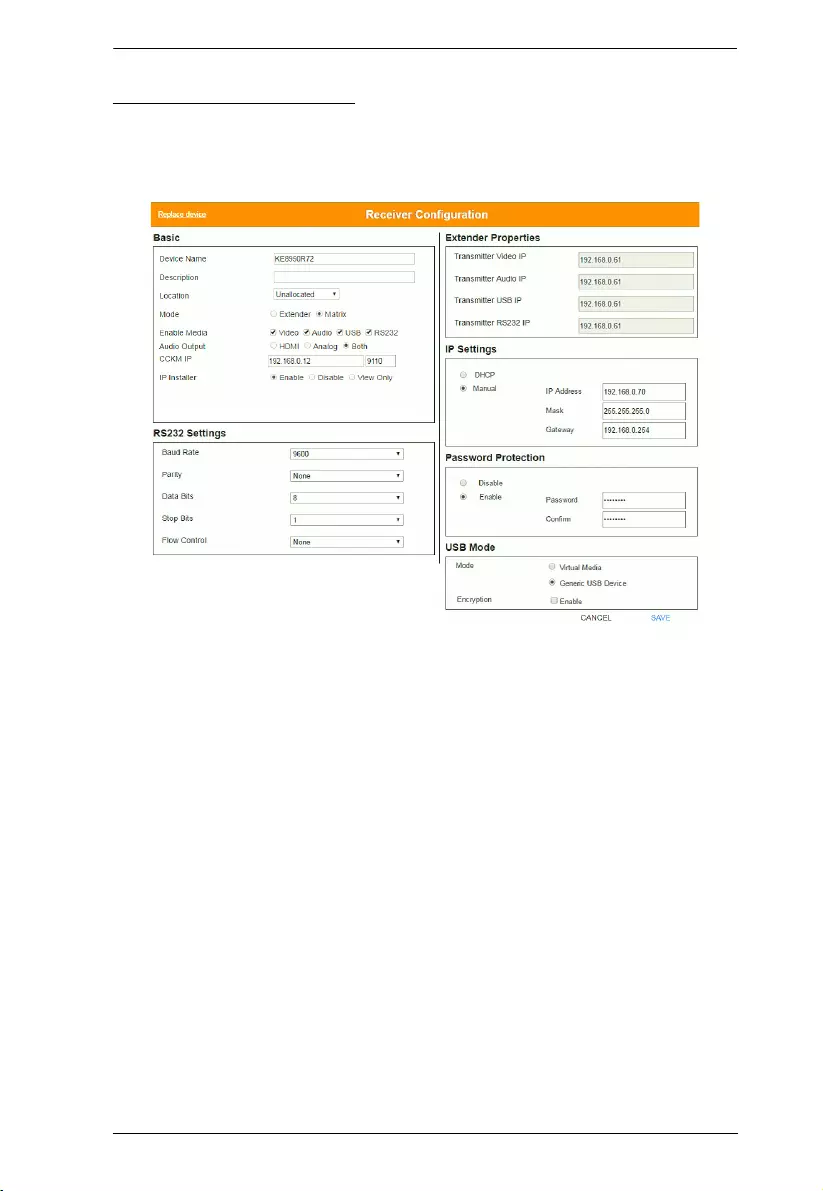
Chapter 6. System Status
175
Receiver Configuration
When the KE Matrix Manager discovers Receivers on the network they appear
on the Receiver settings page. Double-click a Transmitter to configure its
settings.

KVM over IP Matrix System User Manual
176
Item Description
Basic Device Name: Enter a name for the Receiver.
Description: Enter a description for the Receiver.
Location: Use the drop-down menu to select a Location for the
device. Locations help organize how you view Receivers on the
settings page.
Mode: Use the radio button to select how the Receivers will be
installed and managed:
Select Extender mode for simple one-to-one (Transmitter to
Receiver) setups that are managed with the Receiver’s OSD
menu.
Select Matrix mode to manage devices and connections over
the LAN from the KE Matrix Manager software. This mode is for
advanced administration of Transmitter and Receiver
connections configured within the KE Matrix Manager Web GUI.
Enable Media: Select which source type the Receiver can stream:
Video, Audio, USB and RS232.
Audio Output: Use this option to independently stream HDMI,
Analog, or Both audio signals to digital or analog audio output
devices (speakers) connected to the Receiver.*
CCKM IP: Set the IP address and Port number of the computer
running the KE Matrix Manager software. The default port number
is 9110.
IP Installer: The IP Installer is an external Windows-based utility
for assigning an IP address to the device. Click a radio button to
select Enable, Disable or View Only for the IP Installer utility.
See IP Installer, page 293 for instructions.
Note: The Audio Output option is only available on KE devices with
HDMI capabilities.
RS232 Settings Configure the serial device settings for the Transmitter. The default
settings are:
Baud Rate: 9600
Parity: None
Data Bits: 8 bits
Stop bits: 1 bit
Flow Control: None
Extender
Properties
If you selected Extender mode (under Basic) set the Transmitter IP
address for the Receiver’s Video, Audio, USB, and RS232 source.
If you selected Matrix mode (under Basic) the Properties will be
grayed out. Use Transmitters, Virtual Transmitters, and Transmitter
Groups to configure the connections (see Transmitter, page 160).

Chapter 6. System Status
177
IP Settings For dynamic IP address assignment, select the DHCP radio button.
To specify a fixed IP Address, Subnet Mask, and Default Gateway
select the Manual radio button and fill in the fields with values
appropriate for your network.
For information to configure the network settings locally on the
device, see Network Configuration, page 98.
Password
Protection
Select Enable to require a password to access the Receiver’s OSD
configuration screen (see page 104).
Enter a Password, and confirm the password in the Confirm box.
USB Mode Select the type of USB device you will connect to the USB ports:
Virtual Media: Select this option only if you are plugging a USB
disk drive (including USB HDD/optical disk) into the USB ports.
This will give you the highest data transfer speeds but will not allow
other USB devices to work when plugged into the USB ports. When
Receivers connected to the same transmitter mount or unmount
USB disk drives, the keyboard and mouse operations will
experience a brief delay. Transmitters can support up to 12 virtual
media connections at the same time (keyboard/mouse included).
vUSB (Generic USB device): Use this option to plug USB
peripherals* into the USB ports. This option also allows a keyboard
and mouse with special functions to plug into the USB ports for
console use. Use this only if the special functions of the keyboard
or mouse are required but do not work when plugged into the
console ports. When the keyboard and mouse are plugged into the
USB ports, they will not work within the OSD menus. To work within
the OSD menus, the keyboard and mouse must be plugged into
the console ports. KE6900ST/KE8900ST/KE9900ST transmitters
do not support the Generic USB Device mode. In this mode,
KE6900/KE6940 transmitters supports up to 2 USB connections;
and KE8950/KE8952 transmitters support up to 5 USB connections
(keyboard/mouse excluded).
Encryption: Check this box to encrypt USB disk drives plugged
into the USB ports.
Note: This USB port does not support isochronous endpoints,
therefore USB peripherals that stream audio or video data, such as
speakers or webcams, will not work.
Item Description

KVM over IP Matrix System User Manual
178
Replace Device Click Replace Device in the top left corner to replace an old
Receiver with a new one.* All settings are copied from the old
Receiver to the new Receiver. Before using this feature, connect
the new Receiver to the network. After clicking Replace Device,
use the drop-down menu to select the new Receiver where the
settings will be applied.
Note:
1. This option only appears when a Transmitter is offline.
2. This feature can be used for both Receivers and
Transmitters. Replacement should be carried out on a
similar model.
Save Click Save to save changes to the properties.
Cancel Click Cancel to exit without saving.
Item Description
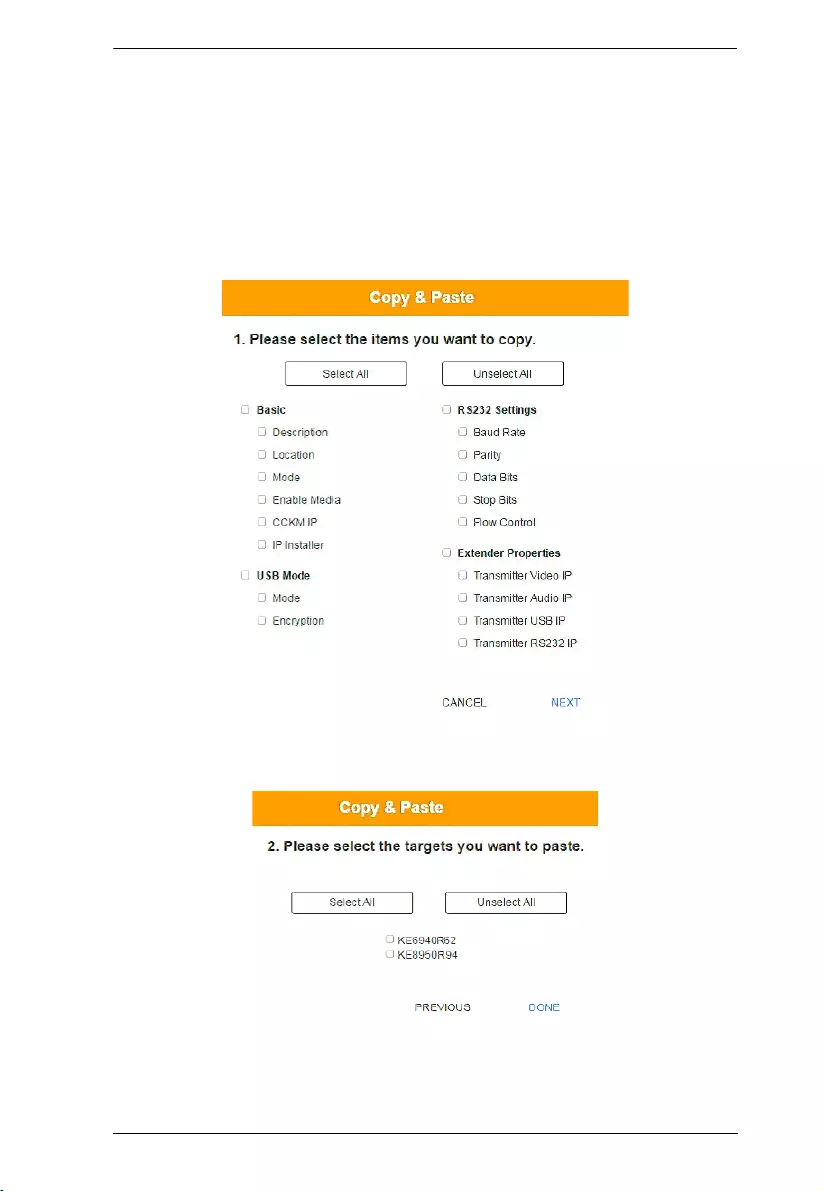
Chapter 6. System Status
179
Copy & Paste
Copy & Paste allows you to copy settings from one Receiver and paste them
to another. To copy Receiver settings to another device, do the following:
1. Select a Physical Receiver.
2. On the Receiver menu bar, click Copy & Paste (page 174).
3. Check the boxes of the settings you want to copy, and click Next.
4. Select the Receiver(s) where you want to apply the settings, and click
Done.

KVM over IP Matrix System User Manual
180
Receiver Group
Creating a Receiver Group allows you to connect the video from multiple
transmitters to multiple Receiver displays. To use this feature, connect a
Transmitter Group (page 170) to a Receiver Group (see Instant Link,
page 149). Receiver Groups appear at the bottom of the Receiver settings page.
To create a Receiver Group, in Receiver settings, click and then select
Create RX Group.
Fill in the appropriate information and then double-click or drag-and-drop
Receivers to add or remove them in the top panel. The Receivers in the top
panel will be used to view the video from the Transmitter Group. To connect a
Transmitter Group to a Receiver Group, see Instant Link, page 149.
Item Description
Name Enter a name for the Receiver Group.
Description Enter a description for the Receiver Group.
Location Use the drop-down menu to select a location for the
Receiver Group or leave it Unallocated. See Location,
page 160, for details.
Boundless Switching Use the radio button to enable or disable Boundless
Switching. See Boundless Switching, page 183 for
details.
Save Click Save to save the changes.
Cancel Click Cancel to exit without saving.
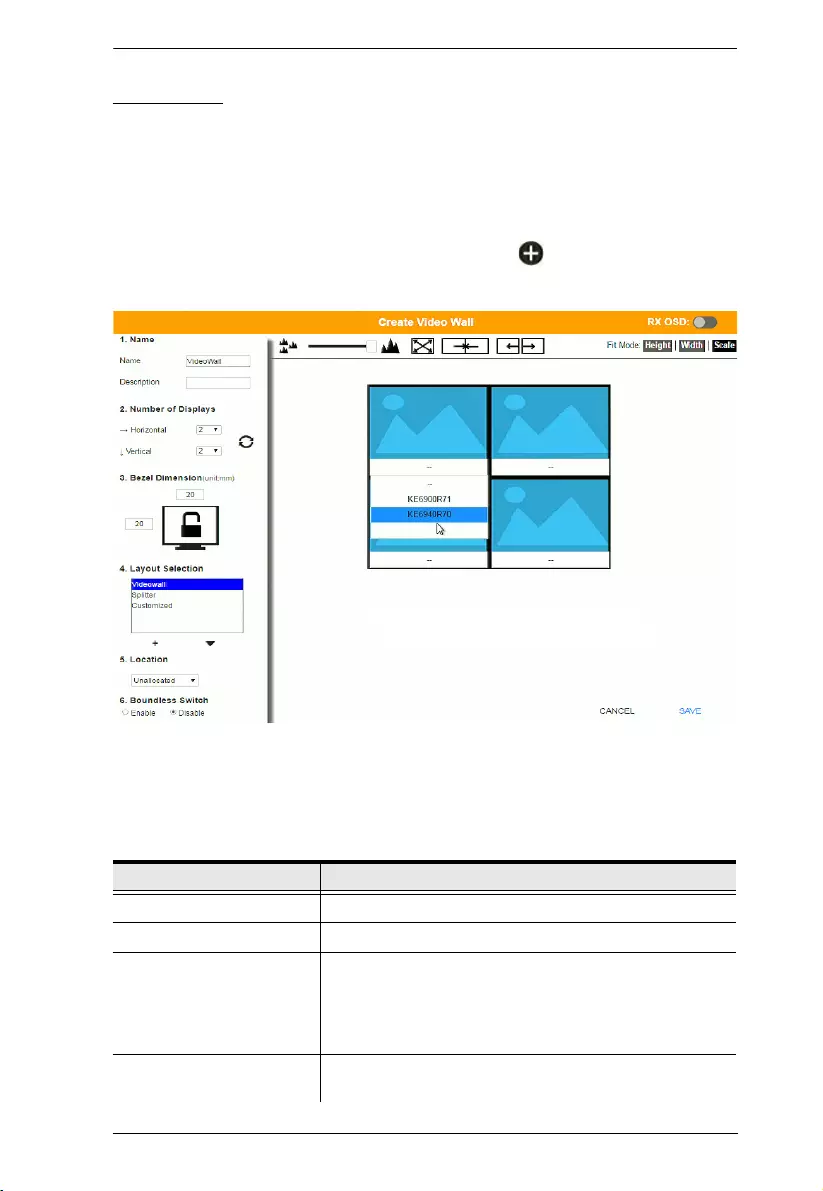
Chapter 6. System Status
181
Video Wall
Creating a Video Wall allows you to create connections that combine Receiver
displays to form a large video wall. Use the options to group multiple Receivers
in the video wall. A video wall can contain multiple forms of single displays
and grouped displays in various layouts. Video Walls appear listed below
Receivers, on the Receivers settings page.
To create a Video Wall, in Receiver settings, click and then select Create
Video Wall.
Select the number of displays and then group multiple displays to form large
screens and/or use single displays for independent screens to create the video
wall's layout. Click the bar -- under the display icon to select a Receiver for
each display. This configuration should match the actual video wall layout.
Item Description
Name Enter a name for the Video Wall.
Description Enter a description for the Video Wall.
Number of Displays Use the Horizontal and Vertical drop-down menus to
select the number of displays that make up the video wall
(a maximum of 64 are supported). Match this to the
physical layout of the displays. Click the refresh icon to
update the layout.
Bezel Dimension Use the two boxes to increase/decrease the frame size of
each active display.

KVM over IP Matrix System User Manual
182
Lock / Unlock Click the monitor to Lock the (2) bezel settings, so that
when one size is changed they all change.
Click the monitor to Unlock the (2) bezel settings, so that
each size can be set independently.
Layout Selection Click + or X to add or remove additional layouts to the
Video Wall. The options listed here will appear in a drop-
down menu for the Video Wall, allowing you to quickly
choose different layouts from the Receiver settings page.
Arrows below the Layout Selection box allow you to
move up or down in the list.
Three layout templates are available for quick setup. The
Videowall and Splitter options can not be changed but
allow you to select the Receivers. These three layouts
can not be deleted.
Video Wall provides a basic full screen layout where
one Transmitter connects to multiple Receivers to
display the video together as one full screen.
Splitter provides a layout that connects a Transmitter
to multiple Receivers that show the same video
displayed on separate screens independently.
Customized provides a basic full screen layout that
can be configured into groups (see Group below) as
desired.*
Note: When using the KE6940R in Customized layouts,
only the KE6940’s first video port will display video
because each port’s video source is independent. When
using the KE6940R in Video Wall or Splitter layouts both
video ports will display video.
Location Use the drop-down menu to select a location for the
Video Wall or leave it Unallocated. See Location,
page 160, for details.
Item Description

Chapter 6. System Status
183
Boundless Switching This options allows you to enable the Boundless
Switching feature* which allows you to move the mouse
cursor across the screen boundaries to switch (KVM
control) between different receivers. When the cursor
moves into a new screen the KVM control changes with
it. Select Enable to use Boundless Switching. This option
is disabled by default.
When Boundless Switching is enabled, you must disable
to following:
On the computer, under Control Panel - Mouse
Properties - Pointer Options, uncheck Enhance
pointer precision.
On the CCKM Main page, click Settings (page 199),
then on the General tab scroll down and disable Fast
Switching.
Note:
1. Dual Display Transmitters can be setup as two
independent Virtual Transmitters with
Boundless Switching. The placement of the
KE6940 setup must have DVI-1 as the main
display on the left and DVI-2 as a secondary
display on the right.
2. Boundless Switching only supports single or
dual video outputs from any one computer.
Use the slide bar to zoom in or out for a better view of the
Video Wall layout.
Click this icon to reset the zoom back to full size.
Select multiple display icons and click the Group button
to group the displays into one screen.
Select a group and click Ungroup to ungroup the
displays.
Fit Mode Select how the video wall will be displayed:
Height: Fits the video to the height of the display.
Width: Fits the video to the width of the display.
Scale: Fits the video on the entire display.
Use the RX OSD button to enable/disable showing the
Receiver’s name and IP address in the top left corner of
the connected display. This helps identify which Receiver
is connected to the display.
Save Click Save to save the changes.
Cancel Click Cancel to exit without saving.
Item Description
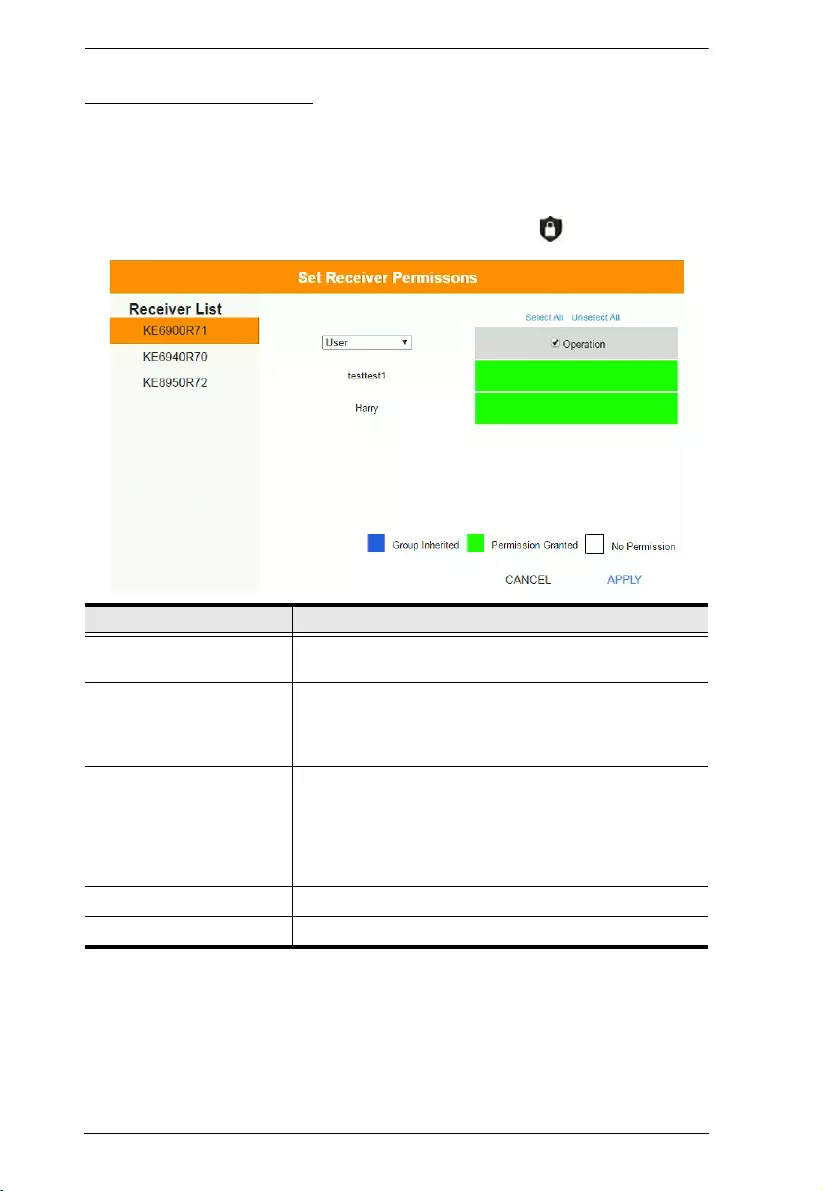
KVM over IP Matrix System User Manual
184
Receiver Permissions
Receiver Permissions sets which users and groups can access a Receiver.
Select a device under the Receiver List, and then click under Operation to
grant a user or group permission to access the device. This will allow the user
to login to the Receiver’s OSD menu to access the Connections tab.
To set Receiver Permissions, in Receiver settings, click .
Item Description
Receiver List Lists the Receivers which can be selected to set
permissions.
Drop-Down Menu Use the drop-down menu to select User or Group. After
making a selection, the list of users or groups appears.
Set permissions by selecting the Operation box next to
each user or group.
Operation Click the Operation box next to each user or group to
apply access rights on the selected device. This gives
users and groups permission to log in to the Receiver’s
OSD. If a user inherits its permissions from a group, the
box will be Blue. To disable access rights for all users,
uncheck the box in the heading.
Apply Click Apply to save the changes.
Cancel Click Cancel to exit without saving.
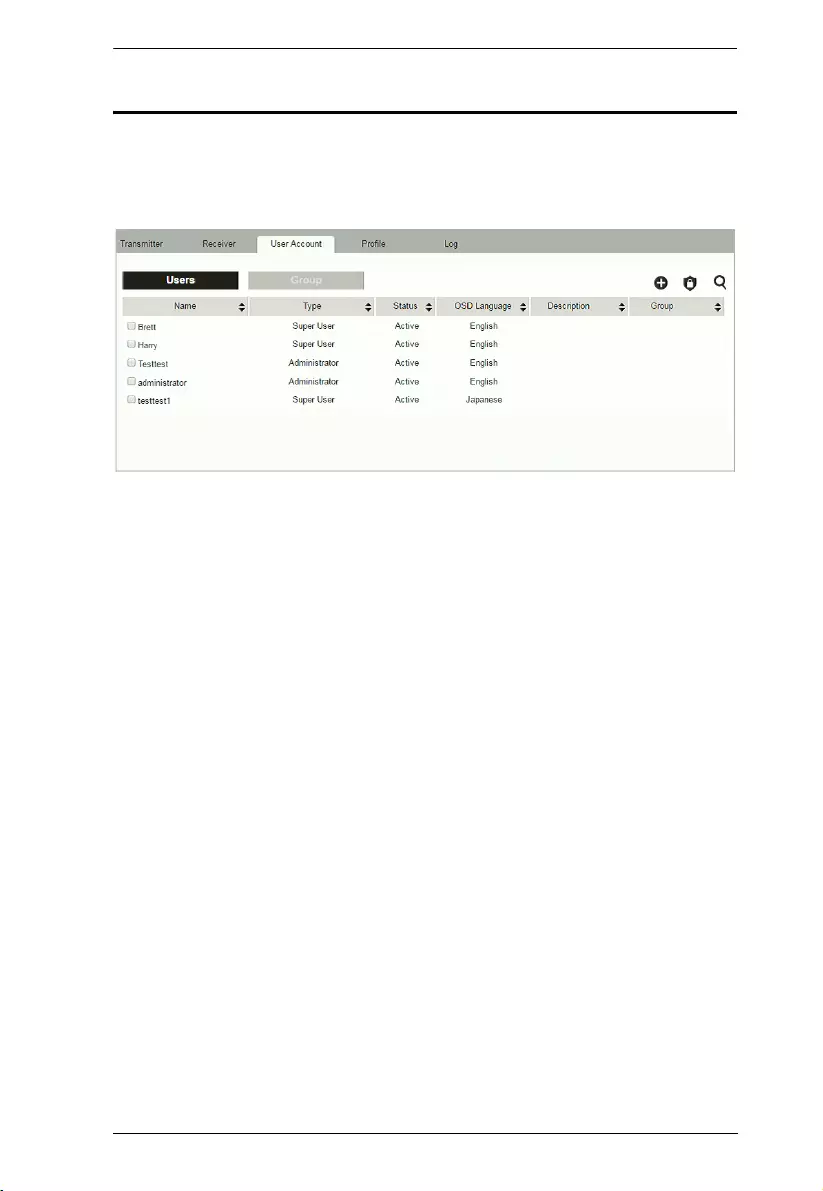
Chapter 6. System Status
185
Account
Click Users in the System Status panel to open the settings. The Account page
allows you to add, delete and configure users and groups. Instructions for
adding users and groups is provide on page 186.
The Users and Group buttons appear at the top of the page.
Depending on the item selected, either Users or Groups are listed on
the page.
The sort order of the information displayed can be changed by clicking the
column headings.
Three icons in the right corner are used to add users, groups and set
permissions, as explained in the sections that follow.
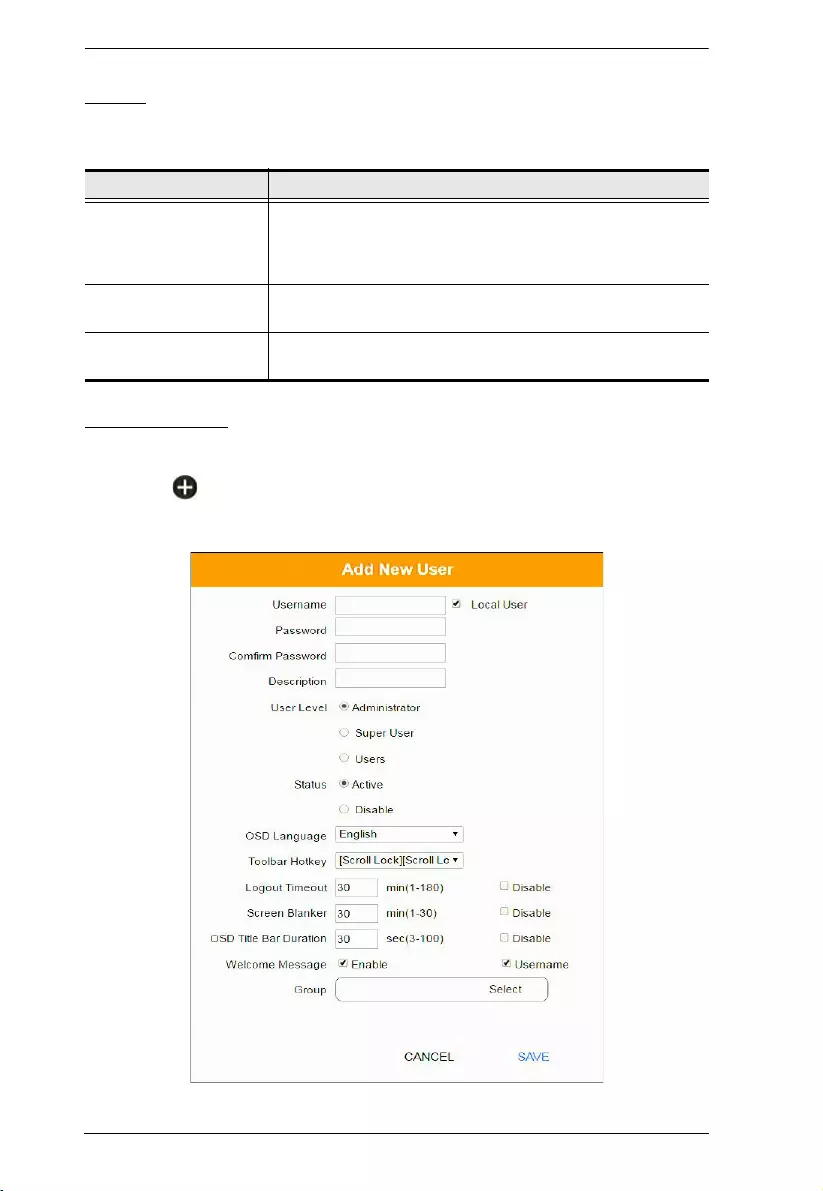
KVM over IP Matrix System User Manual
186
Users
The KE Matrix Manager supports three types of accounts, shown in the table
below:
Adding Users
To add a user, do the following:
1. Click on the menu bar.
2. Select Add New User. The Add New User window opens:
User Type Role
Administrator Access and management of the KE Matrix Manager,
including configuration and setting up of devices. Manage
Users, Groups, Transmitters, Receivers, Profiles and Video
Walls. Configure personal working environments.
Super User Access Receivers, Transmitters and Profiles they have been
given permission for.
User Access Receivers to connect to Transmitters they have been
given permission for.

Chapter 6. System Status
187
Enter the required information in the fields provided. A description of each
is given in the table below:
Field Description
Username From 1 to 32 characters are allowed depending on the Account
Policy settings.
Local User Check the Local User box if the account is for logging in to the
KE Matrix Manager software or a Receiver.
Uncheck the Local User box if the account is authenticated with
a 3rd party external source, such as RADIUS, LDAP/AD, or
TACACS+. See ANMS, page 205 for details.
Password From 6 to 32 characters are allowed depending on the Account
Policy settings.
Confirm Password To be sure there is no mistake in the password, you are asked
to enter it again. The two entries must match.
Description Additional information about the user that you may wish to
include.
User Level There are three account categories: Administrator, Super User
and User.
The Administrators have full access to make changes within
the KE Matrix Manager software, which includes adding and
removing Transmitters, Receivers, accounts, preferences,
and configuration settings.
The Super Users have access to the Receiver’s OSD menu
and can connect Channels and Profiles.
The Users can log in to Receivers to connect channels.
Status Status allows you to control the user’s account and access, as
follows:
Active provides the user with access and permissions as
granted.
Disable lets you suspend a user’s account without actually
deleting it, so that it can be easily reinstated in the future.
OSD Language Click the drop-down menu to select the language you want to
use during OSD sessions for this user. Options are: Chinese
(Traditional), Simplified Chinese, Japanese, German, Korean,
Russian, French, Spanish, and Portuguese.
Toolbar Hotkey Select the hotkey combination to call the Tool Bar function for
this user. The Tool Bar is used when accessing the computer
from the Transmitter or Receiver side.
Logout Timeout If there is no user input for the amount of time set with this
function, the user is automatically logged out. A login is
necessary before the KE Matrix Manager can be accessed
again. The default is 30 minutes.
Screen Blanker Set how many minutes the device waits when a session is idle
before turning off the display.

KVM over IP Matrix System User Manual
188
3. When your selections have been made click Apply.
4. When the Operation Succeeded message appears, click OK.
5. The new user appears on the main panel.
The columns show the Username; User Level, Status, OSD Language,
Description; and Group.
Modifying Users
To modify a user, do the following:
1. In the main panel, double-click the user’s name.
2. In the Edit User page that comes up, make your changes, then click Apply.
Deleting Users
To delete a user, do the following:
1. In the main panel, check the box next to the user’s name.
2. Click .
3. Click OK.
OSD Title Bar
Duration
When the accessing a port, the top left-hand corner will show a
title bar displaying the access mode and the device name.
Select how long you wish the title bar is to be displayed for, or
check Disable to not show any title bar.
Welcome Message If you want the Welcome Message to appear on screen when
the user logs into the KE Matrix Manager, select Enable.
If you want the user's Screen Name to appear with the
Welcome Message, check the Username check box.
Group Click Select and check a box to add the user to a group.
Apply Click Apply to save the changes.
Cancel Click Cancel to exit without saving.
Field Description

Chapter 6. System Status
189
Groups
Groups allow administrators to easily and efficiently manage users and
devices. Since device access rights apply to anyone who is a member of the
group, administrators need only set them once for the group, instead of having
to set them for each user individually. Multiple groups can be defined to allow
some users access to specific devices, while restricting other users from
accessing them. Device permissions are discussed on page 191.
Adding Groups
To create a group, do the following:
1. Click Group on the Account page.
2. Click and then select Add New Group. The Add New Group
window opens:
3. Enter the required information in the appropriate fields. A description of
each of the fields is given in the table below:
4. At this point you can assign users to the group by clicking Edit.
5. When your selections have been made click Apply.
Field Description
Group Name A maximum of 32 characters is allowed.
Description Additional information about the user that you may
wish to include. A maximum of 32 characters is
allowed.
Member Lists the users that are currently in the group. To add
users, click the Edit button.

KVM over IP Matrix System User Manual
190
6. When the Operation Succeeded message appears, click OK.
7. The new group appears in the main panel.
The columns show the Group Name, Description and Members that are
in the group.
Repeat the above procedure to add additional groups.
Modifying Groups
To modify a group, do the following:
1. In the main panel, double-click the group’s name.
2. Make your changes, then click Apply.
Deleting Groups
To delete a group, do the following:
1. In the main panel, check the box next to the group’s name.
2. Click .
3. Click OK.
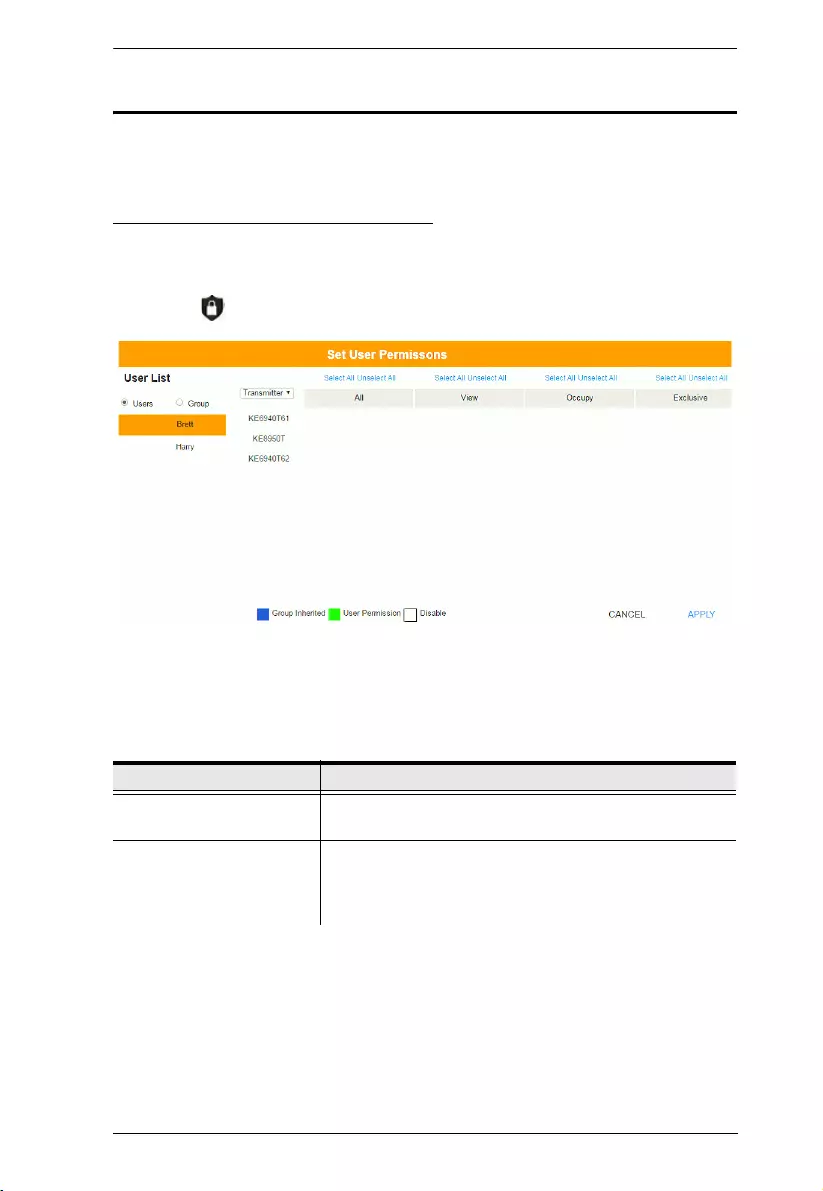
Chapter 6. System Status
191
Permissions
You can assign Transmitter, Receiver and Profile permissions for users and
groups from the Account page.
Assigning Device Permissions
To assign permissions for a user or group from the Account page, do the
following:
1. Click on the menu bar. The Set User Permissions window opens:
2. To set the permissions, select a user or group, then a device and select the
Access Type under each column so that it turns green. Make your
permission settings for each user or group on each device according to the
information provided below:
Item Description
User List Use the radio button to view the Users or Group list.
Click a user or group to configure their permissions.
Drop-Down Menu Use the drop-down menu to select Transmitter, Receiver
or Profile. After making a selection, a list of devices or
profiles appears. Set permissions by selecting the access
type (All, View, Occupy, Exclusive) next to the device.

KVM over IP Matrix System User Manual
192
3. When you have finished making your choices, click Apply.
4. In the confirmation popup that appears, click OK.
Access Type Select the access you want to grant to a user or group by
clicking under the heading(s) next to each device. This
defines how the device can be accessed by the user or
group. When granted, the access types (All, View,
Occupy, Exclusive) for Transmitters will appear available
for the user in the Receiver's OSD Connection page (see
page 121).
All: User has full control and can simultaneously share
control of the Transmitter. Input from the users is placed
in a queue and executed chronologically.
View: User can only view the remote screen, and cannot
perform operations on it.
Occupy: The first user to access the Transmitter has
control. However, additional users may view the
Transmitter’s video. If the user who controls the
Transmitter is inactive for longer than the time set in the
Transmitter’s Timeout box, control is transferred to the
first user to move the mouse or strike the keyboard.
Exclusive: The first user to access the Transmitter has
exclusive control over the Transmitter. No other users
can view the Transmitter. The Timeout function does not
apply when Transmitters are accessed with this setting.
Operation (Receiver and Profile): The Operation access
type for Receivers allows users to log into Receivers,
and for Profiles allows a user to connect the Profile from
a Receiver.
Apply Click Apply to save the changes.
Cancel Click Cancel to exit without saving.
Item Description
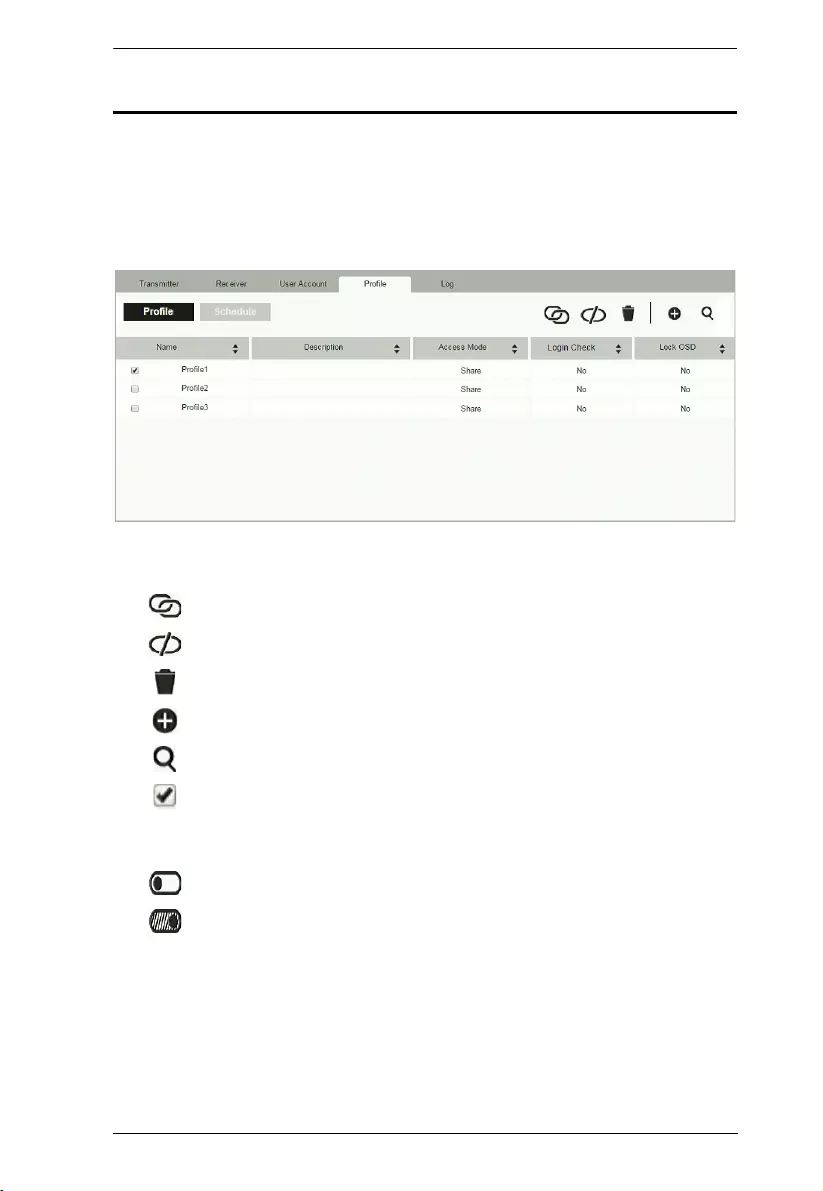
Chapter 6. System Status
193
Profile
Click Profile in the System Status panel to open the settings. The Profile page
allows you to create, run and schedule connection profiles. Profiles channel
specific Receiver to Transmitter connections and can be instantly connected
from the Profile page at anytime. Profiles can be also scheduled to run
automatically at specific times.
The meanings of the icons and headings on the page are straightforward and let
you view and configure Profiles.
Click to connect the selected Profile.
Click to disconnect the selected Profile.
Click to delete the selected Profile.
Click to Create Profile or Create Schedule (page 194 & 197).
Click and enter text to search for a Profile.
Check the box next to a Profile and click the Connect or Disconnect
icon to start/stop profile connections. Check the box next to a Schedule
and click the Enable or Disable icon to enable/disable a schedule.
Appears on the Schedule page, click to enable the selected schedule.
Appears on the Schedule page, click to disable the selected
schedule.
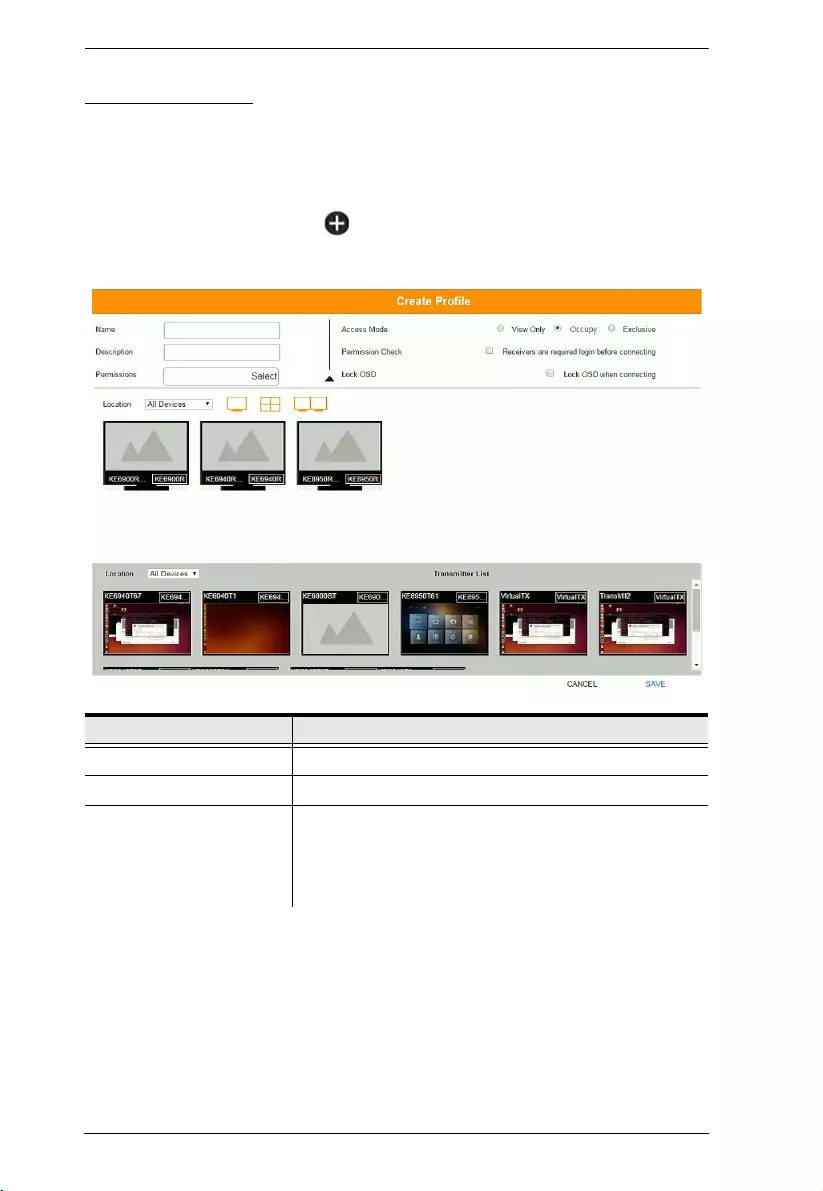
KVM over IP Matrix System User Manual
194
Adding a Profile
Creating a Profile allows you to quickly connect single or multiple Receiver to
Transmitter connections.
To add a Profile, do the following:
1. On the Profile page click and then select Create Profile. The Create
Profile window appears:
Item Description
Name Enter a name for the Profile.
Description Enter a description for the Profile.
Permissions Click Select and check the box of the users / groups you
want to allow to connect this Profile. When the user logs
into a Receiver, the profile will appear listed in the OSD
menu on the Profile page (see page 126), allowing them
to connect it.

Chapter 6. System Status
195
2. After filling in the information, click a Receiver, select Select TX and use
the drop-down menu select a Transmitter; or use Transmitter List at the
bottom of the page to drag-and-drop Transmitters to Receivers to create
the connection.
3. After configuring the connections, click Save. The new Profile appears on
the Profile page.
Access Mode This defines how the Transmitter in a Profile can be
accessed by Receivers when multiple users attempt to
access it.
View Only: Receivers only have view access to the
Transmitter’s video display.
Occupy: Set a time threshold for Receivers whose
Access Mode has been set to Occupy If there is no
activity from the Receiver occupying the port for the
amount of time set here, the Receiver is timed out and
the port is released. The first Receiver to send keyboard
or mouse input after the port has been released gets to
occupy the port. Input a value from 1 to 240 seconds.
Exclusive: The first Receiver to access the Transmitter
has exclusive control over the Transmitter. No other
users can view the Transmitter. The Timeout function
does not apply to Transmitters which have this setting.
Login Check Check this box to require a user to be logged in to the
Receiver before a Profile can connect it to a Transmitter.
When enabled, a user must be logged into the Receiver
or it will not connect to the Transmitter when the Profile is
initiated.
Lock OSD Checking this box will lock the Receiver’s OSD screen
when the Profile connects it to a Transmitter.
Location Use the drop-down menu to select a location to filter the
Receivers displayed on the page.
Click this icon to show individual Receivers.
Click this icon to show only video wall Receivers.
Click this icon to show only Receiver Group Receivers.
Save Click to save the changes.
Cancel Click to exit without saving.
Item Description

KVM over IP Matrix System User Manual
196
4. To connect Profiles, check the box of the Profile(s) you want to connect,
and click .
5. To disconnect Profiles, click .

Chapter 6. System Status
197
Adding a Schedule
Creating a Schedule allows you to connect Profiles at specific dates, times and
intervals.
To add a Schedule, do the following:
1. On the Profile page click .
2. Click and then select Create Schedule. The Create Schedule
window appears:
3. After the schedule is configured, click Save.
Item Description
Profile Use the drop-down menu to select a Profile to schedule.
Frequency Use the drop-down menu to select how often the Profile should run:
Once, Daily, Weekly and Monthly.
When you select Weekly/Monthly an additional drop-down menu
appears to select the Week Day/Month Day on which the profile will run.
Start Date Enter the date on which you want the schedule to begin running.
End Date Enter the date on which you want the schedule to stop running.
Start Time Enter the time of day that you want the profile to connect.
End Time Enter the time of day that you want the profile to disconnect.
Every If you select Daily, Monthly or Weekly, the Every option appears allowing
you to enter how often you want the schedule to run. For example, enter
3 months if you want the profile to run once every three months. If you
want to run the schedule once a day, once a week or once a month, use
the default entry of 1.
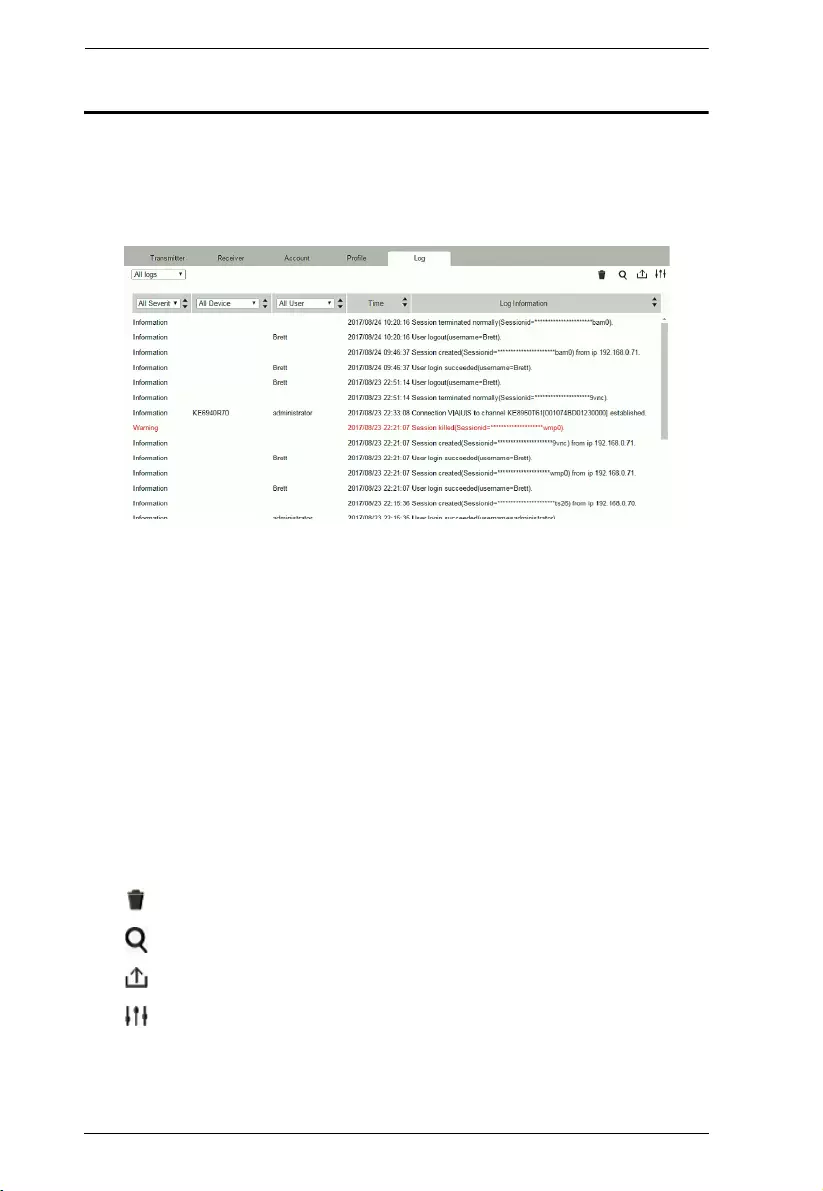
KVM over IP Matrix System User Manual
198
Log
Click Log in the System Status panel to open the settings. The Log page lists
events that take place and provides a breakdown of the time, user, severity,
device, and log information. You can change the sort order of the display by
clicking on the column headings.
Click the drop-down menu beside a heading to filter events into
subcategories. Selecting a subcategory allows you to view only the logs
that relate to the choice. The meanings of the headings at the top of the
page are straightforward:
All Severity refers to the event’s severity type: Information, Error, or
Warning
All Device refers to the Transmitter or Receiver that relates to the
event. If no device is listed the event refers to the KE Matrix Manager
software.
All User refers to the username that the event relates to. If no username
appears, the event is general system information.
Time refers to the date and time that the event occurred.
Log Information provides detailed information about each event.
Click to delete the logs currently displayed in the list.
Click and enter text to search for an event log.
Click to save the log contents to a file on your computer.
Click to open a pop-up window that allows you to set how many
days or the number of records to record before over-writing old log files.
Use the radio button to select By Period (Days) or By Records and enter
the number to use before overwriting the oldest log files.
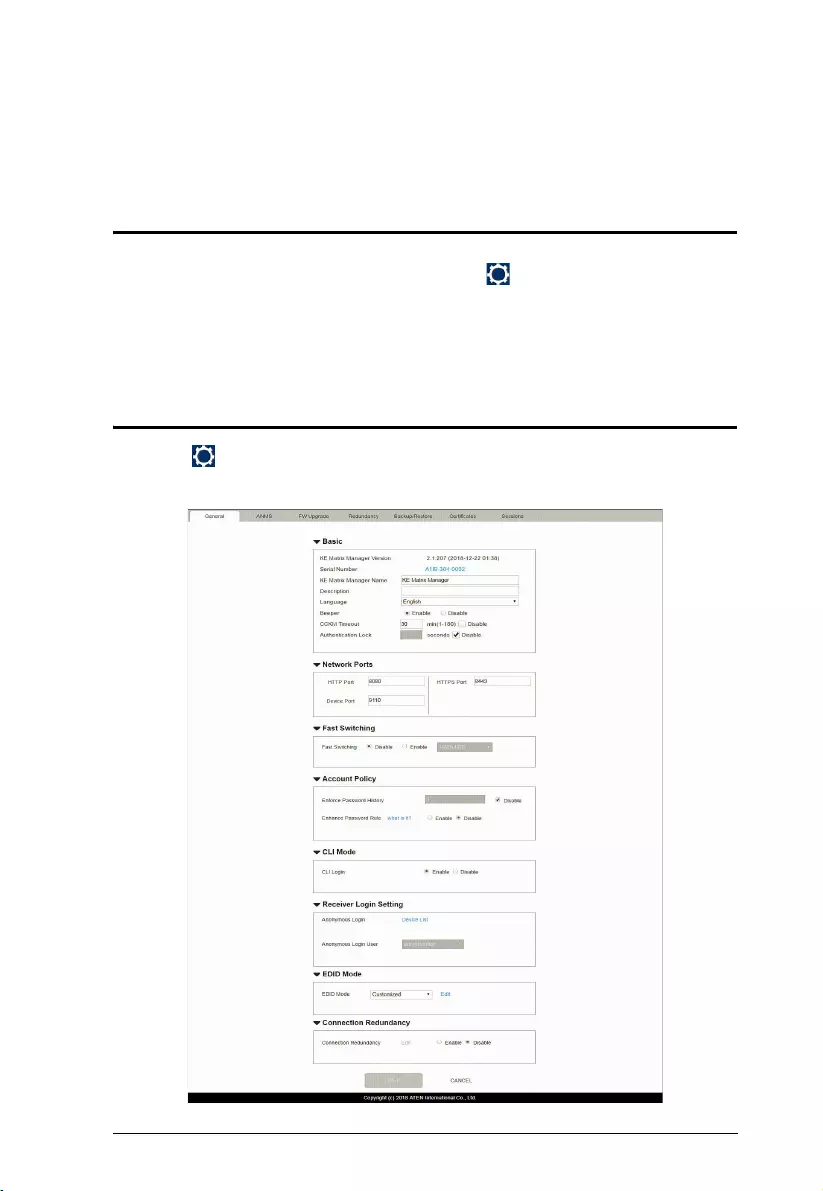
199
Chapter 7
System Settings
Overview
The System Settings are accessed by clicking from the System Status
page (see System Status, page 157). There are 7 tabs to configure the KE
Manager system settings: General, ANMS, FW Upgrade, Redundancy,
Backup/Restore, Certificates, and Sessions.
General
Clicking from the system status page opens the General tab, as shown
below:

KVM over IP Matrix System User Manual
200
Heading Item Description
Basic KE Manager Version This provides the version of the KE Manager
software.
Serial Number This provides the serial number and a link to
upgrade the software.
KE Manager Name Enter a name for the KE Manager.
Description Enter a description for the KE Manager.
Language Select the language for the KE Manager. Choices
are: English, Chinese (Traditional), Simplified
Chinese, Japanese, German, Korean, Russian,
French, Spanish, and Portuguese.
Beeper Select Enable to sound a beep from the
Transmitter/Receiver every time a configuration
change is made.
CCKM Timeout If there is no user input for the amount of time
entered in the box, a user logged into the CCKM
is automatically logged out. Check Disable to
turn this function off.
Authentication Lock When accidental power cut happens, the function
allows the user to retain his/her settings as was
shown before the power cut. The user keeps the
same authentication and display.
Uncheck Disable to turn this function on.
Specify a time (in seconds) you wish to keep
the authentication and display for.
When disabled or, if enabled, after the time
specified above, the manager will prompt you to
authenticate when you wish to access the KE
Manager.
Network
Ports
HTTP Port Sets the HTTP service port used to access the
KE Manager. This is the port number to use for a
browser login. The default is 8080.
Device Port Sets the Device service port used to access the
KE Manager. Configure this port number on the
Transmitter and Receiver to access to the KE
Manager software (see Manager Address,
page 116 and 108). The default is 9110.
HTTPS Port Sets the HTTPS service port used to access the
KE Manager. This is the port number to use for a
secure browser login. The default is 8443.
Example: To access the KE Manager with an IP
address of 192.168.0.100 using a secure browser
login, enter: https://192.168.0.100:8443

Chapter 7. System Settings
201
Fast Switching Select the default resolution to use so that you
can switch faster when changing Receiver to
Transmitter connections. If the monitor you are
using does not support fast switching the video
may not display correctly when this setting is
enabled.
Account
Policy
Enforce Password
History
This setting determines the number of unique
new passwords that must be used before an old
password can be reused. Uncheck the box and
enter a number to enforce the password history
policy.
Enhance Password
Rule
Select Enable to enforce rules for creating
passwords, as follows:
The password length must be at least 8 char-
acters.
The password must contain both upper and
lowercase characters.
The password must contain a number (0
through 9).
If a user types in the wrong password 5 times
consecutively, their account will be locked out
for 10 minutes.
CLI Mode CLI Mode Login Use the radio button to Enable or Disable
command line interface logins to the KE
Manager.
Warning: If Disable CLI Mode Login is selected,
anybody can login via Telnet with administrator
privileges without needing to authenticate,
allowing control of the entire installation. For
installations requiring a high level of security, it’s
recommended that Enable CLI Mode Login be
applied.
Receiver
Login
Settings
Anonymous Login Use this to anonymously login a user at select
Receivers. This option allows users to access the
Receiver and connect to Transmitters without
needing to login.
Click Device List to display the list and check the
box next to the Receiver(s) to enable the
Anonymous Login feature.
Anonymous Login
User
When Anonymous Login (above) is enabled for
Receivers, select a user from the drop-down
menu to use as the default account to
anonymously login to the Receiver.
Heading Item Description
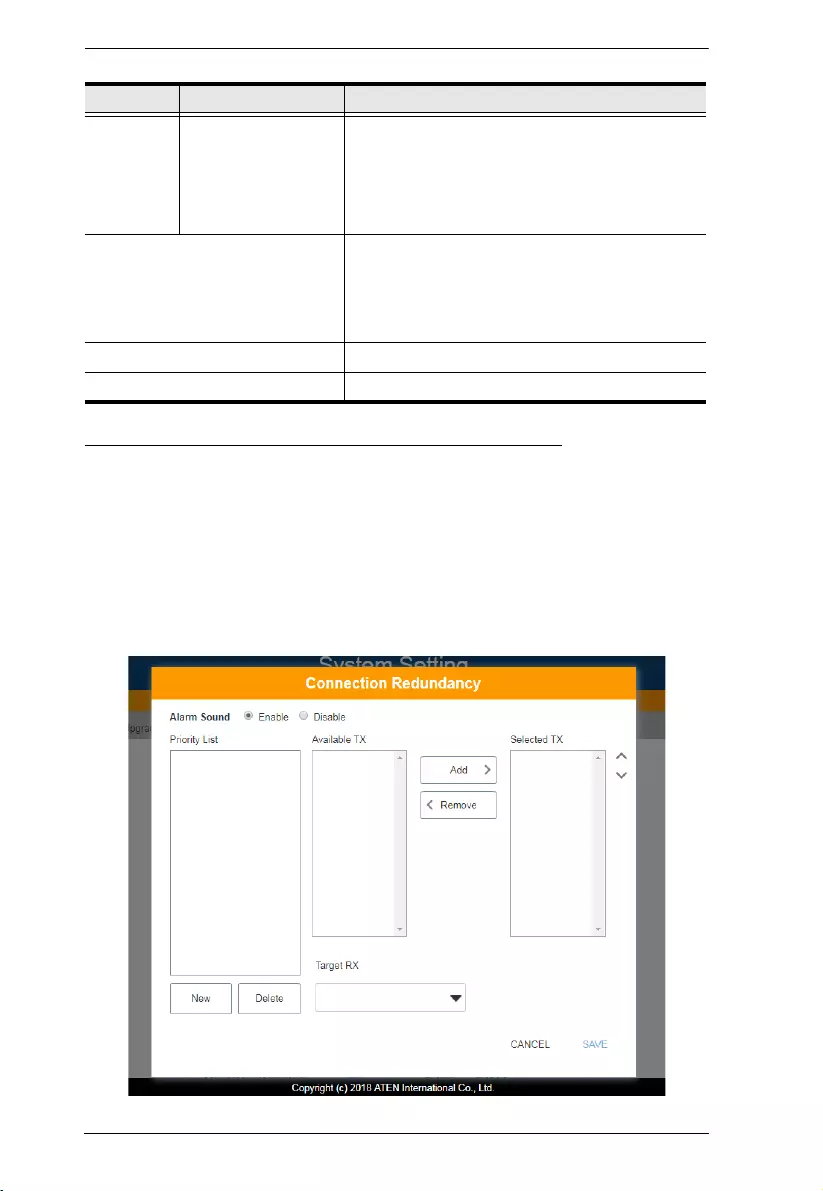
KVM over IP Matrix System User Manual
202
Connection Redundancy (KE6910 / 6912 only)
You can setup priority connection for receivers. Where a transmitter fails, this
function allows the receiver to connect to the transmitter of the highest priority
that is available.
Follow the steps below to setup the priority list.
1. Click Enable to enable this function.
2. Click Edit. A window will pop-up to allow editing.
EDID Mode EDID Mode Use this drop-down menu to set the default EDID
mode for all Transmitters. To set a different EDID
mode for each Transmitter, use the drop-down
menu to select Customized and then click Edit.
A Transmitter list will appear with drop-down
menus to configure each device’s EDID mode.
Connection Redundancy (KE6910
/ 6912 only)
Use this drop-down menu to set connection
redundancy function. You can setup priority
connection with this function.
Please refer to Connection Redundancy (KE6910
/ 6912 only) on page 202.
Save Click to save the changes.
Cancel Click to cancel the changes.
Heading Item Description
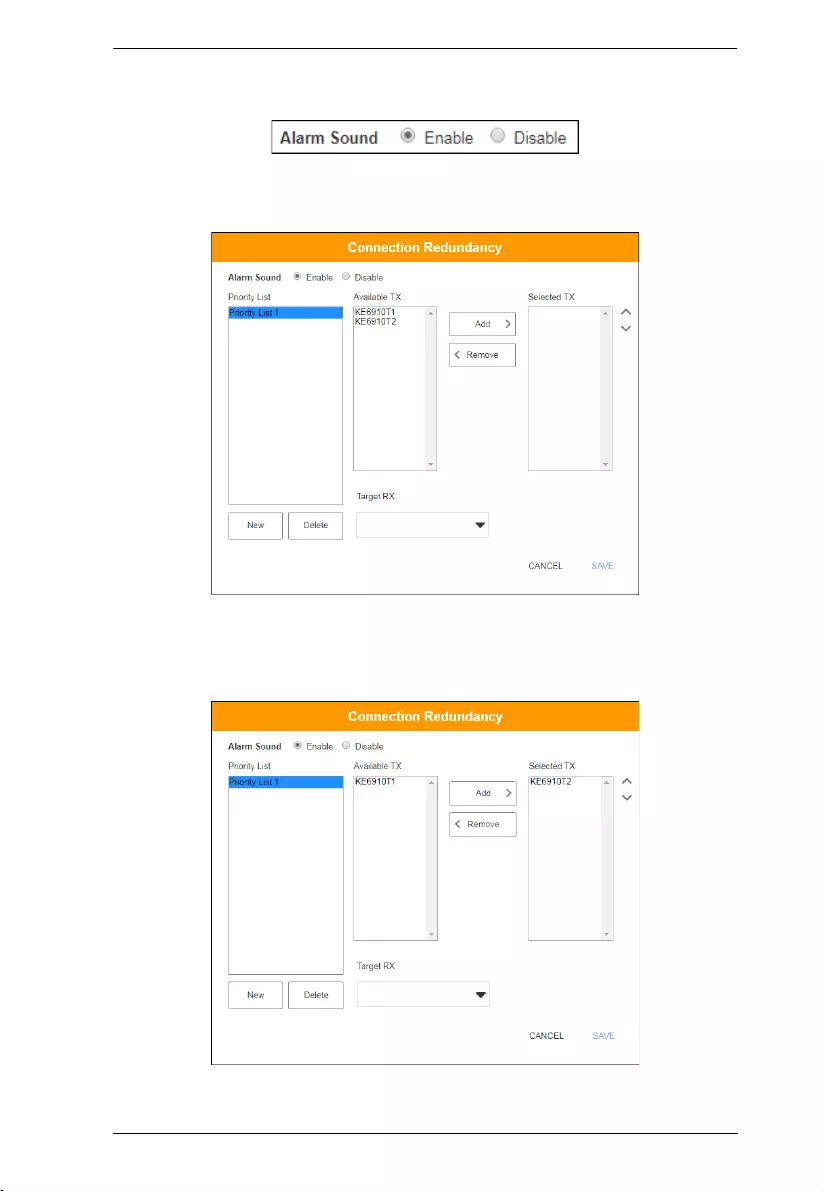
Chapter 7. System Settings
203
3. For Alarm Sound, click Enable.
4. To create a new list, click New. A Priority List 1 will be shown. (Click
New again to create another list.)
5. Select the transmitters you wish to be in the list from the “Available TX”
list and click Add. The added transmitter will be shifted to the “Selected
TX” list.
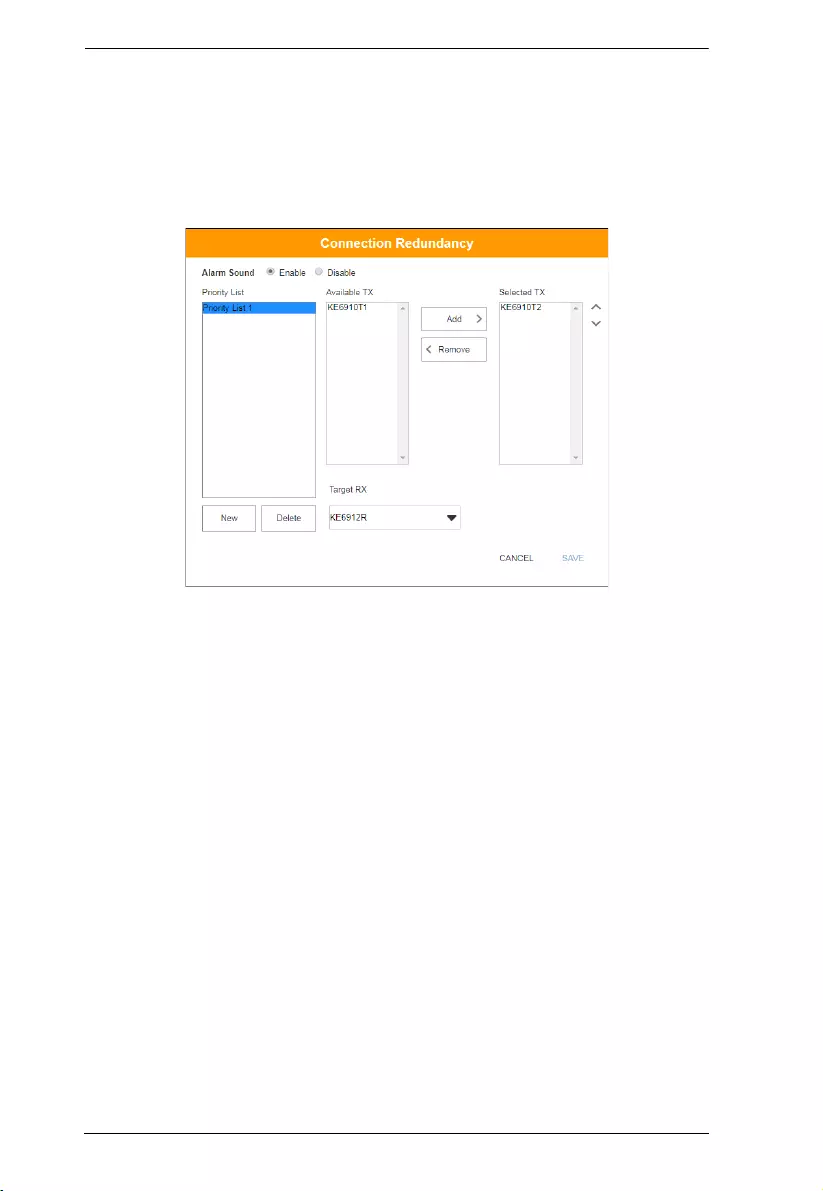
KVM over IP Matrix System User Manual
204
To deselect the transmitter, click to select the transmitter from the
“Selected TX” list and click Remove. The transmitter will be shifted back
to the “Available TX” list.
6. Select a target receiver by first clicking the drop-down menu “Target RX”,
and select a receiver.
7. Repeat steps 4-6 to add more priority lists.
8. Click Save to save the settings.
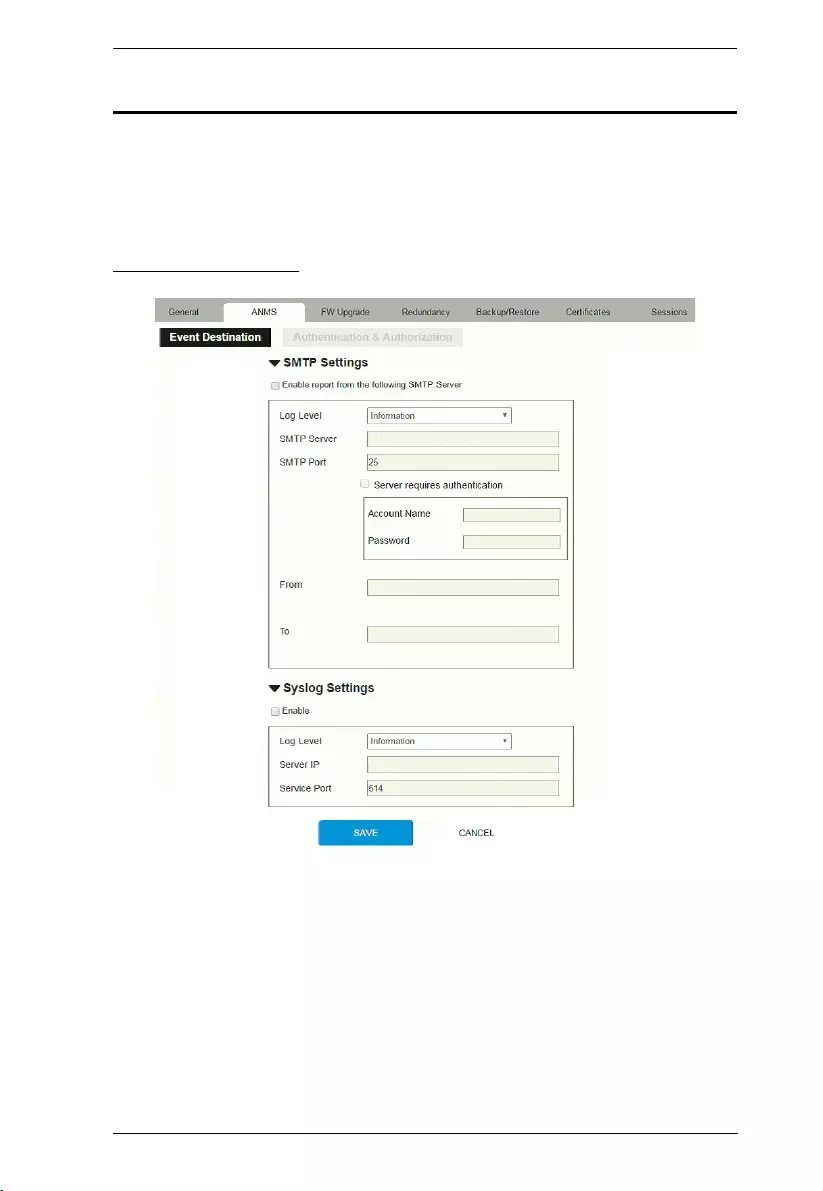
Chapter 7. System Settings
205
ANMS
The ANMS (Advanced Network Management Settings) tab is used to set up
login authentication and authorization management from external sources. It is
organized with two pages – each with a series of related panels, as described
below.
Event Destination
SMTP Settings
To have the KE Manager email reports from the SMTP server to you, do
the following:
1. Enable the Enable report from the following SMTP Server, select the
Log Level (Information, Warning, or Error), and key in the SMTP
Server IP address and SMTP Port.
2. If your server requires authentication, check the Server requires
authentication checkbox, and key in the appropriate information for the
Account Name and Password fields.

KVM over IP Matrix System User Manual
206
3. Key in the email address of where the report is being sent from in the
From field.
Note: 1. Only one email address is allowed in the From field, and it
cannot exceed 64 Bytes.
2. 1 Byte = 1 English alphanumeric character.
4. Key in the email address (addresses) of where you want the SMTP
reports sent to in the To field.
Note: If you are sending the report to more than one email address,
separate the addresses with a semicolon. The total cannot exceed
256 Bytes.
5. Click Save.
Syslog Settings
To record all the events that take place on the KE Manager and write them
to a Syslog server, do the following:
1. Check Enable.
2. Use the drop-down menu to select the Log Level (Information,
Warning, or Error).
3. Key in the Server IP address of the Syslog server.
4. Key in the Service Port number. The valid port range is 1-65535.
5. Click Save.

Chapter 7. System Settings
207
Authentication & Authorization
RADIUS Settings
To allow authentication and authorization through a RADIUS server, do
the following:
1. Check Enable.
2. Fill in the IP addresses and service port of the Preferred RADIUS
Server and Alternate RADIUS Server.
3. In the Timeout field, set the time in seconds that the KE Manager waits
for a RADIUS server reply before it times out.
4. In the Retries field, set the number of allowed retries.
5. In the Shared Secret field, key in the character string that you want to
use for authentication between the KE Manager and the RADIUS
Server. A minimum of 6 characters is required.
6. On the RADIUS server, Users can be authenticated with any of the
following methods:
Use the same Username on both the RADIUS server and the KE
Manager.
Use the same Group name on both the RADIUS server and the
KE Manager.
Use the same Username/Group name on both the RADIUS server
and the KE Manager.
In each case, the user’s access rights are the ones assigned that were
assigned when the User or Group was created on the KE Manager.
LDAP / AD Settings:

KVM over IP Matrix System User Manual
208
To allow authentication and authorization for the KE Manager via LDAP /
AD, refer to the information in the table, below:
On the LDAP / AD server, Users can be authenticated with any of the
following methods:
With MS Active Directory schema.
Item Action
Enable Put a check in the Enable checkbox to allow LDAP / AD
authentication and authorization.
Enable SSL Put a check in the Enable checkbox to allow SSL connections.
LDAP Server IP
and Port
Fill in the IP address and port number for the LDAP / AD server.
You can use the IPv4 address, the IPv6 address or the domain
name in the LDAP Server field.
For LDAP, the default port number is 389.
Timeout Set the time in seconds that the KE Manager waits for an LDAP /
AD server reply before it times out.
Admin DN Consult the LDAP / AD administrator to ascertain the appropriate
entry for this field. For example, the entry might look like this:
ou=kn4132,dc=aten,dc=com
Admin Name Key in the LDAP administrator’s username.
Password Key in the LDAP administrator’s password.
Search DN Set the distinguished name of the search base. This is the
domain name where the search starts for user names.

Chapter 7. System Settings
209
Note: If this method is used, the LDAP schema for MS Active Directory
must be extended. Without schema – Only the Usernames used on
the KE Manager are matched to the names on the LDAP / AD server.
User privileges are the same as the ones configured in the KE
Manager.
Without schema – Only the Usernames used on the KE Manager are
matched to the names on the LDAP server. User privileges are the
same as the ones configured in the KE Manager software.
Without schema – Only Groups in AD are matched. User privileges are
the ones configured for the groups he belongs to in the KE Manager.
Without schema – Usernames and Groups in AD are matched. User
privileges are the ones configured for the User and the Groups in the
KE Manager.
TACACS+ Settings:
Enable TACACS+ and enter the following information:
Preferred TACACS+ Server
Preferred TACACS+ Service Port
Shared Secret 1
Alternate TACACS+ Server
Alternate TACACS+ Service Port
Shared Secret 2
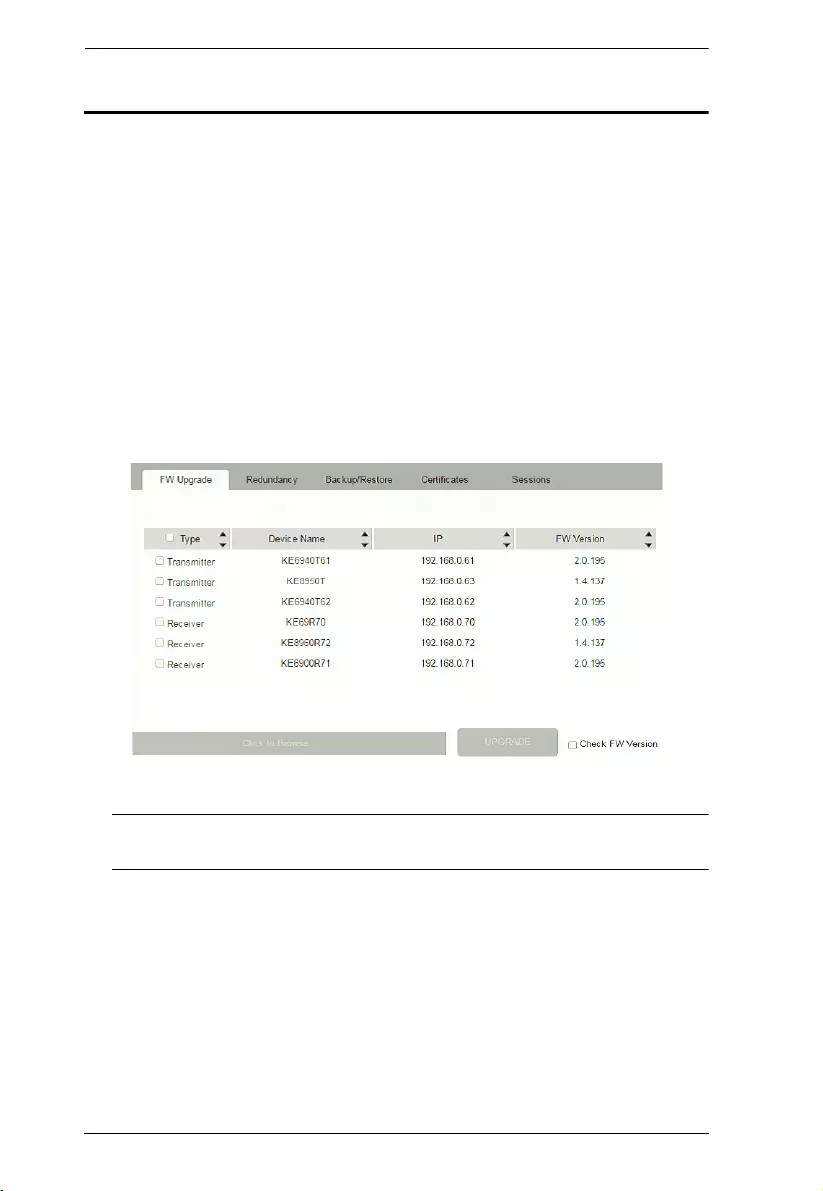
KVM over IP Matrix System User Manual
210
FW Upgrade
In FW Upgrade all KE devices that are online are listed, allowing you to select
which devices get upgraded. New firmware versions can be downloaded from
our website as they become available. Check the website regularly to find the
latest upgrade packages.
To upgrade the firmware do the following:
1. Go to our website and download the firmware upgrade package
appropriate to your KE device.
2. Open your browser and log in to the KE Manager with an administrator’s
account.
3. Click the Settings icon; select the FW Upgrade tab, the FW Upgrade
page appears:
All the devices that are capable of being upgraded are listed.
Note: Only online devices show up in the list. Offline devices do not get
upgraded.
4. Check the checkbox in front of the devices you want to upgrade. Uncheck
the devices that you do not want to upgrade.
5. Click Browse. Navigate to the directory where the firmware upgrade file
is located and select it.
6. Enable or disable Check FW Version
If you enabled Check FW Version the current firmware level is
compared with that of the upgrade file. If the current version is equal to

Chapter 7. System Settings
211
or higher than the upgrade version, a popup message appears, to inform
you of the situation and stops the upgrade procedure.
If you didn't enable Check FW Version, the upgrade file is installed
without checking what its level is.
If you cancel the firmware upgrade, you have to wait 12 seconds
before you can disable Check FW Version and restart the firmware
upgrade.
7. Click Upgrade to start the upgrade procedure. As the upgrade proceeds,
progress information is shown on the screen. Once the upgrade completes
successfully, the devices will reset.
8. Log in to each device and check the firmware version to be sure it is the
new one.
Firmware Upgrade Recovery
If the Upgrade Succeeded screen doesn't appear or the upgrade procedure is
abnormally halted (due to computer crash, power failure, etc.), the device may
become inoperable. If you find that the device does not work following a failed
or interrupted upgrade, do the following
1. Power off the KE device.
2. Press the Reset button, then power on the KE device while holding Reset.
3. Hold Reset for 7 seconds after the device is powered on.
4. The device will revert to a previous firmware version and recover from the
failure.
5. Upgrade the firmware to the most current version available.
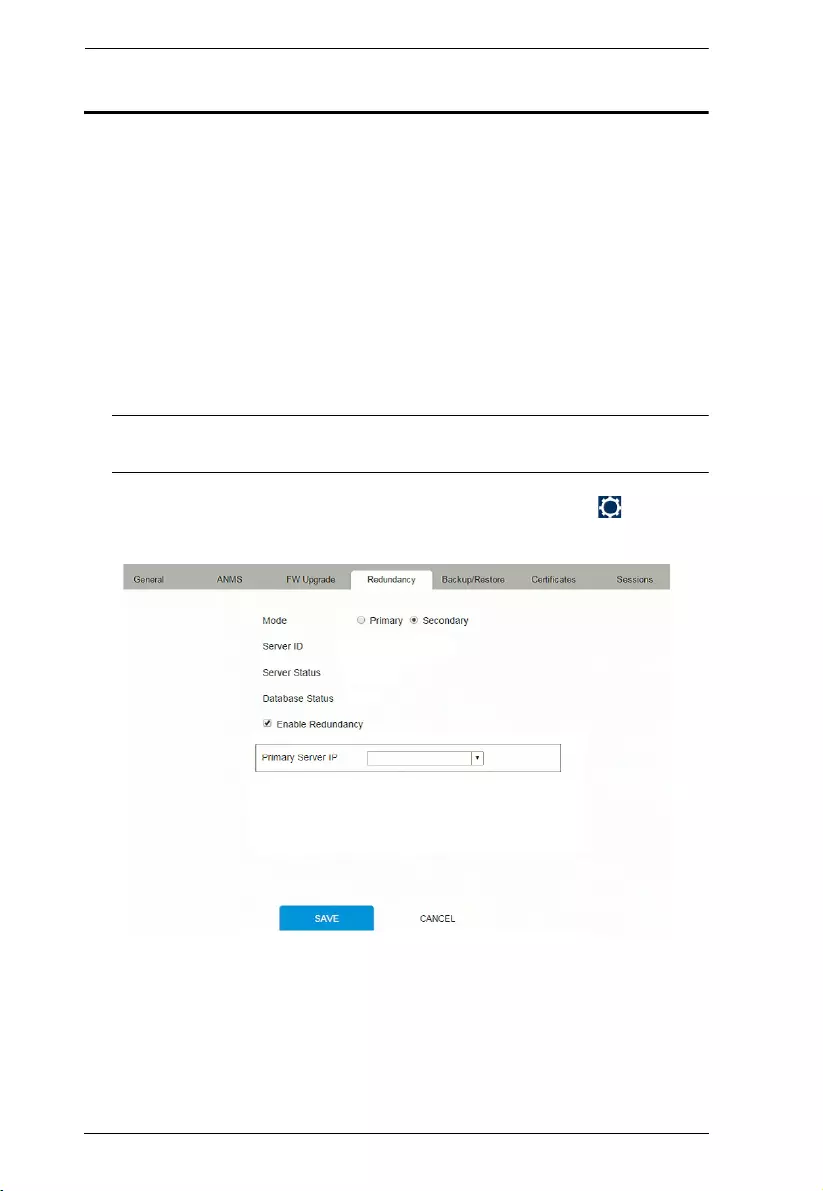
KVM over IP Matrix System User Manual
212
Redundancy
The Redundancy tab allows you to set up a backup computer in case the
computer hosting the KE Manager goes offline. If the KE Manager goes
offline, the secondary computer will automatically take over operations,
allowing all connections to continue without disruption – with only a brief
period of 30 seconds when new connections can't be started. When the primary
computer comes back online it retrieves the updated database from the
secondary computer and re-takes all KE Manager operations.
To set up Redundancy, do the following:
1. Install KE Manager on a secondary computer with a USB license key. For
detailed instructions, see page 135.
Note: A second USB license key is required if you have more than 8 KE
Series devices in your setup.
2. On the secondary computer, log in to the KE Manager, click and go to
the Redundancy tab.
3. Check Enable Redundancy and select the Secondary radio button.
4. Use the Primary Server IP drop-down menu to select the primary IP
address.
5. Click Save.
6. Redundancy is now running on the secondary computer.
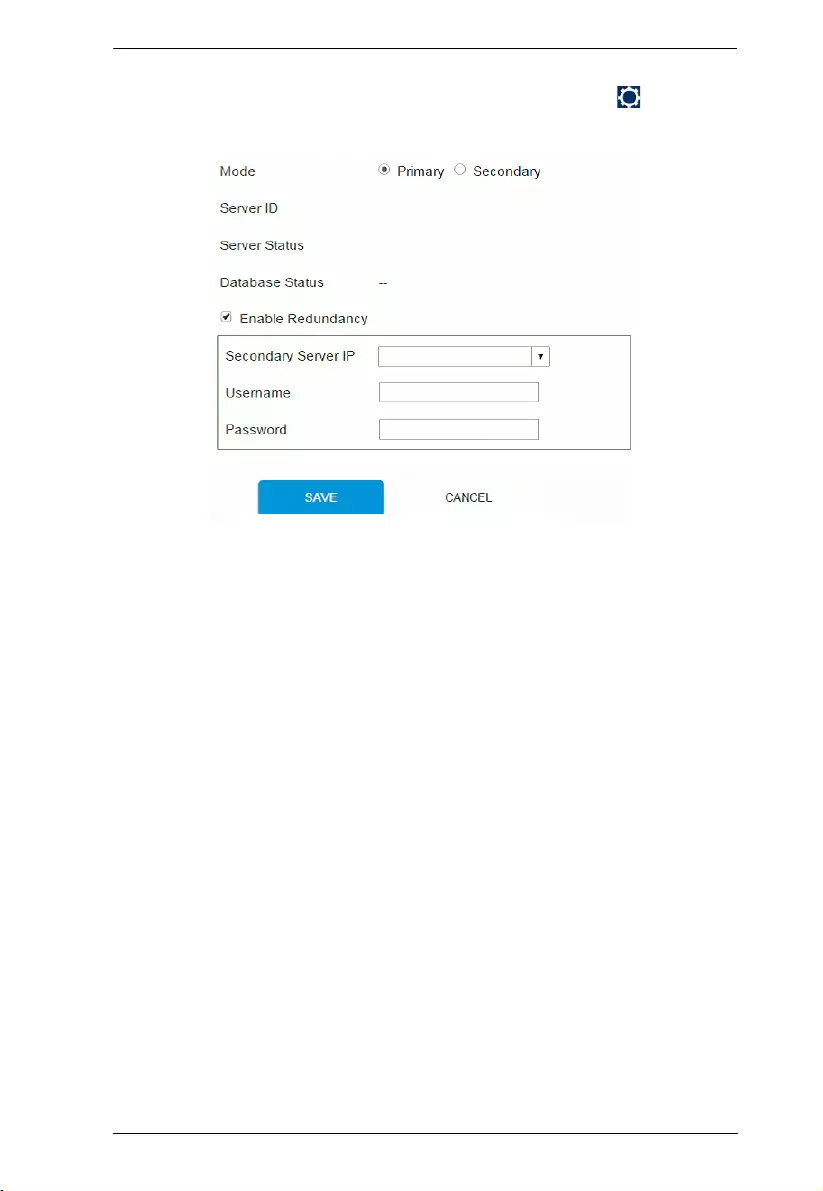
Chapter 7. System Settings
213
7. On the primary computer, log in to the KE Manager, click and go to
the Redundancy tab.
8. Check Enable Redundancy and select the Primary radio button.
9. Use the Secondary Server IP drop-down menu to select the secondary IP
address.
10. Enter the Username and Password of the secondary computer’s local
administrator account.
11. Click Save.
12. Information about the Redundancy status can be found in the event log
(see Log, page 198 for details).
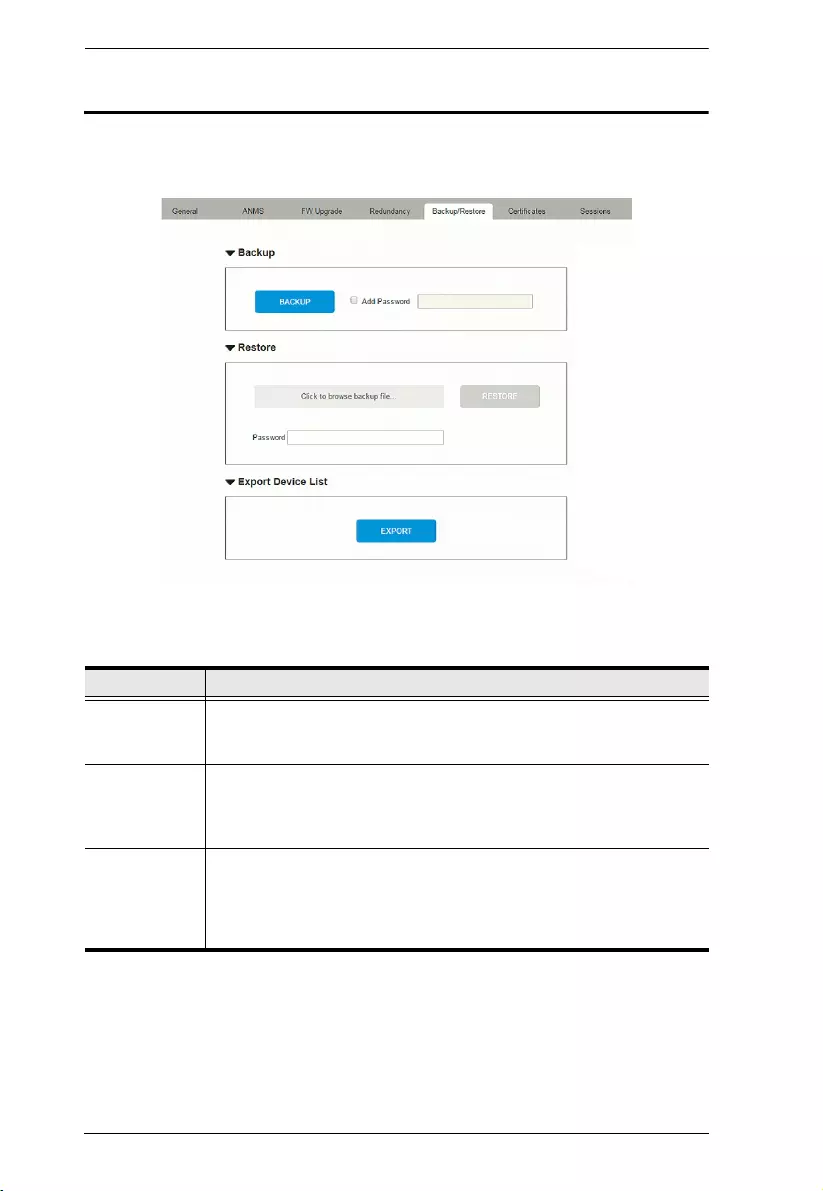
KVM over IP Matrix System User Manual
214
Backup / Restore
The Backup/Restore tab is divided into three panels: Backup, Restore, and
Export Device List:
The operations to perform backup/restore procedures are described in the table
below and in the section that follows:
Procedure Operation
Backup Backs up theKE Manager configuration – including Receiver,
Transmitter, Profile and Schedule configurations; user and group
accounts, user profiles, logs, and system settings.
Restore Deletes the current Receiver, Transmitter, Profile and Schedule
configurations; user and group accounts, user profiles, logs, and
system settings.; then restores those settings to the values that exist
in the previously saved backup file.
Export Device
List
Clicking Export allows you to save a file with a complete list of the
devices added to the KE Manager. The file contains the ID, Name,
Description and IP Address of each Transmitter and Receiver. An
Existing column also lists if the device is available: Yes, it exists and is
available, or No, it is offline or has been removed.

Chapter 7. System Settings
215
Backup
To back up system configuration settings, do the following:
1. (Optional) In the Backup panel, check Add Password, and provide a
password for the backup file.
Note: Providing a password is a security feature – if you provide a
password, you will need to give the same password in order to
restore the configuration settings from this file.
2. Click Backup.
3. In the dialog box that comes up, Click Save to save the configuration file
(System.conf) to a location on your hard disk.
4. Navigate to the directory where you want to save the file and click Save.
Restore
To restore system configuration settings, do the following:
1. In the Restore panel, click Browse.
2. Navigate to the directory where the backup file is located and select it.
3. When you return to the Backup/Restore page enter the password you set
when the backup file was created.
Note: If you did not set a password for the file, leave the field blank.
4. Click Restore.
5. Click OK to confirm that you want to restore the configuration data.
When the Restore procedure is in process, a message stating that the KE
Manager will restart will appear. After a short while the KE Manager
closes and refreshes at the log in screen. When it comes back up the
configuration settings that were restored from the backup file are in effect.
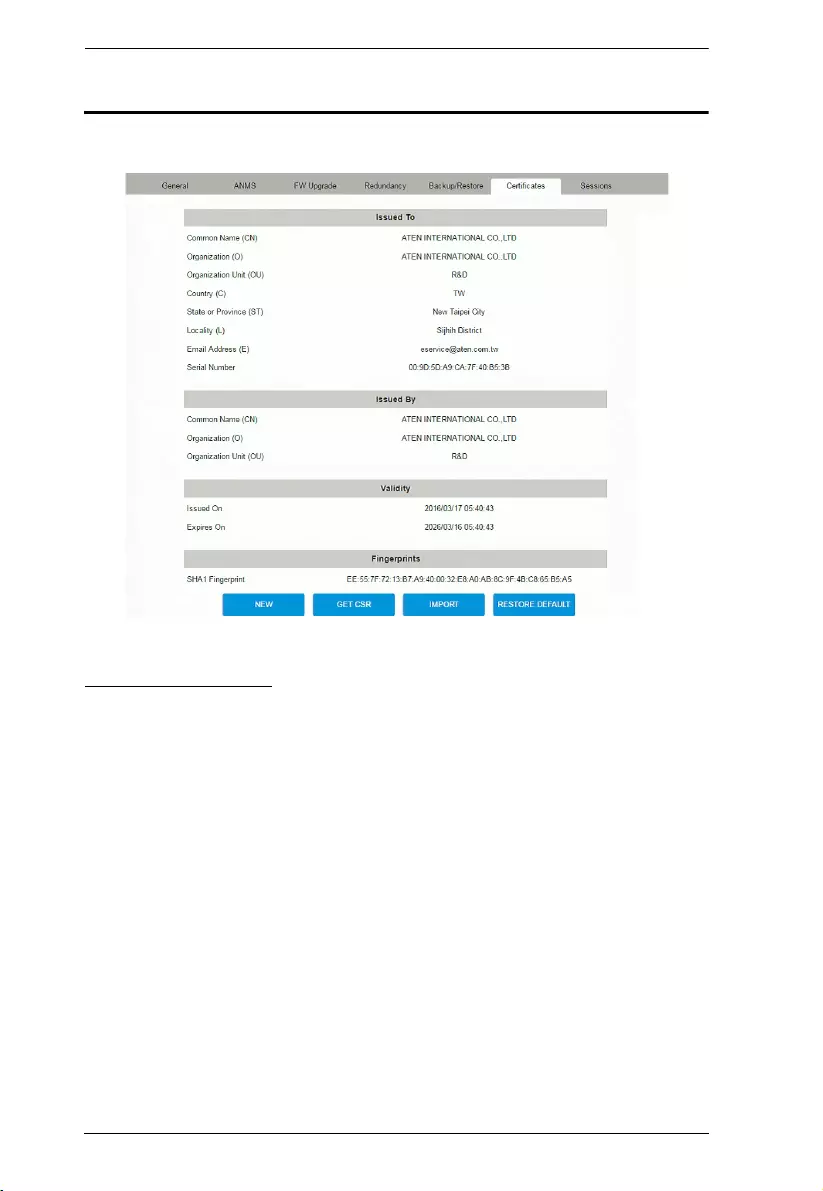
KVM over IP Matrix System User Manual
216
Certificates
This tab provides information about Private Certificates:
Private Certificate
When logging in over a secure (SSL) connection, a signed certificate is used to
verify that the user is logging in to the intended site. For enhanced security, the
Private Certificate section allows you to use your own private encryption key
and signed certificate, rather than the default ATEN certificate.
There are two methods for establishing your private certificate: generating a
self-signed certificate; and importing a third-party certificate authority (CA)
signed certificate.
Generating a Self-Signed Certificate
If you wish to create your own self-signed certificate, a free utility –
openssl.exe – is available for download over the web. See Self-Signed
Private Certificates, page 295 for details about using OpenSSL to generate
your own private key and SSL certificate.
Obtaining a CA Signed SSL Server Certificate
For the greatest security, we recommend using a third party certificate
authority (CA) signed certificate. To obtain a third party signed certificate,

Chapter 7. System Settings
217
go to a CA (Certificate Authority) website to apply for an SSL certificate.
After the CA sends you the certificate and private encryption key, save
them to a convenient location on your computer.
Importing the Private Certificate
To import the private certificate, do the following:
1. Click Import from the bottom of the Private Certificate page, shown here:
2. Click Browse to the right of Certificate Filename; and browse to where
your certificate file is located; and select it.
3. Click Import to complete the procedure.
Note: Clicking Restore Defaults returns the device to using the default ATEN
certificate.
Certificate Signing Request
The Certificate Signing Request (CSR) section provides an automated way of
obtaining and installing a CA signed SSL server certificate.
To perform this operation do the following:
1. Click New. The following dialog box appears:
2. Fill in the form – with entries that are valid for your site – according to the
example information in the following table:
Information Example
Country (2 letter code) TW

KVM over IP Matrix System User Manual
218
3. After filling in the form (all fields are required), click Create.
A self-signed certificate based on the information you just provided is now
stored on the KE Manager software.
4. Click Get CSR, and save the certificate file (csr.cer) to a convenient
location on your computer.
This is the file that you give to the third party CA to apply for their signed
SSL certificate.
5. After the CA sends you the certificate, save it to a convenient location on
your computer. Click Import to locate the file; then click Import to store
it on the KE Manager.
Note: When you upload the file, the KE Manager checks the file to make sure
the specified information still matches. If it does, the file is accepted; if
not, it is rejected.
If you want to remove the certificate (to replace it with a new one because of a
domain name change, for example), simply click Restore Defaults.
State or Province Taiwan
Locality Taipei
Organization Your Company, Ltd.
Organization Unit Tech Department
Common Name mycompany.com
Note: This must be the exact domain name of the site
that you want the certificate to be valid for. If the site’s
domain name is www.mycompany.com, and you only
specify mycompany.com, the certificate will not be valid.
Email Address administrator@yourcompany.com
Information Example
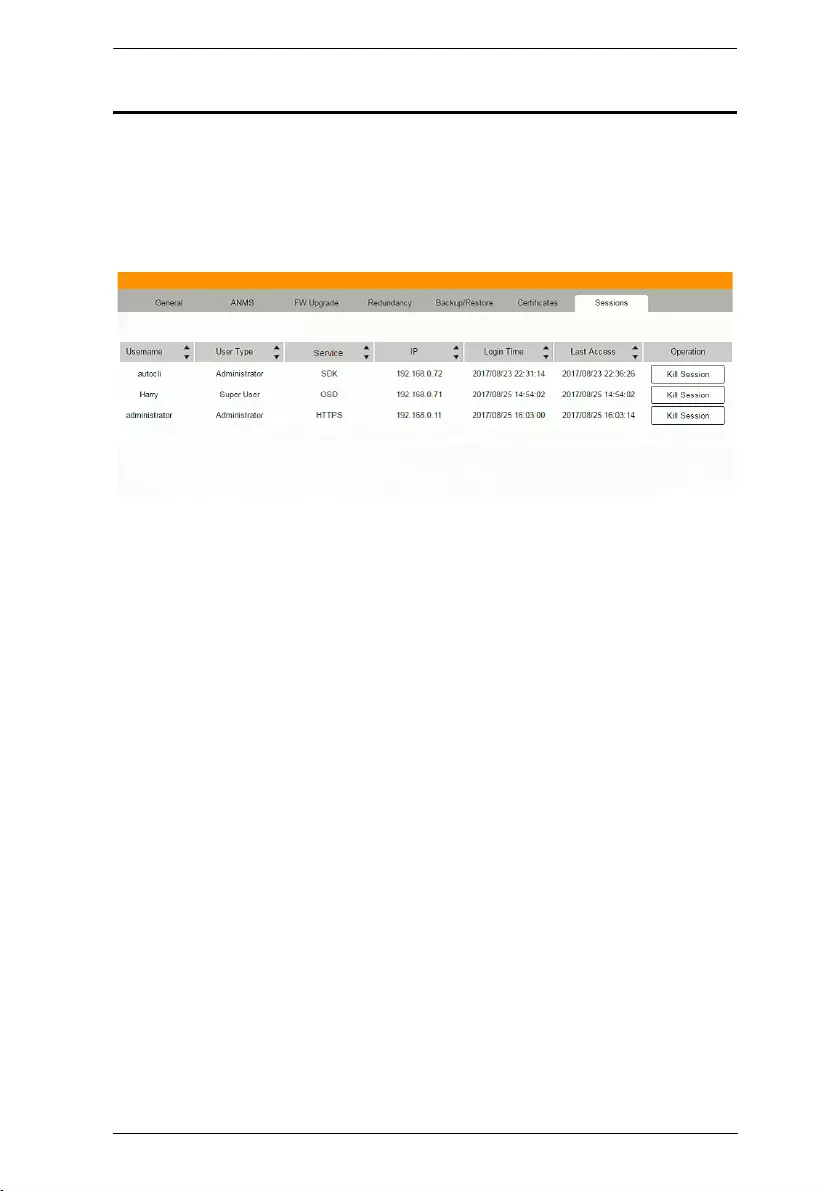
Chapter 7. System Settings
219
Sessions
The Sessions tab shows all of the users that are logged into KE Manager and
OSD sessions and provides information concerning the “who, where and
when” of each session. This page also gives the administrator the option of
forcing a user logout by selecting the user and clicking Kill Session next to
each user.
Username refers to the user that logged in to establish a session.
User Type refers to the account type of the user.
Service refers to how the user logged into their session – via KE Manager,
Command Line, or OSD.
IP refers to the IP address from which the user has logged in.
Login Time refers to the date/time that the user logged into the session.
Last Access refers to the last time the user session was active.
Operation provides the Kill Session button to force a user logout.

KVM over IP Matrix System User Manual
220
This Page Intentionally Left Blank
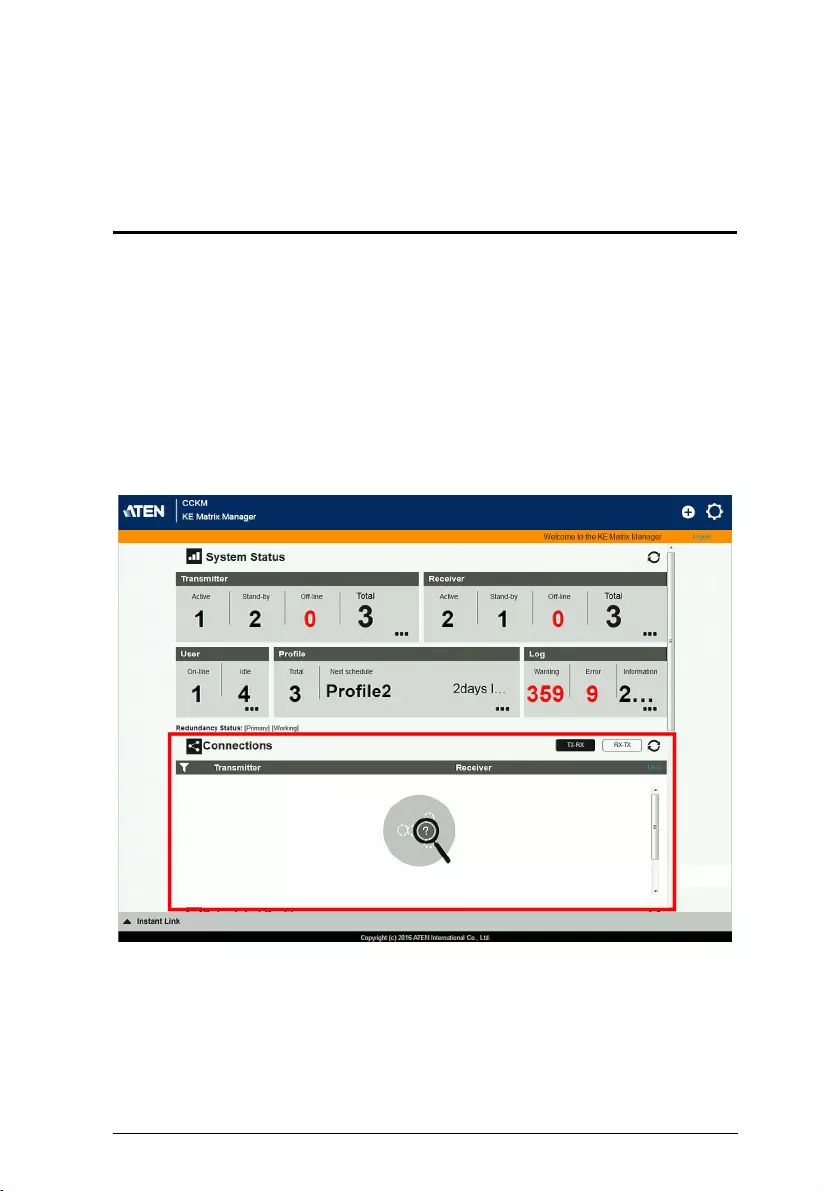
221
Chapter 8
Connections
Overview
The Connections panel is found on the KE Matrix Manager Main Page, just
below System Status. Connections provides a diagram of current Transmitter
to Receiver connections. Before connections are established the panel appears
blank, as shown below. To connect Receivers to Transmitters, use the Instant
Link panel (page 149), or create a connection Profile (page 193).
When connections are made, clicking a device in the left column provides a
way to view the connection, hovering the mouse cursor over the connection
diagram in the right column allows you to disconnect the device, as explained
in the sections that follows.
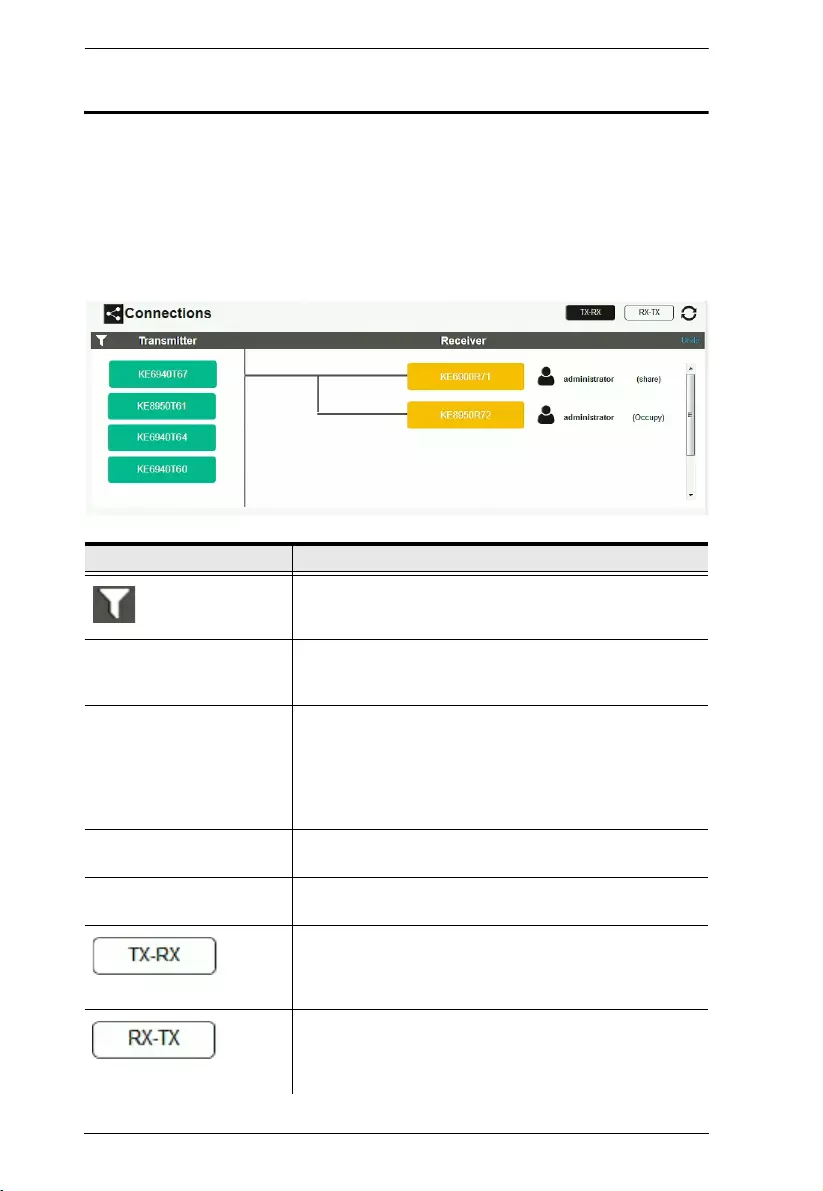
KVM over IP Matrix System User Manual
222
Connections
When Receivers connect to Transmitters, they appears in the Connections
panel. There are two columns – each lists either Transmitters or Receivers. The
columns can be swapped by click the TX-RX or RX-TX button. Devices in the
left column can be clicked to display their connection to devices, shown in the
right column. Connections, shown in the right column, can be disconnected by
clicking the X over the connection diagram.
Item Description
On the heading bar under Connections, click this icon to
change the sort order of the Transmitters or Receivers
listed in the left column.
Left Column Click a device in the left column to view its connection in
the right column. A diagram to its connected device(s)
appears in the right column.
Right Column The right column displays a connection diagram when a
device in the left column is selected. Move the mouse
cursor over the diagram and click X to disconnect the
devices. This column also shows the user and access
type (Exclusive, Occupy, Share, View Only) used to
establish the connection.
Transmitter Lists Transmitters that are online and connected to
Receivers.
Receiver Lists Receivers that are online and connected to
Transmitters.
Click to view Transmitter to Receiver connections. This
will list Transmitters in the left column so that they can be
selected to view their connection diagram, shown in the
right column.
Click to view Receiver to Transmitter connections. This
will list Receivers in the left column so that they can be
selected to view their connection diagram, shown in the
right column.

Chapter 8. Connections
223
Click this icon to Refresh the Transmitters and Receivers
list in Connections panel.
Undo Click this icon to undo the most recent disconnection.
Item Description

KVM over IP Matrix System User Manual
224
This Page Intentionally Left Blank
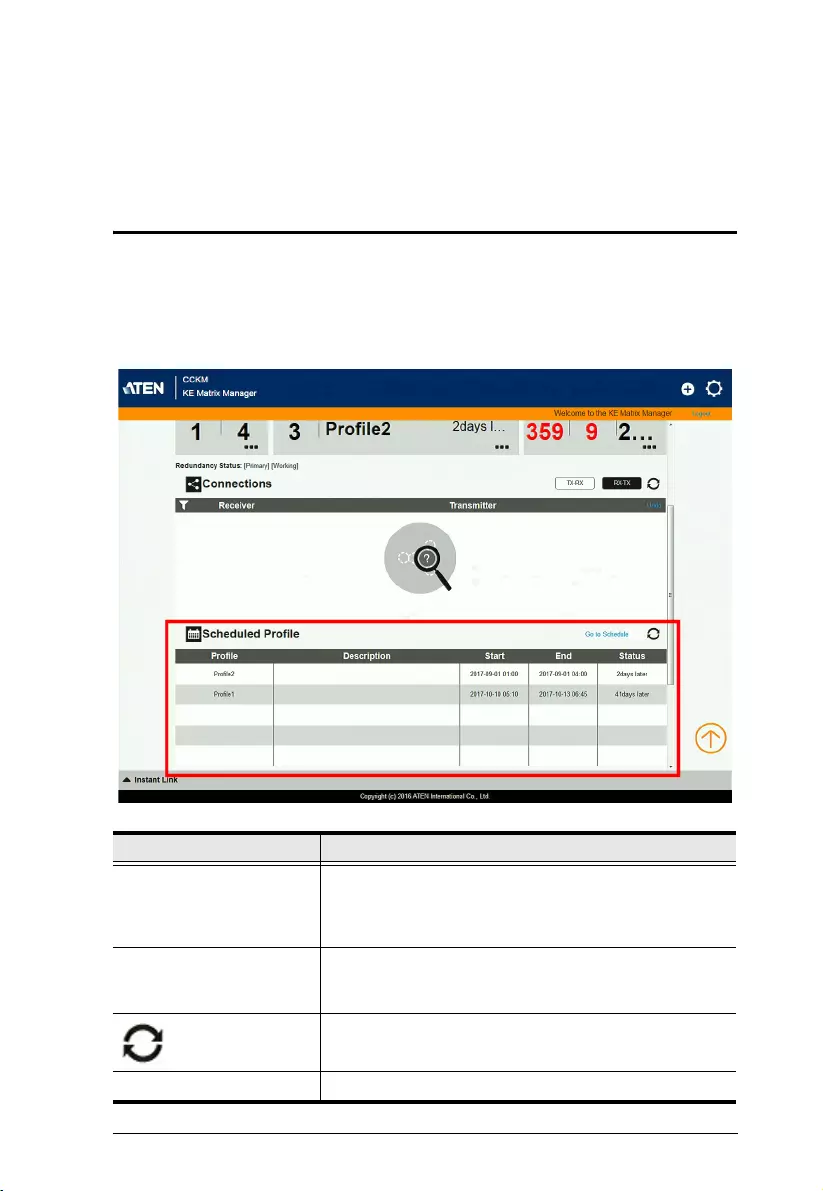
225
Chapter 9
Scheduled Profile
Overview
The Scheduled Profile panel is found on the KE Matrix Manager Main Page,
just below Connections. Scheduled Profiles displays connection profiles that
have been scheduled. Click Go to Schedule to edit and create profile schedules
(page 197). To create Profiles, see page 193.
Item Description
Headings The headings provide the schedules: Name, Description,
Start, End, and Status. Start and End show the time/date
the profile is scheduled to begin and end. Status displays
the number of days until to the next scheduled run.
Go to Schedule Clicking Go to Schedule opens the Profile settings page
which allows you to create and edit connection profiles.
See Profile, page 193 for details.
Click this icon to Refresh the connections list in the right
column.
Undo Click this icon to undo the most recent disconnection.

KVM over IP Matrix System User Manual
226
This Page Intentionally Left Blank
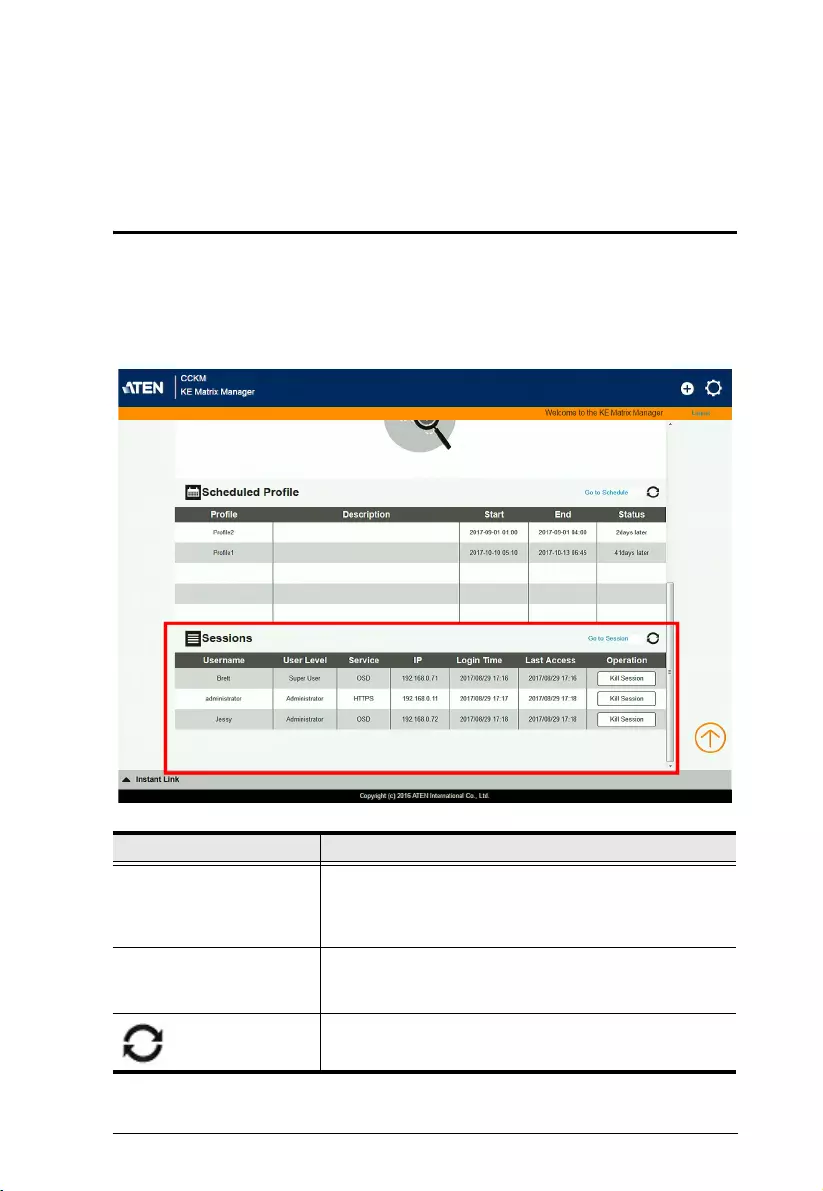
227
Chapter 10
Sessions
Overview
The Sessions panel is found at the bottom of the KE Matrix Manager Main
Page, just below Scheduled Profile. Sessions displays information about users
logged into devices and the KE Matrix Manager web GUI. Click Go to
Sessions to view the settings page (see page 219).
Item Description
Headings The headings provide information about each user
session: Username, User Level, Service, IP, Login Time,
and Last Access. For more details about each heading,
see Sessions, page 219.
Go to Sessions Clicking Go to Sessions opens the Sessions settings
page which provides a page displaying the same
information found in this panel.
Click this icon to Refresh the Sessions list.

KVM over IP Matrix System User Manual
228
This Page Intentionally Left Blank

229
Chapter 11
Firmware Upgrade Utility
The Windows-based Firmware Upgrade Utility (FWUpgrade.exe) provides a
smooth, automated process for upgrading the firmware. The Utility comes as
part of a Firmware Upgrade Package that is specific for each device. New
firmware upgrade packages are posted on our web site as new firmware
revisions become available. Check the web site regularly to find the latest
packages and information relating to them:
http://www.aten.com
For browser based firmware upgrade, please refer to FW Upgrade on page 210.
Preparation
1. From a computer that is not part of your installation go to our Internet
support site and choose the model name that relates to your KE device to
get a list of available Firmware Upgrade Packages.
2. Choose the Firmware Upgrade Package you want to install (usually the
most recent), and download it to your computer.
3. Be sure that the computer is connected to the same LAN segment as the
KE devices.
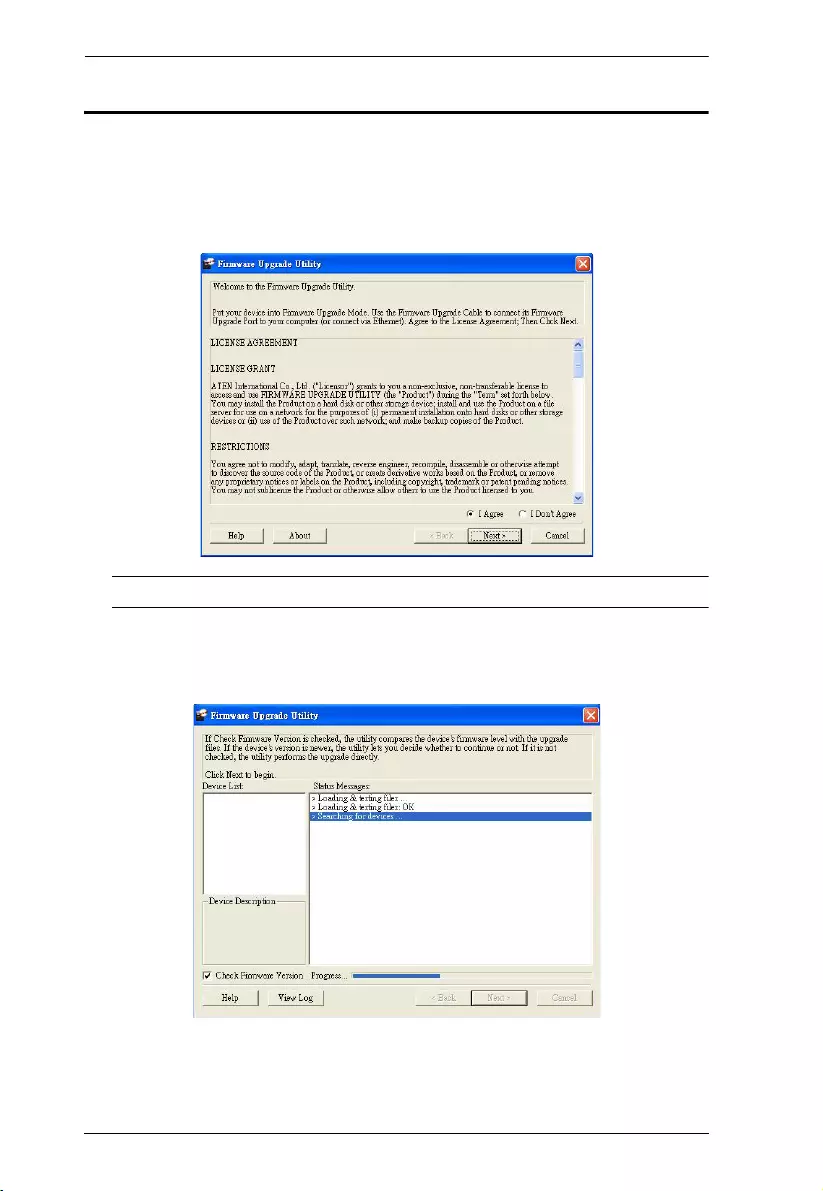
KVM over IP Matrix System User Manual
230
Starting the Upgrade
To upgrade your firmware:
1. Run the downloaded Firmware Upgrade Package file - either by double
clicking the file icon, or by opening a command line and entering the full
path to it. The Firmware Upgrade Utility Welcome screen appears:
Note: The screens shown in this section are for reference only.
2. Read the License Agreement (enable the I Agree radio button).
3. Click Next. The Firmware Upgrade Utility main screen appears:
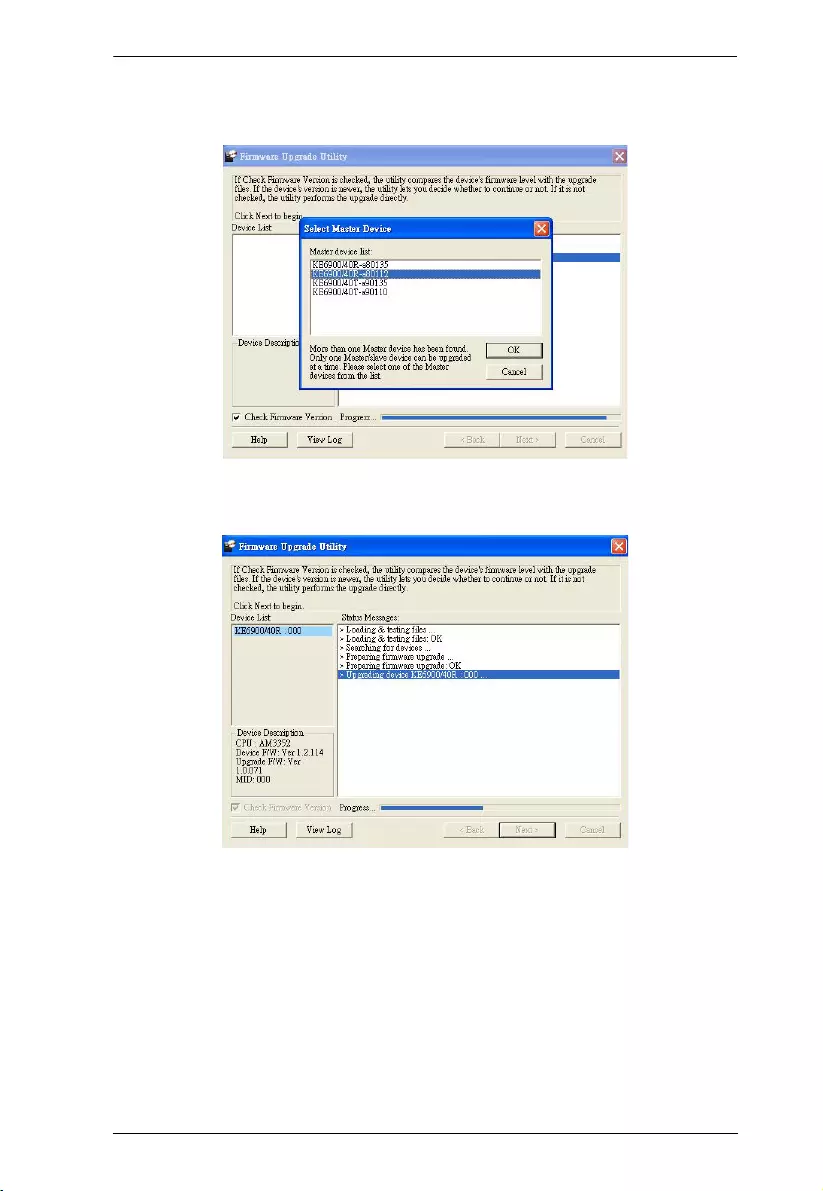
Chapter 11. Firmware Upgrade Utility
231
4. The Utility inspects your installation. All the devices capable of being
upgraded by the package are listed in the Select Master Device list.
5. After you have made your device selection, Click OK and then Next to
begin the upgrade.
If you enabled Check Firmware Version, the Utility compares the device’s
firmware level with that of the upgrade files. If it finds that the device’s
version is higher than the upgrade version, it brings up a dialog box
informing you of the situation and gives you the option to Continue or
Cancel.
If you didn’t enable Check Firmware Version, the Utility installs the
upgrade files without checking whether they are a higher level, or not.
As the Upgrade proceeds status messages appear in the Status Messages
panel, and the progress toward completion is shown on the Progress bar.
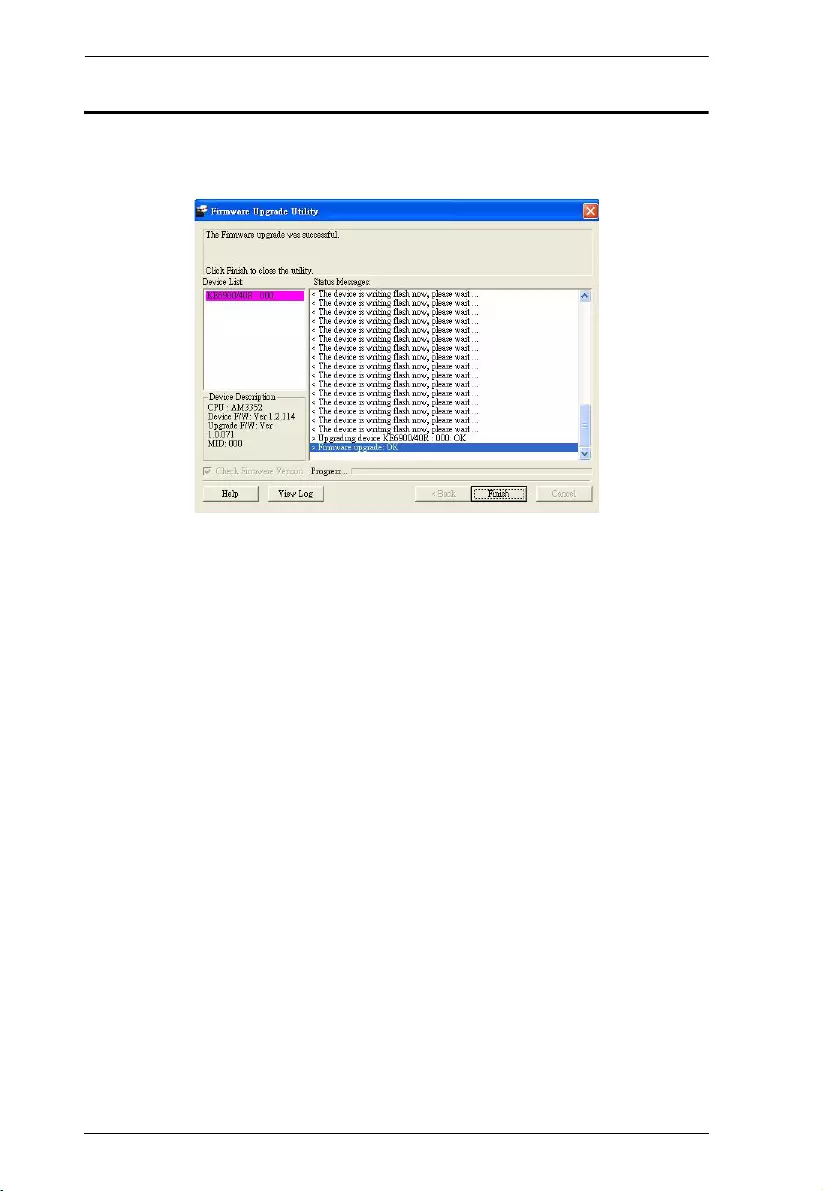
KVM over IP Matrix System User Manual
232
Upgrade Succeeded
After the upgrade has completed, a screen appears to inform you that the
procedure was successful:

Chapter 11. Firmware Upgrade Utility
233
Firmware Upgrade Recovery
If the Upgrade Succeeded screen doesn't appear or the upgrade procedure is
abnormally halted (due to computer crash, power failure, etc.), the device may
become inoperable. If you find that the device does not work following a failed
or interrupted upgrade, do the following
1. Power off the KE device.
2. Press the Reset button, then power on the KE device while holding Reset.
3. Hold Reset for 7 seconds after the device is powered on.
4. The device will revert to a previous firmware version and recover from the
failure.
5. Upgrade the firmware to the most current version available.

KVM over IP Matrix System User Manual
234
This Page Intentionally Left Blank
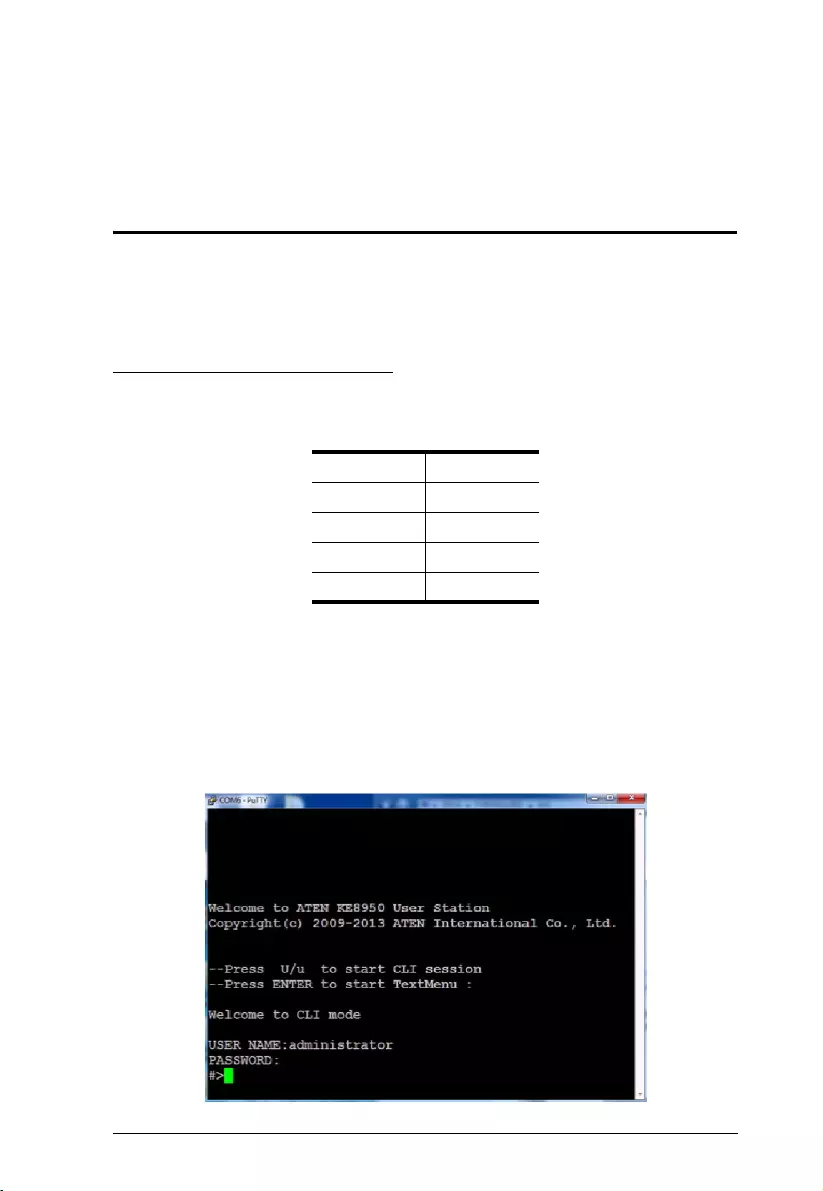
235
Chapter 12
CLI Commands
Serial Control Protocol Commands
The KE Series’s built-in bi-directional RS-232 serial interface and LAN port
connection allows system control via Receivers through a high-end controller
or PC. This control feature can also be accessed via TCP/IP through a computer
running Telnet. The port for Telnet commands should be set to 9130.
Configuring the Serial Port
The controller’s serial port should be configured the same as the Receiver’s
default configuration, as shown below:
The Receiver’s Function Switch should be set to RS-232 Config (see page 27).
Before executing RS-232 commands across a network you must install the KE
Matrix Manager software on a computer and ensure that it is online. For the
Slim Version of KE Series (KE8900ST/8900SR/9900ST). Please make sure
the RS-232 Serial Port is not connected before executing commands.
On your computer, open a terminal (command line) session. Please press "U/
u" to start “CLI Session”.
Baud Rate 9600
Data Bits 8
Parity None
Stop Bits 1
Flow Control None
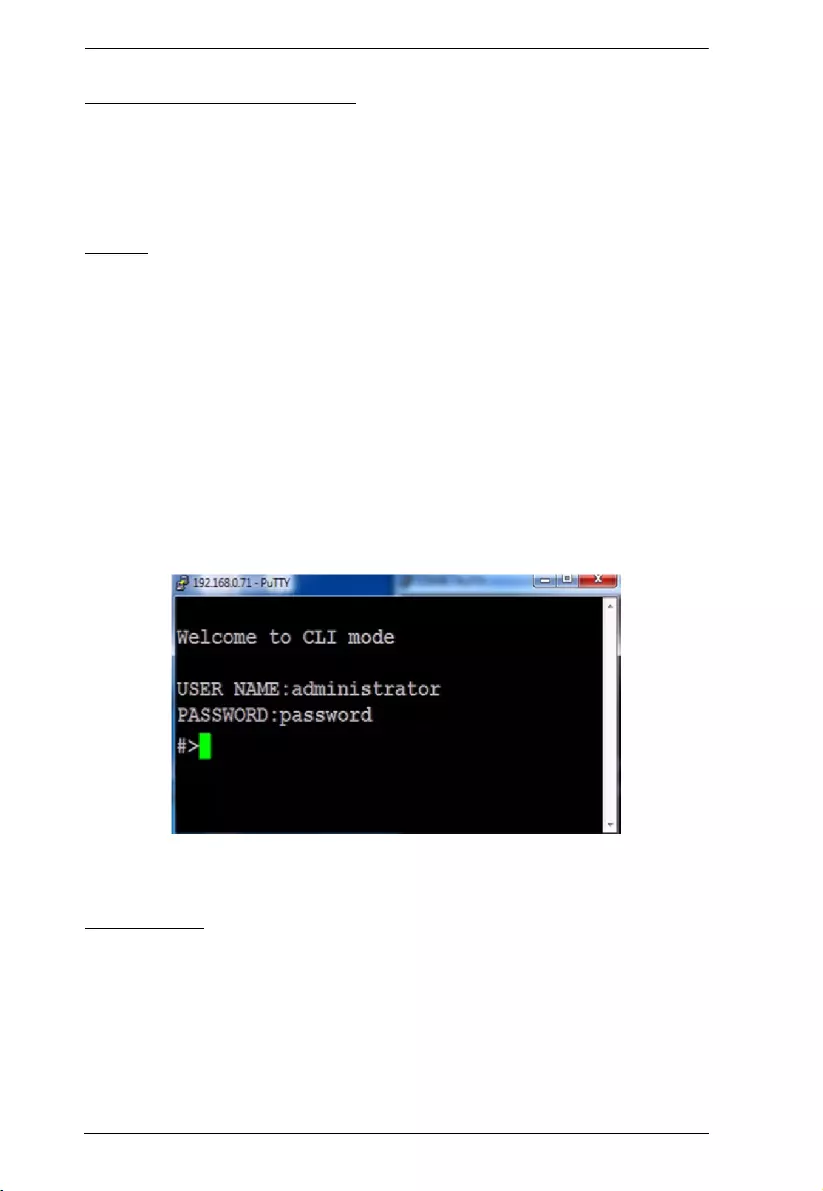
KVM over IP Matrix System User Manual
236
Device/Profile Commands
When typing a device or profile into a command string, you can enter the name
by: IP address (device only), ID or @ with the list number in the command
line interface. Use the list command to view device and profile information.
Telnet
The KE Series can be operated and configured via a remote terminal session
using Telnet. This is a useful means for configuring devices when they are first
setup and connected to the network.
To log into the KE Series device by means of a Telnet session, do the
following:
1. On your computer, open a terminal (command line) session.
2. At the prompt, key in the KE device’s IP address with port 9130 in the
following way:
telnet [IP address] [port]
3. Press Enter. The login screen appears. At the login prompt, provide the
Password.
Verification
After sending a command, a verification message appears at the end of the
command line. Use the echo command to identify a command by number:
Command OK - the command is correct and performed successfully
Command incorrect - the command has the wrong format and/or values.
Echo Command - at the end of a command string, type: e1234 – where
1234 can be any number. The verification message returns with the echo
number.

Chapter 12. CLI Commands
237
Switch Port Command
The formula for Switch Port commands is as follows:
Command + Output + Num1 + Input + Num2 + Mode + Stream +
Connect + [Enter]
1. For example, if you want to switch the Receiver’s connection to
Transmitter (192.168.0.20), type the following:
sw i192.168.0.20 [Enter]
2. For example, if you want to disconnect the Receiver from its Transmitter
connections, type the following:
sw off [Enter]
3. For example, if you want to connect Receiver (192.168.0.99) to
Transmitter (192.168.0.79) with exclusive access to stream video and
audio, type the following:
sw o192.168.0.99 i192.168.0.79 exclusive video audio on [Enter]
4. For example, to disconnect Receiver (192.168.0.11) from the video stream
and return it to the OSD menu, type the following:
sw o192.168.0.11 off [Enter]
5. For example, to disconnect Receiver (192.168.0.09) from the video stream
and logout the OSD, type the following:
sw o192.168.0.09 logout [Enter]
6. For example, to disconnect the Receiver’s USB stream, type the
following:
sw usb off [Enter]
7. For example, to switch the Receiver to the 5th Transmitter listed in the
command line interface, type the following:
sw i@5 exclusive all on [Enter]
8. For example, to switch the Receiver to the 7th Transmitter listed in the
command line interface with echo command 4312, type the following:
sw i@7 exclusive all on e4312
9. For example, to switch Receiver (192.168.0.12) to the 14th Transmitter
listed in the command line interface with occupy access to stream video
audio and USB, type the following:
sw o192.168.0.12 i@14 occupy video audio usb on [Enter]

KVM over IP Matrix System User Manual
238
The following tables show the possible values for the Switch Port commands:
Command Description
sw Switch port command
Output Description
o Output port command (RX)
Num1 Description
xx Output port
xx: Receiver ID or IP address
@zz List #
zz: 1~99
To use the 4th Receiver listed in
the command line interface,
type: o@4
Input Description
i Input command (TX)
Num2 Description
yy Input port
yy: Transmitter ID or IP address
@zz List #
zz: 1~99
To use the 8th Transmitter listed
in the command line interface,
type: i@8
Mode Description
exclusive Sets the Access Mode to
exclusive.
share Sets the Access Mode to share.
occupy Sets the Access Mode to occupy.
viewonly Sets the Access Mode to view
only. If the mode is omitted, view
only is used by default.
Stream Description
video Sets the video source stream
audio Sets the audio source stream
serial Sets the serial source stream

Chapter 12. CLI Commands
239
The following table lists the available Switch Port commands:
usb Sets the USB source stream
all Sets all source streams
Connect Description
on Connect
off Disconnect
logout Logout OSD
Command Output Num1 Input Num2 Mode Stream Con-
nect Description
sw o xx i yy exclusive video
audio
serial
usb
all
on Switch output xx to input
yy with exclusive access
to source(s).
xx: Receiver ID
yy: Transmitter ID
sw o xx i yy share video
audio
serial
usb
all
on Switch output xx to input
yy with share access to
stream source(s).
xx: Receiver ID
yy: Transmitter ID
sw o xx i yy occupy video
audio
serial
usb
all
on Switch output xx to input
yy with occupy access to
stream source(s).
xx: Receiver ID
yy: Transmitter ID
sw o xx i yy viewonly video
audio
serial
usb
all
on Switch output xx to input
yy with viewonly access
to stream source(s).
xx: Receiver ID
yy: Transmitter ID
sw o xx off Switch output xx,
disconnect streams,
return to OSD menu.
xx: Receiver ID
sw o xx logout Switch output xx,
disconnect streams and
logout from OSD menu.
xx: Receiver ID
sw video
audio
serial
usb
all
off Switch Receiver
stream(s) to disconnect.
Stream Description

KVM over IP Matrix System User Manual
240
Note: 1. Each command string can be separated with a space.
2. The Mode command string can be skipped and view only will be used
by default.
3. Skip the Output and Num1 command strings to configure the local
Receiver.
sw off Switch Receiver
disconnect streams,
return to OSD menu.
sw i @zz exclusive
share
occupy
viewonly
video
audio
serial
usb
all
on Switch Receiver to input
@zz with [mode] access
to stream source(s).
zz: Transmitter # by
order listed in the
command line interface.
sw o xx i @zz exclusive video
audio
serial
usb
all
on Switch output xx to input
@zz with [mode] access
to stream source(s).
xx: Receiver ID
zz: Transmitter # by
order listed in command
line interface.
Command Output Num1 Input Num2 Mode Stream Con-
nect Description

Chapter 12. CLI Commands
241
Mute Command
The Mute command allows you to enable or disable the audio.
The formula for the Mute command is as follows:
Command + Output + Num1 + Control + [Enter]
1. For example, to turn mute off (audio on) for the Receiver, type the
following:
mute off [Enter]
2. For example, to turn mute on for Receiver (192.168.0.11), type the
following:
mute o192.168.0.11 on [Enter]
3. For example, to turn mute off for Receiver (192.168.0.18), type the
following:
mute o192.168.0.18 off [Enter]
The following tables show the possible values for the Mute commands:
The following table lists the available Mute commands:
Command Description
mute Mute command
Output Description
o Output port command
Num1 Description
xx Output number
xx: Receiver ID or IP address
Control Description
on Mute on; audio disabled
off Mute off; audio enabled (default)
Command Output Num1 Control Description
mute o xx on Turn mute on for output xx
xx: Receiver ID
mute o xx off Turn mute off for output xx
xx: Receiver ID

KVM over IP Matrix System User Manual
242
Note: 1. Each command string can be separated with a space.
2. The Control command string can be skipped and off will be used by
default.
3. Skip the Output and Num1 command strings to configure the local
Receiver.
mute on Turn mute on for Receiver
mute off Turn mute off for Receiver
Command Output Num1 Control Description

Chapter 12. CLI Commands
243
Profile Command
The Profile command allows you to connect profiles and video walls.
The formula for Profile commands is as follows:
Command + Profile + Num1 + Control + [Enter]
1. For example, to connect profile 8 and lock the OSD menu, type the
following:
profile f8 [Enter]
2. For example, to connect profile 4 with access to the OSD menu, type the
following:
profile f4 release [Enter]
3. For example, to disconnect profile 12 and return to the Receiver to the
OSD menu, type the following:
profile f12 back [Enter]
The following tables show the possible values for the Profile commands:
Command Description
profile Profile command
Profile Description
f Profile ID
Num1 Description
xx Profile or Video Wall ID
xx: 1-99
Control Description
lock Connect profile, lock access to
OSD menu (default)
release Connect profile, allow access to
OSD menu
back Disconnect profile, return
Receiver to OSD menu

KVM over IP Matrix System User Manual
244
The following table lists the available Profile commands:
Note: 1. Each command string can be separated with a space.
2. The Control command string can be skipped and lock will be used by
default.
Command Profile Num1 Control Description
profile f xx lock Connect profile xx, lock
OSD access
xx:1~99
profile f xx release Connect profile xx, allow
OSD access
xx:1~99
profile f xx back Disconnect profile xx
and return Receiver to
OSD menu
xx: 1~99

Chapter 12. CLI Commands
245
EDID Command
Extended Display Identification Data (EDID) is a data that contains a display's
basic information and is used to communicate with the video source. The EDID
commands allow you to change the EDID setting of a Transmitter. For more
information on configuring EDID settings, see Properties, page 115.
The formula for the EDID command is as follows:
Command + Address + Number + Control + [Enter]
1. For example, if you want to configure device (192.168.0.3) to use the
remix EDID mode, type the following:
edid a192.168.0.3 remix [Enter]
The following tables show the possible values for the EDID commands:
Command Description
edid EDID command
Address Description
a Address command
Number Description
xx Address number
xx: Receiver ID or IP address
Control Description
auto Checks the EDID of all connected
displays and uses the best resolution for
all displays.
remix Checks the EDID of all connected
displays and the source device uses the
best common resolution for all displays
(see EDID Mode, page 123).
default Implements ATEN’s default EDID.
(default)
manual Manually set the EDID configuration from
the Receiver’s OSD (see EDID Mode,
page 123).

KVM over IP Matrix System User Manual
246
The following table lists the available EDID commands:
Command Address Number Control Enter Description
edid a xx auto [Enter] Set EDID of address xx to auto.
xx: Device ID or IP Address
edid a xx remix [Enter] Set EDID of address xx to remix.
xx: Device ID or IP Address
edid a xx default [Enter] Set EDID of address xx to
default.
xx: Device ID or IP Address
edid a xx manual [Enter] Set EDID of address xx to
manual.
xx: Device ID or IP Address

Chapter 12. CLI Commands
247
Reset Command
The Reset command allows you to reset a device back to the default factory
settings. Reset includes resetting the devices IP address.
The formula for the Reset command is as follows:
Command + Address + Number + [Enter]
1. For example, to reset device (192.168.0.95), type the following:
reset a192.168.0.95 [Enter]
2. For example, to reset the Receiver, type the following:
reset [Enter]
The following tables show the possible values for the Reset command:
The following table lists the available Reset commands:
Note: 1. Each command string can be separated with a space.
2. Skip the Address and Number command strings to reset the local
Receiver.
Command Description
reset Reset command
Address Description
a Address command
Number Description
xx Address number
xx: Receiver ID or IP address
Command Address Num Enter Description
reset a xx [Enter] Reset address xx back to the
factory default settings
xx: Device ID or IP Address
reset [Enter] Resets the Receiver settings

KVM over IP Matrix System User Manual
248
RS-232 Command
The RS-232 command allows you to set the RS-232 settings for a device.
The formula for the RS-232 command is as follows:
Command + Address + Number + Baud Rate + Parity + Data Bit +
Stop Bit + Flow Control [Enter]
1. For example, to set device (192.168.0.33) with a baud rate of 38400, parity
of none, data bit of 8, and stop bit of 1, type the following:
baud a192.168.0.33 38400 none 8 1 [Enter]
2. For example, to set the local device with a baud rate of 19200, type the
following:
baud 19200 [Enter]
The following tables show the possible values for the RS-232 command:
Command Description
baud RS-232 command
Address Description
a Address command
Num1 Description
xx Address number
xx: Device ID or IP address
Baud Rate Description
9600 Use 9600 baud rate
19200 Use 19200 baud rate
38400 Use 38400 baud rate
115200 Use 115200 baud rate
Parity Description
None Sets the parity to none
Even Sets the parity to even
Odd Sets the parity to odd
Data Bit Description
5 Sets the data bit to 5
6 Sets the data bit to 6

Chapter 12. CLI Commands
249
The following table lists the available Baud Rate commands:
7 Sets the data bit to 7
8 Sets the data bit to 8
Stop Bit Description
1 Sets the stop bit to 1
2 Sets the stop bit to 2
Flow Control Description
None Sets flow control to none
Hardware Sets flow control to hardware
Xon Sets flow control to Xon
Xoff Sets flow control to Xoff
Com
mand Address Num
1
Baud
Rate Parity Data
Bit
Stop
Bit
Flow
Control Description
baud a xx 9600 None
Even
Odd
5
6
7
8
1
2
None
Hardware
Xon/Xoff
Set address xx
baud rate to
9600, with
parity/ data bit/
stop bit / flow
control setting
baud a xx 19200 None
Even
Odd
5
6
7
8
1
2
None
Hardware
Xon/Xoff
Set address xx
baud rate to
19200, with
parity/ data bit/
stop bit / flow
control setting
baud a xx 38400 None
Even
Odd
5
6
7
8
1
2
None
Hardware
Xon/Xoff
Set address xx
baud rate to
38400, with
parity/ data bit/
stop bit / flow
control setting
baud a xx 115200 None
Even
Odd
5
6
7
8
1
2
None
Hardware
Xon/Xoff
Set address xx
baud rate to
115200, with
parity/ data bit/
stop bit / flow
control setting
Data Bit Description

KVM over IP Matrix System User Manual
250
Note: 1. Each command string can be separated with a space.
2. The Baud Rate value is required but Parity, Data Bit and Stop Bit
can be skipped and their setting will not change.
3. Skip the Address and Number command strings to configure the
local device settings.
baud 9600 Set local device
baud rate to
9600
baud 19200 Set local device
baud rate to
19200
baud 38400 Set local device
baud rate to
38400
baud 115200 Set local device
baud rate to
115200
Com
mand Address Num
1
Baud
Rate Parity Data
Bit
Stop
Bit
Flow
Control Description

Chapter 12. CLI Commands
251
OSD Command
To enable or disable the On-Screen Display (OSD) menu for a Receiver, use
the following command:
Command + Output + Number + Control + [Enter]
1. For example, to enable the OSD for Receiver 192.168.0.51, type:
osd o192.168.0.51 on [Enter]
2. For example, to disable the OSD for the local Receiver, type:
osd off [Enter]
The following tables show the possible values for the OSD command:
The following table lists the available OSD commands:
Note: 1. Each command string can be separated with a space.
2. Skip the Output and Number command strings to configure the local
Receiver.
Command Description
osd OSD command
Output Description
o Output command
Number Description
xx Output number
xx: Receiver ID or IP address
Control Description
on Enable OSD functions
off Disable OSD functions (default)
Comman
dOutput Number Control Enter Description
osd oxx
on [Enter] Enable OSD functions for
output xx
xx: Receiver ID or IP
address
osd oxx
off [Enter] Disable OSD functions for
output xx off (default)
xx: Receiver ID or IP
address

KVM over IP Matrix System User Manual
252
List Command
The List command allows you to retrieve information about users, settings and
connections.
The formula for the List command is as follows:
Command + Output + Input + Number + Control [Enter]
1. For example, for a complete list of available channels, type the following:
list channel [Enter]
2. For example, for a complete list of available profiles, type the following:
list profile [Enter]
3. For example, to list all users logged into all OSD menus, type the
following:
4. list login [Enter]
5. For example, to list the user logged into the OSD on Receiver
(192.168.0.44), type the following:
list o192.168.0.44 login [Enter]
6. For example, for a complete list of available connections, type the
following:
list connection [Enter]
7. For example, to list the current connections on Transmitter (192.168.0.88),
type the following:
list i192.168.0.88 connection [Enter]
The following tables show the possible values for the List command:
Command Description
list List command
Output Description
o Output command
Input Description
i Input command
Number Description
xx Output or Input number
xx: Device ID or IP address

Chapter 12. CLI Commands
253
The following table lists the available List commands:
Note: 1. Each command string can be separated with a space.
2. Skip the Output or Input and Number command strings to view the
local Receiver.
Control Description
channel Lists information about the available
channel(s)
profile Lists information about the available
profile and TV wall connections
rx Lists information about the Receiver
login Lists information about users logged
into to the OSD menu
connection Lists information about a Transmitters
current connections
Comman
dOutput Input Number Control Description
list o xx login List output xx user
logged into OSD.
list o xx rx List output xx Receiver
information
list i xx connection List input xx
Transmitter information
list channel List all available
channel information
list profile List all available profile
information
list rx List information about
all Receivers
list login List information about
all OSD logins
list connection List information about
all connections

KVM over IP Matrix System User Manual
254
Read Command
The Read command allows you to retrieve the properties of a device.
The formula for the Read command is as follows:
Command + Output + Input + Number + Control [Enter]
1. For example, to read all of the local Receiver’s properties, type the
following:
read all [Enter]
2. For example, to read all of Receiver (192.168.0.19) device properties, type
the following:
read o192.168.0.19 all [Enter]
3. For example, to read all of Transmitter (192.168.0.28) device properties,
type the following:
read i192.168.0.28 all [Enter]
4. For example, to read the basic properties of Receiver (192.168.0.61), type
the following:
read o192.168.0.61 basic [Enter]
5. For example, to read the network properties of Transmitter (192.168.0.71),
type the following:
read i192.168.0.71 network [Enter]
The following tables show the possible values for the Read command:
Command Description
read Read command
Output Description
o Output command
Input Description
i Input command
Number Description
xx Output or Input number
xx: Device ID or IP address
Control Description
all Read all device properties

Chapter 12. CLI Commands
255
The following table lists the available Read commands:
basic Read basic properties
network Read network properties
ipsettings Read IP settings
rs232 Read RS232 properties
properties Read connection properties
manager Read KE Matrix Manager software
properties
streams Read enable media properties
tx Read source stream IP properties
(Receiver)
usbmode Read USB mode properties
(Receiver)
multicast Read multicast properties
(Transmitter)
videoqtyadvanced Read advanced video properties
(Transmitter)
ossettings Read OS properties
(Transmitter)
Comman
dOutput Input Number Control Description
read o i xx all Read output or input xx
all device properties
xx: Device ID or IP
address
read o i xx basic Read output or input xx
basic properties
xx: Device ID or IP
address
read o i xx network Read output or input xx
network properties
xx: Device ID or IP
address
read o i xx ipsettings Read output or input xx
IP address properties
xx: Device ID or IP
address
Control Description

KVM over IP Matrix System User Manual
256
read o i xx rs232 Read output or input xx
RS-232 properties
xx: Device ID or IP
address
read o i xx properties Read output or input xx
connection properties
xx: Device ID or IP
address
read o i xx manager Read output or input xx
KE Matrix Manager IP
and port properties
xx: Device ID or IP
address
read o i xx streams Read output or input xx
enable media
properties
xx: Device ID or IP
address
read o xx tx Read output xx source
stream IP address
properties
xx: Receiver ID or IP
address
read o xx usbmode Read output xx USB
mode properties
xx: Receiver ID or IP
address
read i xx multicast Read input xx multicast
properties
xx: Transmitter ID or IP
address
read i xx videoqtyad
vanced
Read input xx
advanced video
properties
xx: Transmitter ID or IP
address
read i xx ossettings Read input xx OS
properties
xx: Transmitter ID or IP
address
read all Read all properties of
local Receiver
Comman
dOutput Input Number Control Description

Chapter 12. CLI Commands
257
Note: 1. Each command string can be separated with a space.
2. Skip the Output or Input and Number command strings to read the
local Receiver properties.
read basic
network
ipsettings
rs232
properties
manager
streams
tx
usbmode
Read [control]
properties of local
Receiver.
Comman
dOutput Input Number Control Description

KVM over IP Matrix System User Manual
258
Set Command
The Set command allows you to configure the properties of a device. Some
settings require that both the device and Matrix Manager are online or the
command will fail.
The formula for the Set command is as follows:
Command + Output + Input + Number + Control + Value + [Enter]
1. For example, to set the name of the local Receiver to KE6940TX1, type
the following:
set Name=KE6940TX1 [Enter]
2. For example, to set the description of Transmitter (192.168.0.33) to KE
Room B, type the following:
set o192.168.0.19 Description=KE Room B [Enter]
3. For example, to set the DHCP settings of Transmitter (192.168.0.28) to
static, type the following:
set i192.168.0.28 dhcpFlag=STATIC [Enter]
4. For example, to set the IP settings of the local Receiver to 192.168.0.2,
type the following:
set ipAddr=192.168.0.2 [Enter]
5. For example, to set the Transmitter Video IP setting to 192.168.0.44 for
Receiver (192.168.0.56), type the following:
set o192.168.0.56 TxVideoIP=192.168.0.44 [Enter]
The following tables show the possible values for the Set command:
Command Description
set Set command
Output Description
o Output command
Input Description
i Input command
Number Description
xx Output or Input number
xx: Device ID or IP address

Chapter 12. CLI Commands
259
Control Description
Name Sets the device name
Description Sets the device description
ipInstallerFlag Sets the IP installer option
dhcpFlag Sets the DHCP setting
ipAddr Sets the IP address
netmask Sets the subnet mask
gw Sets the default gateway
modeFlag Sets the device mode
BaudRate Sets the baud rate setting
Parity Sets the parity setting
DataBit Sets the data bit setting
StopBit Sets the stop bit setting
FlowCtrl Sets the flow control setting
TxVideoIP Sets the Transmitter video IP setting
TxAudioIP Sets the Transmitter audio IP setting
TxUSBIP Sets the Transmitter USB IP setting
TxRSIP Sets the Transmitter RS-232 IP setting
VideoEnFlag Sets the (enable media) video source
stream
AudioEnFlag Sets the (enable media) audio source
stream
USBEnFlag Sets the (enable media) USB source
stream
RSEnFlag Sets the (enable media) RS232
source stream
ManagerIP Sets the KE Matrix Manager software
IP
ManagerPort Sets the KE Matrix Manager software
port
Beeper Sets the beeper
RxVM Sets the USB mode setting
USBSecure Sets the USB encryption
PortOS Sets the port OS setting
OSLanguage Sets the OS language
videoMCastEn Sets the enable multicast video setting

KVM over IP Matrix System User Manual
260
The following table lists the available Set commands:
audioMCastEn Sets the enable multicast audio setting
Edid Sets the EDID mode selection setting
VideoType Sets the video type setting
ColorDepth Sets the color depth setting
BandwidthLimit Sets the bandwidth limit setting
VideoQty Sets the video quality setting
BGRefresh Sets the background refresh setting
Beeper Sets the beeper setting
OccupyTimeout Sets the occupy timeout setting
Resolution Sets the resolution setting
Value Description
=yy Set value to yy
yy: Enter a value that corresponds to
the control being used
Comm
and Output Input Number Control Value Description
Set o i xx Name yy Set output or input xx
Name to yy
xx: Device ID or IP
address
yy: Name value
Set o i xx Description yy Set output or input xx
Description to yy
xx: Device ID or IP
address
yy: Description value
Set o i xx ipInstallerFlag yy Set output or input xx
ipInstallerFlag to yy
xx: Device ID or IP
address
yy: enable, viewonly,
disable
Control Description

Chapter 12. CLI Commands
261
Set o i xx dhcpFlag yy Set output or input xx
dhcpFlag to yy
xx: Device ID or IP
address
yy: dhcp, static
Set o i xx ipAddr yy Set output or input xx
ipAddr to yy
xx: Device ID or IP
address
yy: IP address value
Set o i xx netmask yy Set output or input xx
netmask to yy
xx: Device ID or IP
address
yy: Subnet mask value
Set o i xx gw yy Set output or input xx
gw to yy
xx: Device ID or IP
address
yy: Default gateway
value
Set o i xx modeFlag yy Set output or input xx
modeFlag to yy
xx: Device ID or IP
address
yy: extender, matrix
Set o i xx BaudRate yy Set output or input xx
BaudRate to yy
xx: Device ID or IP
address
yy: 9600, 19200,
38400, 115200
Set o i xx Parity yy Set output or input xx
Parity to yy
xx: Device ID or IP
address
yy: none, even, odd
Set o i xx DataBit yy Set output or input xx
DataBit to yy
xx: Device ID or IP
address
yy: 5, 6, 7, 8
Comm
and Output Input Number Control Value Description

KVM over IP Matrix System User Manual
262
Set o i xx StopBit yy Set output or input xx
StopBit to yy
xx: Device ID or IP
address
yy: 1, 1.5, 2
Set o i xx FlowCtrl yy Set output or input xx
FlowCtrl to yy
xx: Device ID or IP
address
yy: none, hardware,
Xon, Xoff
Set o i xx TxVideoIP yy Set output xx
TxVideoIP to yy
xx: Device ID or IP
address
yy: IP address value
Set o xx TxAudioIP yy Set output xx
TxAudioIP to yy
xx: Device ID or IP
address
yy: IP address value
Set o xx TxUSBIP yy Set output xx TxUSBIP
to yy
xx: Device ID or IP
address
yy: IP address value
Set o xx TxRSIP yy Set output xx TxRSIP
to yy
xx: Device ID or IP
address
yy: IP address value
Set o i xx VideoEnFlag yy Set output or input xx
VideoEnFlag to yy
xx: Device ID or IP
address
yy: enable, disable
Set o i xx AudioEnFlag yy Set output or input xx
AudioEnFlag to yy
xx: Device ID or IP
address
yy: enable, disable
Comm
and Output Input Number Control Value Description

Chapter 12. CLI Commands
263
Set o i xx USBEnFlag yy Set output or input xx
USBEnFlag to yy
xx: Device ID or IP
address
yy: enable, disable
Set o i xx RSEnFlag yy Set output or input xx
RSEnFlag to yy
xx: Device ID or IP
address
yy: enable, disable
Set o i xx ManagerIP yy Set output or input xx
ManagerIP to yy
xx: Device ID or IP
address
yy: KE Matrix Manager
software IP address
Set o i xx ManagerPort yy Set output or input xx
ManagerPort to yy
xx: Device ID or IP
address
yy: KE Matrix Manager
software port
Set o i xx Beeper yy Set output or input xx
Beeper to yy
xx: Device ID or IP
address
yy: enable, disable
Set o xx RxVM yy Set output xx RxVM to
yy
xx: Device ID or IP
address
yy: vm, vusb
Set o xx USBSecure yy Set output xx
USBSecure to yy
xx: Device ID or IP
address
yy: on, off
Set i xx PortOS yy Set input xx PortOS to
yy
xx: Device ID or IP
address
yy: win, mac, sun, other
Comm
and Output Input Number Control Value Description

KVM over IP Matrix System User Manual
264
Set i xx OSLanguage yy Set input xx
OSLanguage to yy
xx: Device ID or IP
address
yy: english, japanese,
french, german,
spanish, korean,
chinese(traditional),
english(uk), swedish,
arabic, belgian,
canadian-bilingual,
french(canada), czech,
danish, finnish, greek,
hebrew, hungarian,
international(iso),
italian, latin american,
dutch, norwegian,
persian(farsi), polish,
portuguese, russian,
slovak, french
(switzerland), german
(switzerland),
switzerland, reserved,
turkish-q, reserved,
serbo-croatian
Set i xx videoMCastEn yy Set input xx
videoMCastEn to yy
xx: Device ID or IP
address
yy: enable, disable
Set i xx audioMCastEn yy Set input xx
audioMCastEn to yy
xx: Device ID or IP
address
yy: enable, disable
Set i xx Edid yy Set input xx Edid to yy
xx: Device ID or IP
address
yy: default, auto,
manual, remix
Set i xx VideoType yy Set input xx VideoType
to yy
xx: Device ID or IP
address
yy: dvi-d, dvi-a
Comm
and Output Input Number Control Value Description

Chapter 12. CLI Commands
265
Set i xx ColorDepth yy Set input xx ColorDepth
to yy
xx: Device ID or IP
address
yy: 8, 16, 24,
and 36 (only for KE89
Series)
Set i xx BandwidthLimit yy Set input xx
BandwidthLimit to yy
xx: Device ID or IP
address
yy: unlimited, 100, 200,
500
Set i xx VideoQty yy Set input xx VideoQty
to yy
xx: Device ID or IP
address
yy: 1, 2, 3, 4, 5
Set i xx BGRefresh yy Set input xx BGRefresh
to yy
xx: Device ID or IP
address
yy: off, 16, 32, 64, 128,
256
Set i xx OccupyTimeout yy Set input xx
OccupyTimeout to yy
xx: Device ID or IP
address
yy: 1~240
Comm
and Output Input Number Control Value Description

KVM over IP Matrix System User Manual
266
Set i xx Resolution yy Set input xx Resolution
to yy
xx: Device ID or IP
address
yy: 1920x1200,
1920x1080,
1680x1050,
1600x1200, 1600x900,
1440x900, 1400x1050,
1366x768, 1280x1024,
1280x960, 1280x720,
1152x864, 1024x768,
800x600, 720x400,
640x480, 2560x1080*,
3840x2160*,
1920x1440*,
2560x1600*,
2560x1440*,
2048x1536*
*Only for KE89 Series
Comm
and Output Input Number Control Value Description

267
Appendix
Safety Instructions
General
This product is for indoor use only.
Read all of these instructions. Save them for future reference.
Follow all warnings and instructions marked on the device.
Do not place the device on any unstable surface (cart, stand, table, etc.). If
the device falls, serious damage will result.
Do not use the device near water.
Do not place the device near, or over, radiators or heat registers.
The device cabinet is provided with slots and openings to allow for
adequate ventilation. To ensure reliable operation, and to protect against
overheating, these openings must never be blocked or covered.
The device should never be placed on a soft surface (bed, sofa, rug, etc.) as
this will block its ventilation openings. Likewise, the device should not be
placed in a built in enclosure unless adequate ventilation has been provided.
Never spill liquid of any kind on the device.
Avoid circuit overloads. Before connecting equipment to a circuit, know
the power supply’s limit and never exceed it. Always review the electrical
specifications of a circuit to ensure that you are not creating a dangerous
condition or that one doesn’t already exist. Circuit overloads can cause a
fire and destroy equipment.
Unplug the device from the wall outlet before cleaning. Do not use liquid
or aerosol cleaners. Use a damp cloth for cleaning.
The device should be operated from the type of power source indicated on
the marking label. If you are not sure of the type of power available,
consult your dealer or local power company.
The device is designed for IT power distribution systems with 230V
phase-to-phase voltage.
To prevent damage to your installation it is important that all devices are
properly grounded.
The device is equipped with a 3-wire grounding type plug. This is a safety
feature. If you are unable to insert the plug into the outlet, contact your
electrician to replace your obsolete outlet. Do not attempt to defeat the

UPS User Manual
268
purpose of the grounding-type plug. Always follow your local/national
wiring codes.
Do not allow anything to rest on the power cord or cables. Route the
power cord and cables so that they cannot be stepped on or tripped over.
If an extension cord is used with this device make sure that the total of the
ampere ratings of all products used on this cord does not exceed the
extension cord ampere rating. Make sure that the total of all products
plugged into the wall outlet does not exceed 15 amperes.
To help protect your system from sudden, transient increases and
decreases in electrical power, use a surge suppressor, line conditioner, or
uninterruptible power supply (UPS).
Position system cables and power cables carefully; Be sure that nothing
rests on any cables.
Never push objects of any kind into or through cabinet slots. They may
touch dangerous voltage points or short out parts resulting in a risk of fire
or electrical shock.
Do not attempt to service the device yourself. Refer all servicing to
qualified service personnel.
If the following conditions occur, unplug the device from the wall outlet
and bring it to qualified service personnel for repair.
The power cord or plug has become damaged or frayed.
Liquid has been spilled into the device.
The device has been exposed to rain or water.
The device has been dropped, or the cabinet has been damaged.
The device exhibits a distinct change in performance, indicating a need
for service.
The device does not operate normally when the operating instructions
are followed.
Only adjust those controls that are covered in the operating instructions.
Improper adjustment of other controls may result in damage that will
require extensive work by a qualified technician to repair.

Appendix
269
Rack Mounting
Before working on the rack, make sure that the stabilizers are secured to
the rack, extended to the floor, and that the full weight of the rack rests on
the floor. Install front and side stabilizers on a single rack or front
stabilizers for joined multiple racks before working on the rack.
Always load the rack from the bottom up, and load the heaviest item in the
rack first.
Make sure that the rack is level and stable before extending a device from
the rack.
Use caution when pressing the device rail release latches and sliding a
device into or out of a rack; the slide rails can pinch your fingers.
After a device is inserted into the rack, carefully extend the rail into a
locking position, and then slide the device into the rack.
Do not overload the AC supply branch circuit that provides power to the
rack. The total rack load should not exceed 80 percent of the branch circuit
rating.
Make sure that all equipment used on the rack – including power strips and
other electrical connectors – is properly grounded.
Ensure that proper airflow is provided to devices in the rack.
Ensure that the operating ambient temperature of the rack environment
does not exceed the maximum ambient temperature specified for the
equipment by the manufacturer.
Do not step on or stand on any device when servicing other devices in a
rack.

UPS User Manual
270
Technical Support
International
For online technical support – including troubleshooting, documentation,
and software updates: http://support.aten.com
For telephone support, see Telephone Support, page iii.
North America
When you contact us, please have the following information ready beforehand:
Product model number, serial number, and date of purchase.
Your computer configuration, including operating system, revision level,
expansion cards, and software.
Any error messages displayed at the time the error occurred.
The sequence of operations that led up to the error.
Any other information you feel may be of help.
Email Support support@aten-usa.com
Online
Technical
Support
Troubleshooting
Documentation
Software Updates
http://www.aten-usa.com/support
Telephone Support 1-888-999-ATEN ext 4988
1-949-428-1111

Appendix
271
Specifications
KE6900T / KE6940T
Function KE6900T KE6940T
Connectors Console
Ports
Keyboard 1 x USB Type A Female (White)
Video 1 x DVI-I Female
(White)
2 x DVI-I Female
(White)
Mouse 1 x USB Type A Female (White)
Speaker 1 x Mini Stereo Jack Female (Green)
Mic. 1 x Mini Stereo Jack Female (Pink)
RS-232 1 x DB-9 Male (Black)
KVM
Ports
KB / Mouse USB Type B Female (White)
Speaker 1 x Mini Stereo Jack (Green)
Mic. 1 x Mini Stereo Jack (Pink)
Video 1 x DVI-I Female
(White)
2 x DVI-I Female
(White)
RS-232 1 x DB-9 Female (Black)
Power 1 x DC Jack (Black)
LAN 1 x RJ-45 Female (Black)
Switches Function 1 x Slide switch (Black)
(Auto, RS-232 Config, Local)
Reset 1 x Semi-recessed Pushbutton
LEDs LAN 1 (Green / Orange)
Power 1 x Blue
Local 1 x Green
Remote 1 x Green
Emulation Keyboard / Mouse USB
Power Consumption DC 5V, 7.34W DC 5V, 8.91W
Video Resolution Up to 1920 x 1200
Environment Operating Temp. 0–50ºC
Storage Temp. -20–60ºC
Humidity 0–95% RH, Non-condensing

UPS User Manual
272
Physical
Properties
Housing Metal
Weight 1.14 kg 1.15 kg
Dimensions
(L x W x H)
21.50 x 16.29 x 4.18 cm
Function KE6900T KE6940T

Appendix
273
KE6900R / KE6940R
Function KE6900R KE6940R
Connectors USB Virtual Media 2 x USB Type A Female (White)
Console
Ports
Keyboard 1 x USB Type A Female (White)
Video 1 x DVI-I Female
(White)
2 x DVI-I Female
(White)
Mouse 1 x USB Type A Female (White)
Speaker 1 x Mini Stereo Jack Female (Green)
Mic. 1 x Mini Stereo Jack Female (Pink)
RS-232 1 x DB-9 Male (Black)
Power 1 x DC Jack (Black)
LAN 1 x RJ-45 Female (Black)
Switches OSD 1 x Pushbutton
Video 1 x Pushbutton
Graphics 1 x Pushbutton
Function 1 x Slide Switch (Black)
(Extension, RS-232 Config)
Reset 1 x Semi-recessed Pushbutton
LEDs LAN 1 (Green / Orange)
Power 1 x Blue
Local 1 x Green
Remote 1 x Green
Emulation Keyboard / Mouse USB
Power Consumption DC 5V, 6.9W DC 5V, 9.53W
Video Resolution Up to 1920 x 1200
Environment Operating Temp. 0–50ºC
Storage Temp. -20–60ºC
Humidity 0–95% RH, Non-condensing
Physical
Properties
Housing Metal
Weight 1.25 kg 1.25 kg
Dimensions
(L x W x H)
22.75 x 17.16 x 5.48 cm

UPS User Manual
274
KE6900ST
Function KE6900ST
Connectors KVM
Ports
KB / Mouse USB Type B Female (White)
Video 1 x DVI-D Male (White)
RS-232 1 x DB-9 Female (Black)
Power 1 x DC Jack (Black)
LAN 1 x RJ-45 Female (Black)
Switch Reset 1 x Semi-recessed Pushbutton
LEDs LAN 1 (Green / Orange)
Power 1 x Blue
Emulation Keyboard / Mouse USB
Power Consumption 5 V / 7.3 W
Video Resolution Up to 1920 x 1200
Environment Operating Temp. 0–50ºC
Storage Temp. -20–60ºC
Humidity 0–95% RH, Non-condensing
Physical
Properties
Housing Metal
Weight 0.43 kg
Dimensions
(L x W x H)
14.39 x 10.30 x 3.00 cm

Appendix
275
KE6910
Function KE6910R KE6910T
Connectors Virtual Media 2 x USB Type A Female
(Black)
N/A
Console Ports 2 x USB Type A Female
(White)
2 x USB Type A Female
(White)
1 x DVI-D Female (White) 1 x DVI-D Female (White)
1 x Mini Stereo Jack
(Green)
1 x Mini Stereo Jack
(Green)
1 x Mini Stereo Jack
(Pink)
1 x Mini Stereo Jack
(Pink)
1 x DB-9 Male (Black) 1 x DB-9 Male (Black)
KVM Ports N/A 2 x USB Type A Female
(White)
1 x DVI-D Female (White)
1 x Mini Stereo Jack
(Green)
1 x Mini Stereo Jack
(Pink)
1 x DB-9 Male (Black)
Power 2 x DC Jack (Black) 2 x DC Jack (Black)
LAN 1 x RJ-45 (Black)
1 x SFP Slot
Switches OSD 1 x Pushbutton N/A
Video 1 x Pushbutton N/A
Graphics 1 x Pushbutton N/A
Reset 1 x Semi-recessed Pushbutton
Mode
Selection
1 x Slide Switch
(Extension, RS-232 Con-
fig)
1 x Slide Switch
(Auto, RS-232 Config/
Access Control, Local)
LEDs 10/100/1000
Mbps
1 (10: Orange / 100: Orange & Green / 1000: Green)
Power 1 x Blue
Local 1 x Green
Remote 1 x Green
Emulation Keyboard /
Mouse
USB

UPS User Manual
276
Power Consumption DC 5V, 9.02 W DC 5V, 10.02 W
Video Resolution Up to 2560 x 2048 @ 50 Hz
Environment Operating
Tem p.
0–50ºC
Storage
Tem p.
-20–60ºC
Humidity 0–95% RH, Non-condensing
Physical
Properties
Housing Metal
Weight 1.26 kg 1.13 kg
Dimensions
(L x W x H)
22.75 x 17.16 x 5.48 cm 21.5 x 16.33 x 4.18 cm
Function KE6910R KE6910T

Appendix
277
KE6912
Function KE6912R KE6912T
Connectors Virtual Media 2 x USB Type A Female
(Black)
N/A
Console Ports 2 x USB Type A Female
(White)
2 x USB Type A Female
(White)
1 x DVI-D Female (White) 1 x DVI-D Female (White)
1 x Mini Stereo Jack
(Green)
1 x Mini Stereo Jack
(Green)
1 x Mini Stereo Jack
(Pink)
1 x Mini Stereo Jack
(Pink)
1 x DB-9 Male (Black) 1 x DB-9 Male (Black)
KVM Ports N/A 2 x USB Type A Female
(White)
1 x DVI-D Female (White)
1 x Mini Stereo Jack
(Green)
1 x Mini Stereo Jack
(Pink)
1 x DB-9 Male (Black)
Power 1 x DC Jack
(Black)
1 x RJ-45
(Black,
PoE)
1 x DC Jack
(Black)
1 x RJ-45
(Black,
PoE)
LAN 1 x SFP
Slot
1 x SFP
Slot
Switches OSD 1 x Pushbutton N/A
Video 1 x Pushbutton N/A
Graphics 1 x Pushbutton N/A
Reset 1 x Semi-recessed Pushbutton
Mode
Selection
1 x Slide Switch
(Extension, RS-232 Con-
fig)
1 x Slide Switch
(Auto, RS-232 Config/
Access Control, Local)
LEDs 10/100/1000
Mbps
1 (10: Orange / 100: Orange & Green / 1000: Green)
Power 1 x Blue
Local 1 x Green
Remote 1 x Green
Emulation Keyboard /
Mouse
USB

UPS User Manual
278
Power Consumption DC48V / 11.27W (PoE) DC48V / 12.53W (PoE)
Video Resolution Up to 2560 x 2048 @ 50 Hz
Environment Operating
Tem p.
0–50ºC
Storage
Tem p.
-20–60ºC
Humidity 0–95% RH, Non-condensing
Physical
Properties
Housing Metal
Weight 1.28 kg 1.17 kg
Dimensions
(L x W x H)
22.75 x 17.16 x 5.48 cm 21.5 x 16.33 x 4.18 cm
Function KE6912R KE6912T

Appendix
279
KE8900S
Function KE8900SR KE8900ST
Connectors Virtual Media 2 x USB Type A Female
(Black)
N/A
Console Ports 2 x USB Type A Female
(Black)
N/A
1 x HDMI Female (Black)
1 x DB-9 Male (Black)
KVM Ports N/A 1 x USB Type B Female
(White)
1 x HDMI Female (Black)
1 x DB-9 Male (Black)
Power 1 x DC Jack (Black) 1 x DC Jack (Black)
1 x 3-Pole Terminal Block
Connector (Green)
LAN 1 x RJ-45 (Black)
Switches Reset 1 x Semi-recessed Pushbutton
LEDs 10/100/1000
Mbps
1 (10: Orange / 100: Orange & Green / 1000: Green)
Power 1 x Blue
Emulation Keyboard /
Mouse
USB
Power Consumption DC 5V, 4.35 W DC 5V, 3.8 W
DC 48V, 5.53 W
Video Resolution Up to 1920 x 1200 @ 60 Hz
Environment Operating
Temp .
0–50ºC
Storage
Temp .
-20–60ºC
Humidity 0–95% RH, Non-condensing
Physical
Properties
Housing Metal
Weight 0.64 kg 0.65 kg
Dimensions
(L x W x H)
18.20 x 11.75 x 2.87 cm

UPS User Manual
280
KE8950T / KE8952T
Function KE8950T KE8952T
Connectors Console
Ports
Keyboard 1 x USB Type A Female (White)
Video 1 x HDMI Female (Silver)
Mouse 1 x USB Type A Female (White)
Speaker 1 x Mini Stereo Jack Female (Green)
Mic. 1 x Mini Stereo Jack Female (Pink)
RS-232 1 x DB-9 Male (Black)
KVM
Ports
KB / Mouse USB Type B Female (White)
Speaker 1 x Mini Stereo Jack (Green)
Mic. 1 x Mini Stereo Jack (Pink)
Video 1 x HDMI Female (Silver)
RS-232 1 x DB-9 Female (Black)
LAN 1 x RJ-45 Female
(Black)
1 x RJ-45 Female
(Black; PoE)
LAN 1 x SFP Module Female (Black)
Power 1 x DC Jack (Black)
Switches Function 1 x Slide Switch (Black)
(Auto, RS-232 Config, Local)
Reset 1 x Semi-recessed Pushbutton
LEDs LAN 1 (10: Orange / 100: Orange & Green / 1000:
Green)
Power 1 x Blue
Local 1 x Green
Remote 1 x Green
Emulation Keyboard / Mouse USB
Power Consumption DC 5V, 7.22 W DC48V, 9.02W (PoE)
Video Resolution Up to 3840 x 2160 @ 30 Hz (4:4:4)
Environment Operating Temp. 0–50ºC
Storage Temp. -20–60ºC
Humidity 0–95% RH, Non-condensing
Physical
Properties
Housing Metal
Weight 1.10 kg 1.13 kg
Dimensions
(L x W x H)
21.50 x 16.29 x 4.18 cm

Appendix
281
KE8950R / KE8952R
Function KE8950R KE8952R
Connectors USB Virtual Media 2 x USB Type A Female (White)
Console
Ports
Keyboard 1 x USB Type A Female (White)
Video 1 x HDMI Female (Silver)
Mouse 1 x USB Type A Female (White)
Speaker 1 x Mini Stereo Jack Female (Green)
Mic. 1 x Mini Stereo Jack Female (Pink)
RS-232 1 x DB-9 Male (Black)
LAN 1 x RJ-45 Female
(Black)
1 x RJ-45 Female
(Black; PoE)
LAN 1 x SFP Module Female (Black)
Power 1 x DC Jack (Black)
Switches OSD 1 x Pushbutton
Video 1 x Pushbutton
Graphics 1 x Pushbutton
Function 1 x Slide Switch (Black)
(Extension, RS-232 Config)
Reset 1 x Semi-recessed Pushbutton
LEDs LAN 1 (10: Orange / 100: Orange & Green / 1000:
Green)
Power 1 x Blue
Local 1 x Green
Remote 1 x Green
Emulation Keyboard / Mouse USB
Power Consumption DC 5V, 5.65 W DC48V, 7.06W (PoE)
Video Resolution Up to 3840 x 2160 @ 30 Hz (4:4:4)
Environment Operating Temp. 0–50ºC
Storage Temp. -20–60ºC
Humidity 0–95% RH, Non-condensing
Physical
Properties
Housing Metal
Weight 1.23 kg 1.26 kg
Dimensions
(L x W x H)
22.75 x 17.16 x 5.48 cm

UPS User Manual
282
KE9900ST
Function KE9900ST
Connectors KVM Ports 1 x USB Type B Female (White)
1 x DisplayPort Female (Black)
1 x DB-9 Male (Black)
Power 1 x DC Jack (Black)
1 x 3-Pole Terminal Block Connector (Green)
LAN 1 x RJ-45 (Black)
Switches Reset 1 x Semi-recessed Pushbutton
LEDs 10/100/1000 Mbps 1 (10: Orange / 100: Orange & Green / 1000:
Green)
Power 1 x Blue
Emulation Keyboard / Mouse USB
Power Consumption DC 5V, 4.75 W; DC 48V, 6.97 W
Video Resolution Up to 1920 x 1200 @ 60 Hz
Environment Operating Temp. 0–50ºC
Storage Temp. -20–60ºC
Humidity 0–95% RH, Non-condensing
Physical
Properties
Housing Metal
Weight 0.65 kg
Dimensions
(L x W x H)
18.20 x 11.75 x 2.87 cm

Appendix
283
KE9950
Function KE9950R KE9950T
Connectors Virtual Media 2 x USB Type A Female
(White)
N/A
Console Ports 2 x USB Type A Female (White)
1 x DisplayPort Female (Black)
1 x Mini Stereo Jack (Green)
1 x Mini Stereo Jack (Pink)
1 x DB-9 Male (Black)
KVM Ports N/A 2 x USB Type A Female
(White)
1 x DisplayPort Female
(Black)
1 x Mini Stereo Jack
(Green)
1 x Mini Stereo Jack
(Pink)
1 x DB-9 Male (Black)
Power 2 x DC Jack (Black)
LAN 1 x RJ-45 (Black)
1 x SFP Slot
Switches OSD 1 x Pushbutton N/A
Video 1 x Pushbutton N/A
Graphics 1 x Pushbutton N/A
Reset 1 x Semi-recessed Pushbutton
Mode
Selection
1 x Slide Switch
(Extension, RS-232 Con-
fig)
1 x Slide Switch
(Auto, RS-232 Config/
Access Control, Local)
LEDs 10/100/1000
Mbps
1 (10: Orange / 100: Orange & Green / 1000: Green)
Power 1 x Blue
Local 1 x Green
Remote 1 x Green
Emulation Keyboard /
Mouse
USB
Power Consumption DC 5V, 8.03 W DC 5V, 9.51 W
Video Resolution Up to 3840 x 2160 @ 30 Hz

UPS User Manual
284
Environment Operating
Tem p.
0–50ºC
Storage
Tem p.
-20–60ºC
Humidity 0–95% RH, Non-condensing
Physical
Properties
Housing Metal
Weight 1.12 kg 1.24 kg
Dimensions
(L x W x H)
21.50 x 16.29 x 4.18 cm 22.75 x 17.16 x 5.48 cm
Function KE9950R KE9950T

Appendix
285
KE9952
Function KE9952R KE9952T
Connectors Virtual Media 2 x USB Type A Female
(White)
N/A
Console Ports 2 x USB Type A Female (White)
1 x DisplayPort Female (Black)
1 x Mini Stereo Jack (Green)
1 x Mini Stereo Jack (Pink)
1 x DB-9 Male (Black)
KVM Ports N/A 2 x USB Type A Female
(White)
1 x DisplayPort Female
(Black)
1 x Mini Stereo Jack
(Green)
1 x Mini Stereo Jack
(Pink)
1 x DB-9 Male (Black)
Power 1 x DC Jack
(Black)
1 x RJ-45
(Black,
PoE)
1 x DC Jack
(Black)
1 x RJ-45
(Black,
PoE)
LAN 1 x SFP
Slot
1 x SFP
Slot
Switches OSD 1 x Pushbutton N/A
Video 1 x Pushbutton
Graphics 1 x Pushbutton
Reset 1 x Semi-recessed Pushbutton
Mode
Selection
1 x Slide Switch
(Extension, RS-232 Con-
fig)
1 x Slide Switch
(Auto, RS-232 Config/
Access Control, Local)
LEDs 10/100/1000
Mbps
1 (10: Orange / 100: Orange & Green / 1000: Green)
Power 1 x Blue
Local 1 x Green
Remote 1 x Green
Emulation Keyboard /
Mouse
USB
Power Consumption DC48V / 10.04W (PoE) DC48V / 11.88W (PoE)

UPS User Manual
286
Video Resolution Up to 3840 x 2160 @ 30 Hz
Environment Operating
Tem p.
0–50ºC
Storage
Tem p.
-20–60ºC
Humidity 0–95% RH, Non-condensing
Physical
Properties
Housing Metal
Weight 1.27 kg 1.15 kg
Dimensions
(L x W x H)
22.75 x
17.16 x
5.48 cm
21.50 x
16.29 x
4.18 cm
Function KE9952R KE9952T

Appendix
287
Optional Rack Mounting
For convenience and flexibility, three optional rack mounting kits are available
as shown in the following table:
*Supports KE6900/KE6910/KE6912/KE6940/KE8950/KE8952/KE9950/
KE9952.
**Please refer to VE-RMK 1U User Manual on how to mount these units.
Dual Rack Mounting
The 2X-021G Dual Rack Mounting Kit installs two KE6900/KE6910/
KE6912/KE6940/KE8950/KE8952/KE9950/KE9952 units side by side in 1U
of server rack space.
Transmitter Dual Rack Mounting
KE8950T is the example used here.
1. Remove four screws from the units and then use the same screws to secure
the units together with the link bracket provided with the kit.
Mounting Type Model
Dual Rack Mount Kit* 2X-021G
Single Rack Mount Kit* 2X-031G
Video Extender Rack Mount Kit**
(for KE6900ST, KE8900ST,
KE8900SR and KE9900ST)
VE-RMK 1U
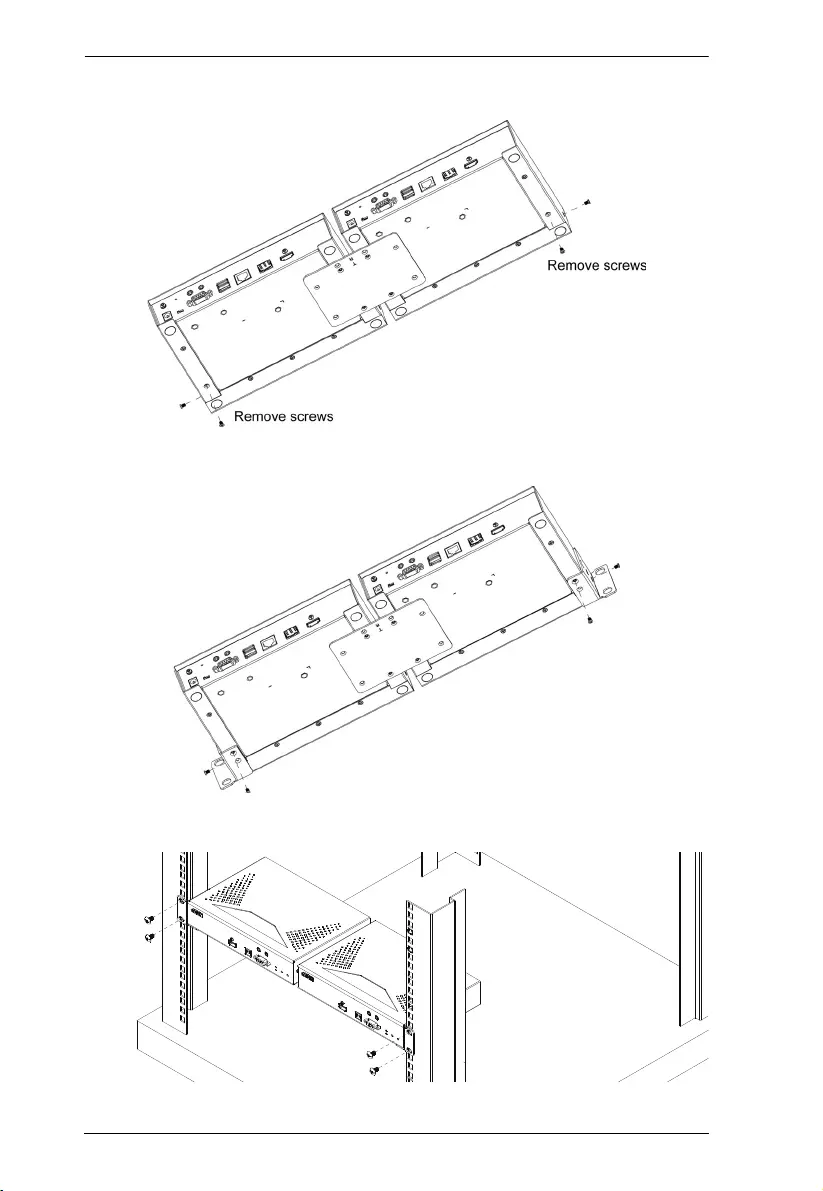
UPS User Manual
288
2. Remove the bottom and side screws from each unit.
3. Use the screws in step 2 to install the left and right mounting brackets.
4. Screw the mounting brackets to the rack.
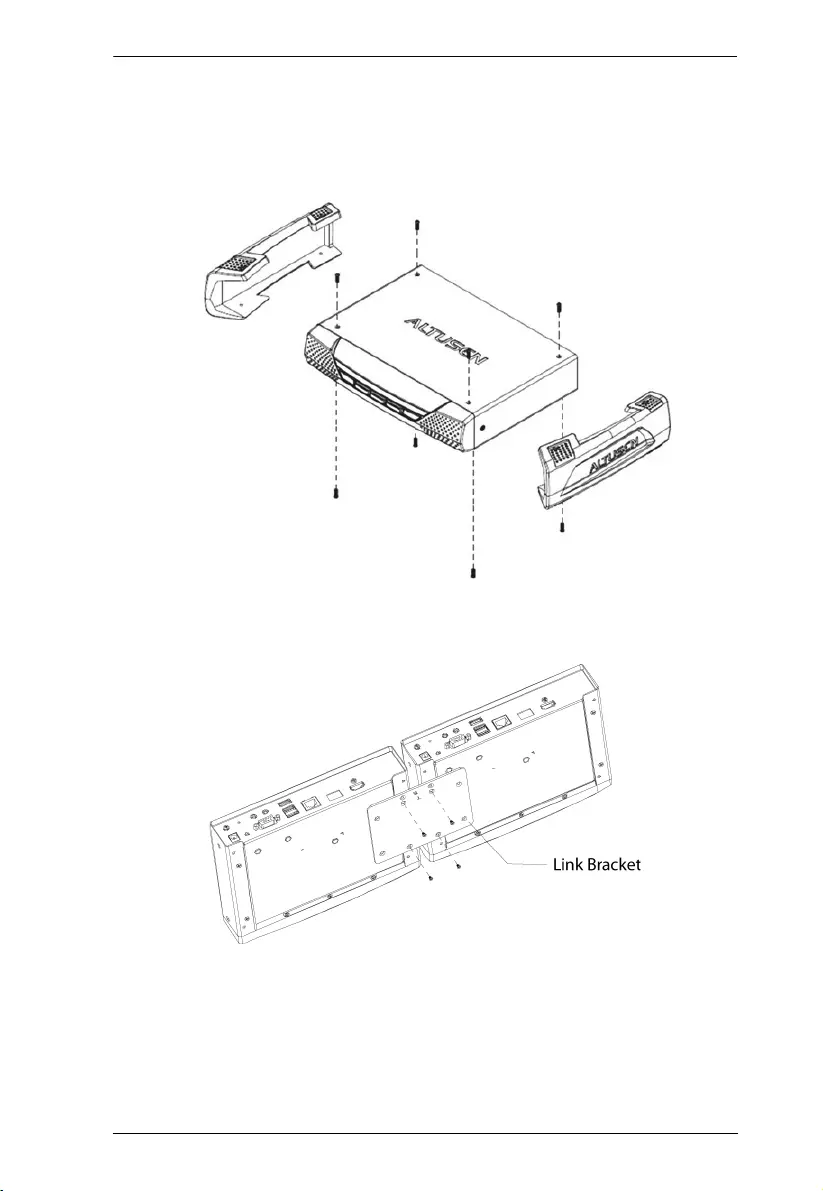
Appendix
289
Receiver Dual Rack Mounting
KE8950R is the example used here.
1. Remove the eight screws and plastic guards from the receiver units.
2. Remove four screws from the units and then use the same screws to secure
the units together with the link bracket provided with the kit.
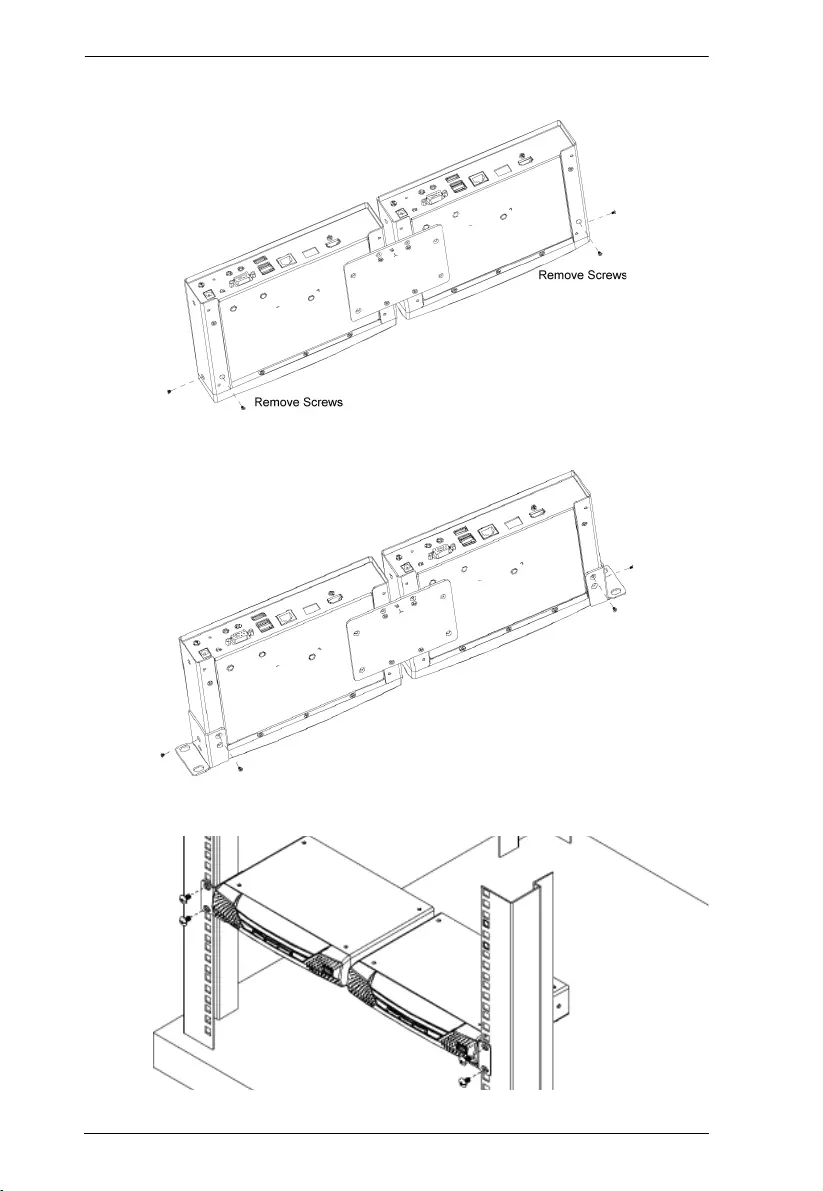
UPS User Manual
290
3. Remove the bottom and side screws from each unit.
4. Use the screws in step 3 to install the left and right mounting brackets.
5. Screw the mounting brackets to the rack.
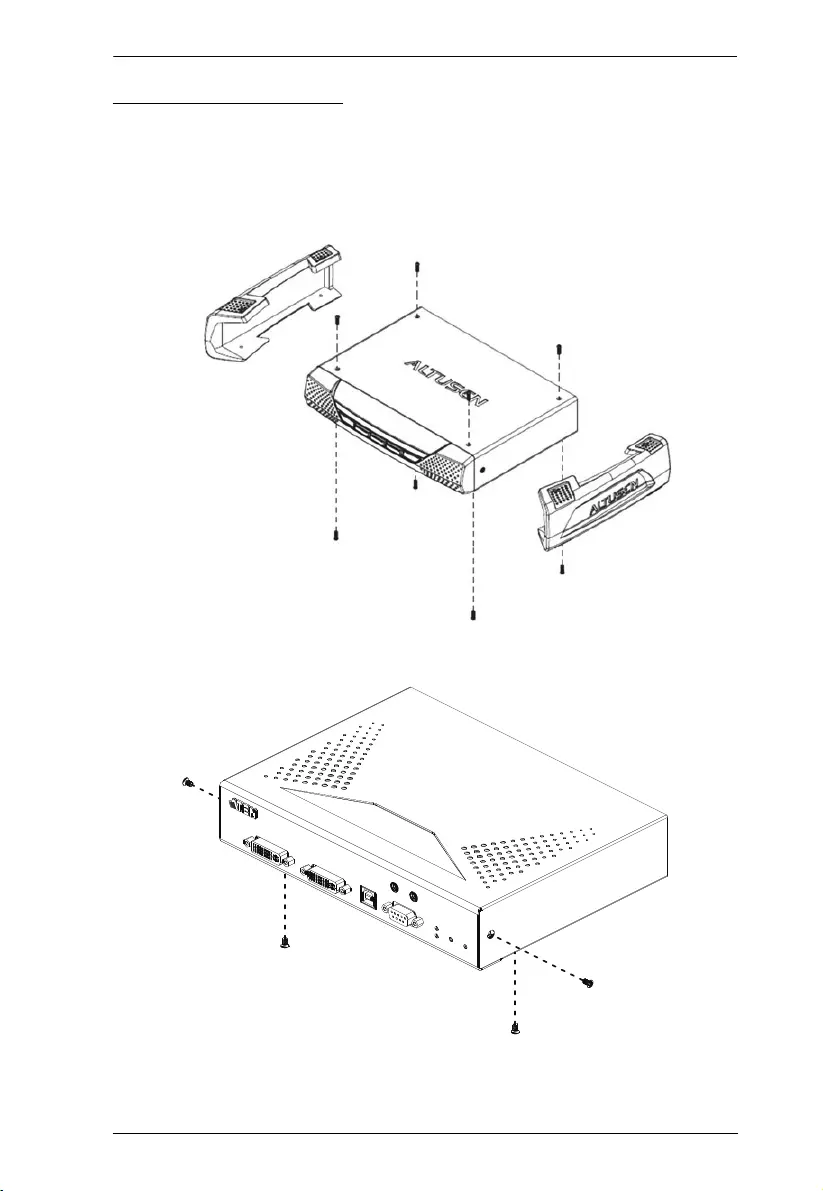
Appendix
291
Single Rack Mounting
The 2X-031G Single Rack Mounting kit installs one KE6900/KE6940/
KE8950/KE8952 unit in 1U of server rack space.
1. Remove the eight screws and plastic guards from the unit (Receiver units
only).
2. Remove the bottom and side screws from the unit.
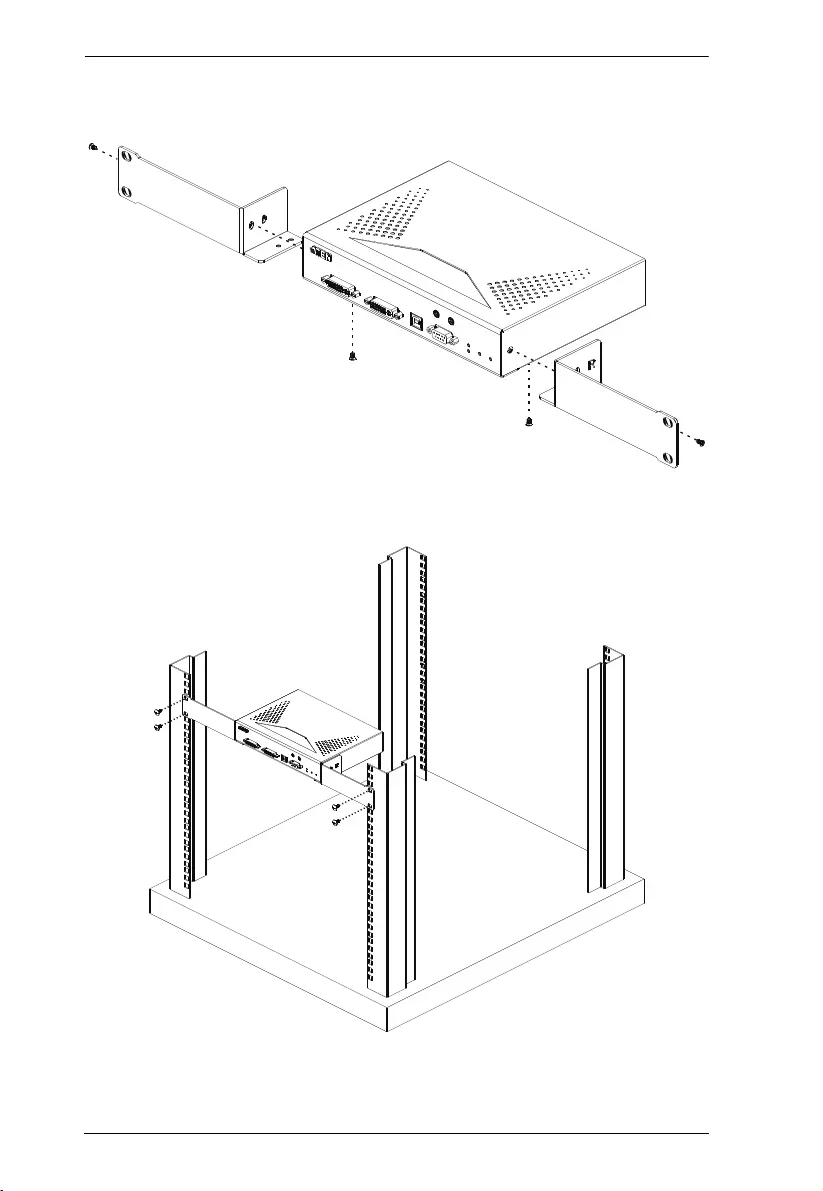
UPS User Manual
292
3. Use the screws in step 2 to install the right and left mounting brackets.
4. Screw the mounting brackets to the rack.
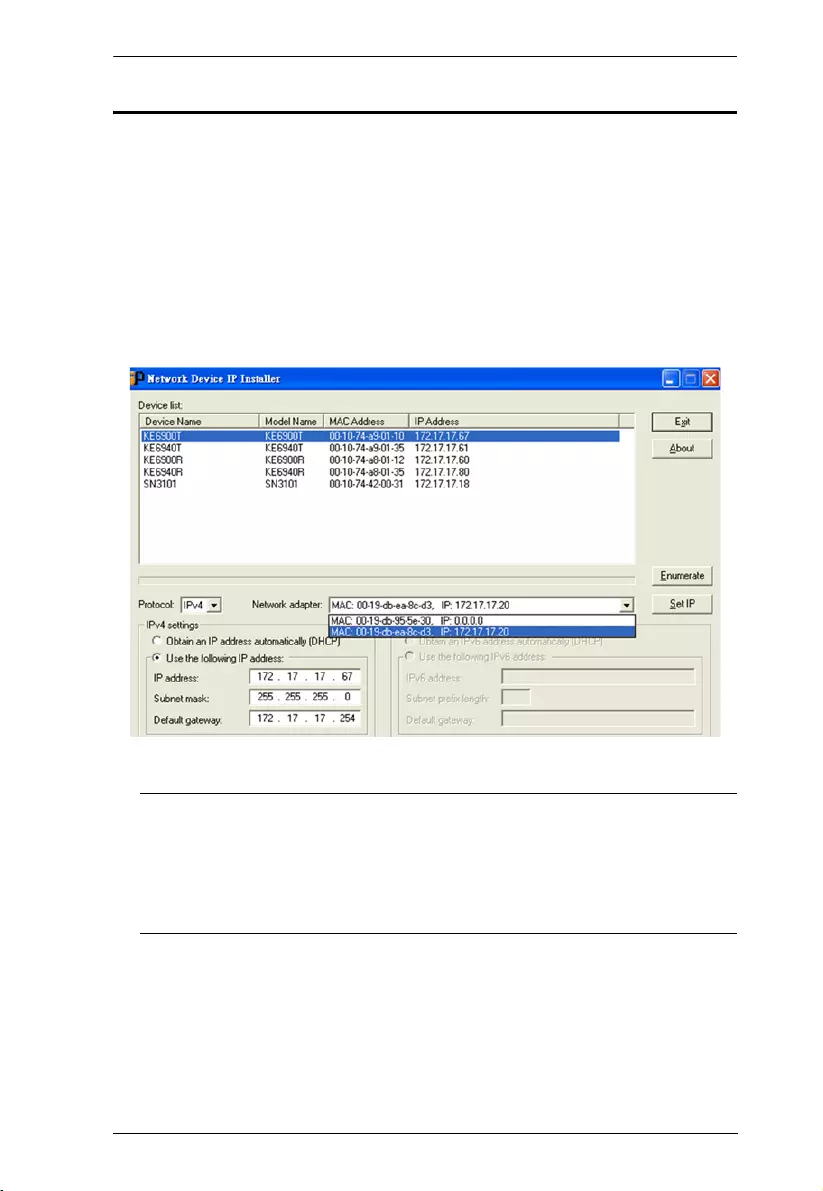
Appendix
293
IP Installer
From a client computer running Windows, an IP address for a transmitter or
receiver can be assigned with the IP Installer utility. The utility can be obtained
from the Download area of our website or from the product page on the
Software & Driver tab. After downloading the utility to your client computer,
do the following:
1. Unzip the contents of IPInstaller.zip to a directory on your hard drive.
2. Go to the directory that you unzipped the IPInstaller program to and run
IPInstaller.exe. A dialog box similar to the one below appears:
3. Select the Transmitter or Receiver in the Device List.
Note: 1. If the list is empty, or your device doesn't appear, click
Enumerate to refresh the Device List.
2. If there is more than one device in the list, use the MAC address
to pick the one you want. The MAC address is located on the
devices bottom panel.
4. Select either Obtain an IP address automatically (DHCP), or Specify an
IP address. If you chose the latter, fill the IP Address, Subnet Mask, and
Gateway fields with the information appropriate to your network.
5. Click Set IP.
6. After the IP address shows up in the Device List, click Exit.
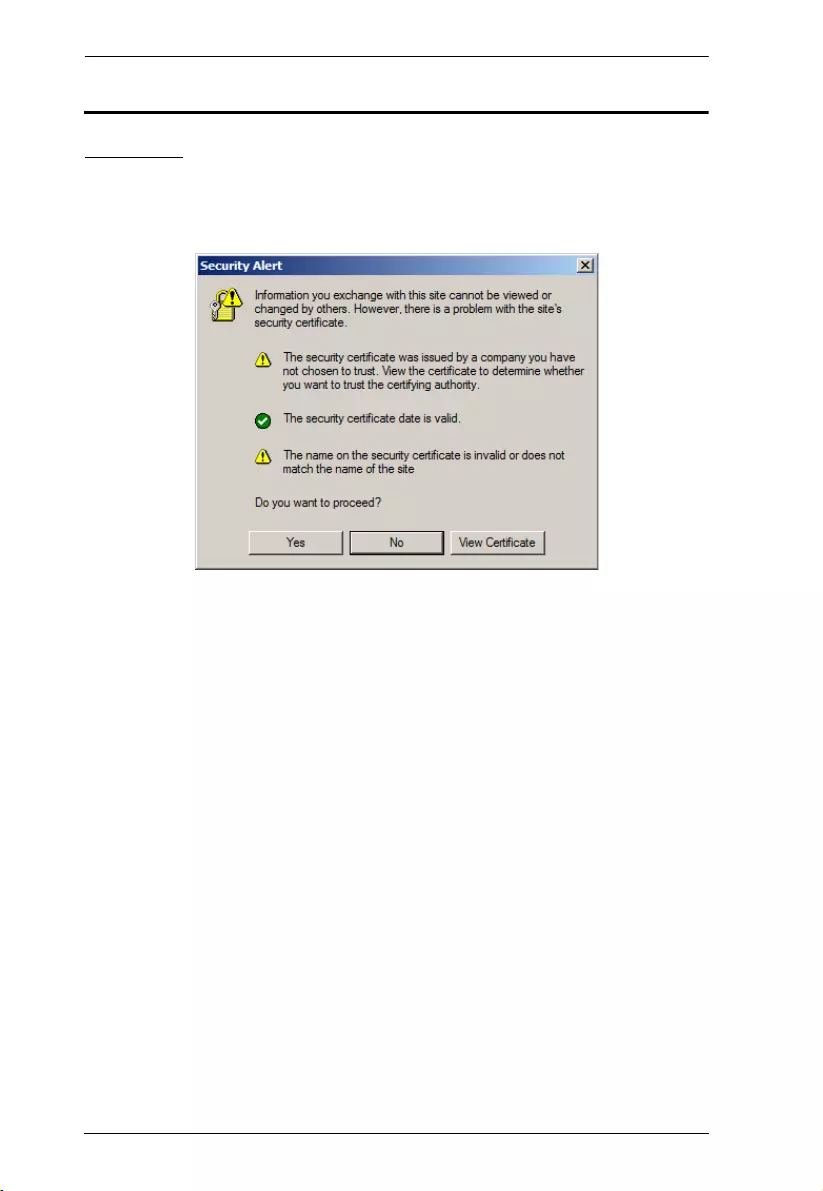
UPS User Manual
294
Trusted Certificates
Overview
When you try to log in to the device from your browser, a Security Alert
message appears to inform you that the device’s certificate is not trusted, and
asks if you want to proceed.
The certificate can be trusted, but the alert is triggered because the certificate’s
name is not found on the Microsoft list of Trusted Authorities. You can ignore
the warning and click Ye s to go on.

Appendix
295
Self-Signed Private Certificates
If you wish to create your own self-signed encryption key and certificate, a free
utility – openssl.exe – is available for download over the web at
www.openssl.org. To create your private key and certificate do the following:
1. Go to the directory where you downloaded and extracted openssl.exe to.
2. Run openssl.exe with the following parameters:
openssl req -new -newkey rsa:1024 -days 3653 -nodes -x509
-keyout CA.key -out CA.cer -config openssl.cnf
Note: 1. The command should be entered all on one line (i.e., do not press
[Enter] until all the parameters have been keyed in).
2. If there are spaces in the input, surround the entry in quotes (e.g.,
“ATEN International”).
To avoid having to input information during key generation the following
additional parameters can be used:
/C /ST /L /O /OU /CN /emailAddress.
Examples
openssl req -new -newkey rsa:1024 -days 3653 -nodes -x509
-keyout CA.key -out CA.cer -config openssl.cnf -subj
“/C=yourcountry/ST=yourstateorprovince/L=yourlocationor
city/O=yourorganiztion/OU=yourorganizationalunit/
CN=yourcommonname/emailAddress=name@yourcompany.com
openssl req -new -newkey rsa:1024 -days 3653 -nodes -x509
-keyout CA.key -out CA.cer -config openssl.cnf -subj
“/C=CA/ST=BC/L=Richmond/O=ATEN International/OU=ATEN
/CN=ATEN/emailAddress=eservice@aten.com.tw
Importing the Files
After the openssl.exe program completes, two files – CA.key (the private key)
and CA.cer (the self-signed SSL certificate) – are created in the directory that
you ran the program from.
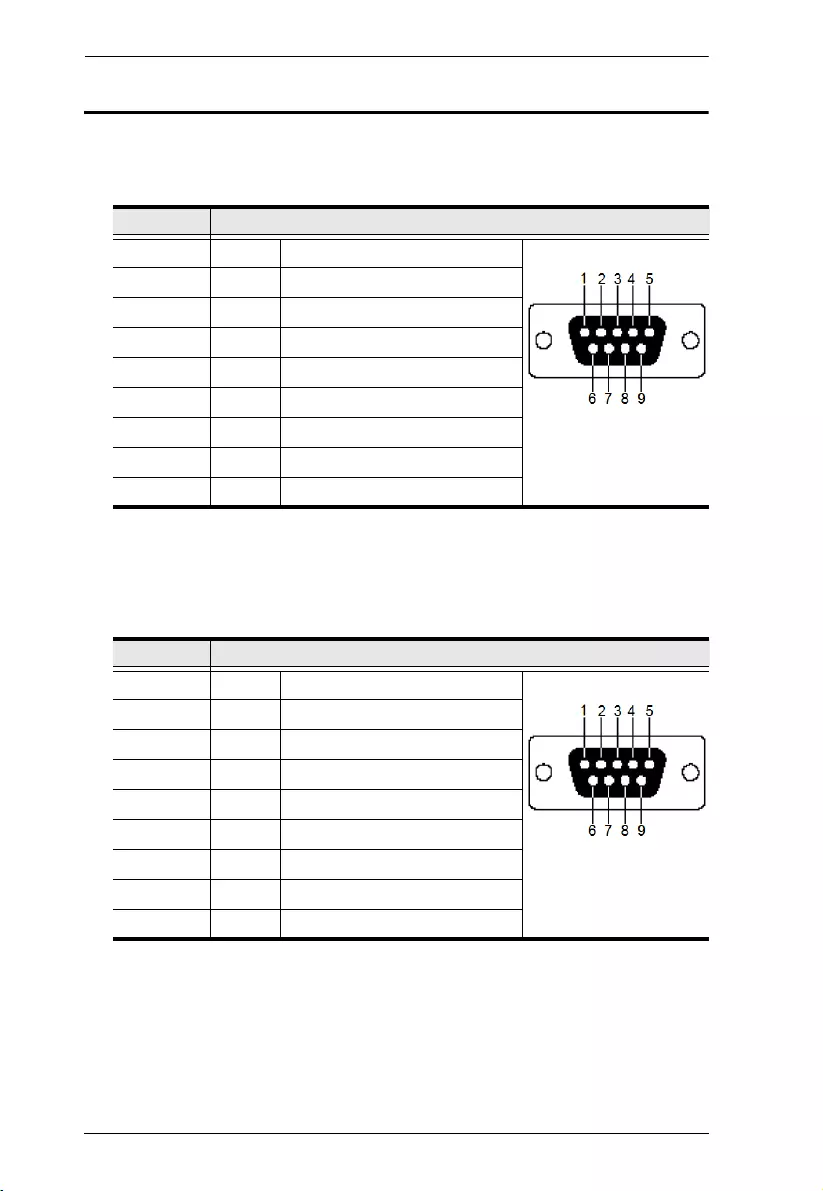
UPS User Manual
296
RS-232 Pin Assignments
Pin assignments for the Transmitter and Receiver’s rear RS-232 port that is
used for connecting to a serial terminal are given in the table, below:
Transmitter Front RS-232 Port
Pin assignments for the Transmitter’s front RS-232 port that is used for
connecting to a computer for serial control are given in the table, below:
Pin Assignment
1 N/A None
DB9 Male
2 RXD Receive Data
3 TXD Transmit Data
4 DTR Data Terminal Ready
5 GND Signal Ground
6 DSR Data Set Ready
7 RTS Request to Sent
8 CTS Clear to Sent
9 N/A None
Pin Assignment
1 N/A None
DB9 Female
2 TXD Transmit Data
3 RXD Receive Data
4 DSR Data Set Ready
5 GND Signal Ground
6 DTR Data Terminal Ready
7 CTS Clear to Sent
8 RTS Request to Sent
9 N/A None

Appendix
297
Multicast IP Address
Multicasting helps to broadcast audio and video data from a transmitter to
multiple Receivers over a network. To setup up Multicasting on a network
switch you must know the Audio and Video Multicast IP address which can be
found on the KE Transmitter. To determinate the default Multicast IP address
set by the KE device use the instructions below. The Multicast IP addresses can
be set manually using Telnet.
KE Multicast Rule
All Audio and Video Multicast IP addresses use the format: 230.X.Y.Z.
X.Y.Z relates to the Transmitter’s IP address and 230 is always the first octet
of a Multicast IP address. You use the Transmitter’s IP address to find X and
then use it to calculate the Audio and Video Multicast IP address.
Multicast IP Formula
To calculate the Audio and Video Multicast IP address, use the Transmitter’s
IP address to determine X and then use the appropriate table below to calculate
the Multicast IP address for each data stream (audio/video).
Example:
Transmitter IP Address: 172.16.27.146; (172.X.Y.Z)
X =16
If X is between 0 ~ 127
Transmitter IP XVideo
X + 128
Audio
X + 192
Multicast
Video IP
Address
Multicast
Audio IP
Address
172.16.27.146
(example)
16 16 + 128 =
144
16 + 192 =
208
230.144.27.146 230.208.27.146
___+ 128 = ___+ 192 =
230.___.___.__ 230.___.___.__
___+ 128 = ___+ 192 =
230.___.___.__ 230.___.___.__
___+ 128 = ___+ 192 =
230.___.___.__ 230.___.___.__

UPS User Manual
298
If X is between 128 ~ 192
If X is 192 or higher
Transmitter
IP
X - 128
= A
Video
A + 128
Audio
A + 192
Multicast
Video IP
Address
Multicast
Audio IP
Address
172.168.27.14
(example)
168 - 128
= 40
40 + 128
= 168
40 + 192
= 232
230.168.27.14 230.232.27.14
___ - 128
=
___+ 128
=
___+ 192
= 230.___.___.__ 230.___.___.__
___ - 128
=
___+ 128
=
___+ 192
= 230.___.___.__ 230.___.___.__
___ - 128
=
___+ 128
=
___+ 192
= 230.___.___.__ 230.___.___.__
Transmitter
IP
X - 192
= A
Video
A + 128
Audio
A + 192
Multicast
Video IP
Address
Multicast
Audio IP
Address
172.200.27.14
(example)
200 - 192
= 8
8 + 128
= 136
8 + 192
= 200
230.136.27.14 230.200.27.14
___ - 192
=
___+ 128
=
___+ 192
= 230.___.___.__ 230.___.___.__
___ - 192
=
___+ 128
=
___+ 192
= 230.___.___.__ 230.___.___.__
___ - 192
=
___+ 128
=
___+ 192
= 230.___.___.__ 230.___.___.__

Appendix
299
Keys to Network Performance
For optimum performance, KE Series devices requires high amounts of data to
be transferred across a network; therefore we recommend the following
strategies to setup KE Series devices. Using our suggestions will provide better
performance and the highest video resolutions possible. Use each of the keys
to ensure the best transmission of data and the highest throughput possible.
Build a Network Diagram
To build an effective KE installation, start by mapping out the layout. Create a
diagram with the KE devices, computers and routers along with how they will
be connected across the network. It also helps to write out how the devices will
interact. Use this diagram as the frame work as you decide what devices to
purchase and how to build the network effectively for the best data throughput.
Considerations:
If possible, create a private network for the KE devices
Use the same switch model throughout
Use a flat cascaded layout
Avoid a tree or pyramid structure
Limit cascades to two levels
Install network switches near each other
Minimize the distance of connections
Install KE Matrix Manager (CCKM) computer and KE devices on the
same subnet
Check the 3 Other Factors before installation
Other Factors
Choose the Right Cable
Always use Cat 5/6e Ethernet cable or higher installed by a professional
between any two devices you are installing. We recommend using ATEN
Brand Ethernet cable to ensure the quality. It’s best when installing KE devices
to use brand new Ethernet cabling for each part of the installation to ensure the
reliability of the data being transmitted. This is a key to getting the best
uninterrupted video resolution across the network.
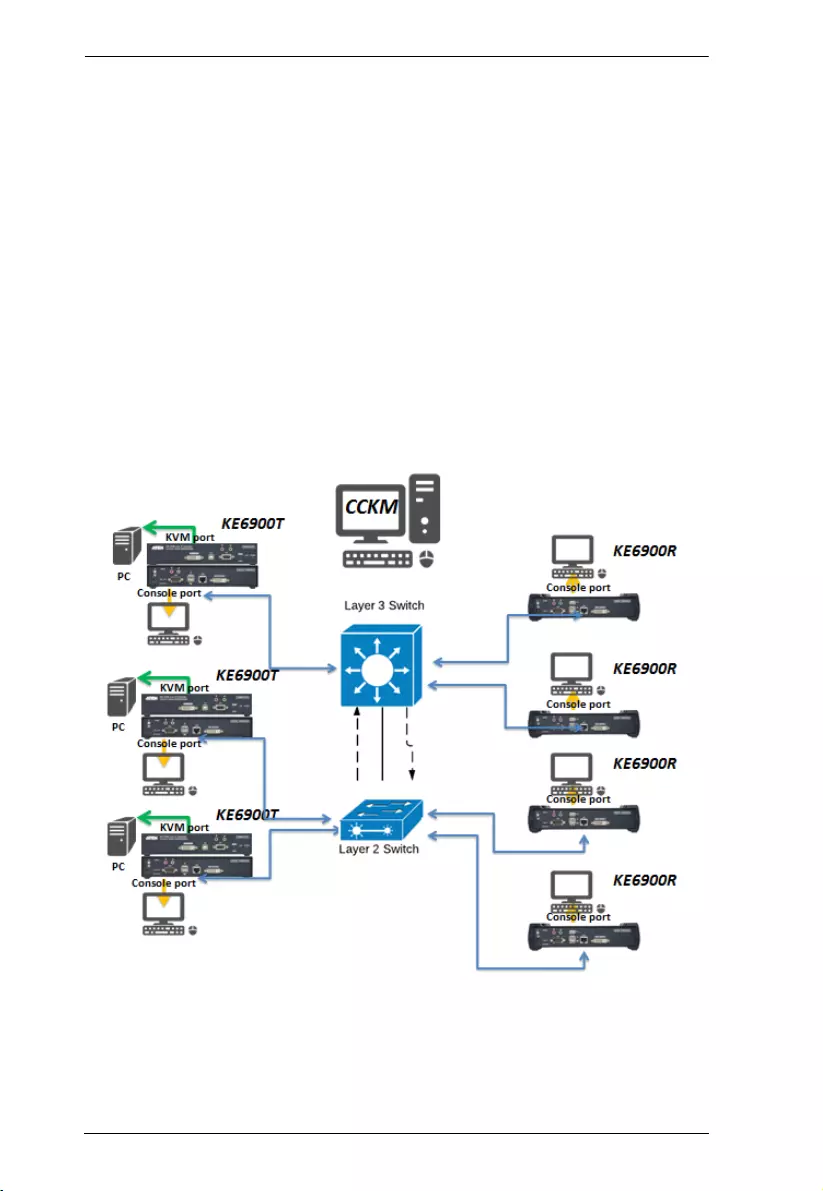
UPS User Manual
300
Determine the Distance
Distance is an important factor when setting up networks, with a shorter
distance and fewer hops through routers, data can be transmitted more
efficiently. So whenever possible decrease the distance and direct network
traffic effectively between subnets that communicate with each other to
increase the data throughput.
Ensure the Bandwidth
Ensuring the bandwidth ahead of time will guarantee performance before
installing KE devices on a network. This will eliminate the primary cause of
problems related to video quality and transmission of data. If the speed is right
at all ends of your network, then the only other causes are derived from device
failure or limits caused by a router, switch or device setting.
Sample Network Diagram

Appendix
301
Choose a High Performance Switch
A high performance network switch is the means of a successful KE setup.
When choosing a network switch, first select the type:
Layer 2 or Layer 3 Switches
You’ll need to determine whether you need a layer 2 or a layer 3 switch for
your KE network. Layer 3 switches cost more than layer 2 switches because
they are more complex and handle more network traffic. The best way to
calculate which type of switch you need is to first determine if you will have a
dedicated network for the KE devices or if the KE devices will be on a network
that shares throughput with other network equipment such as computers,
servers and printers. If they share the network with other devices its best to
consider a layer 3 switch and use layer 2 switches exclusively for the KE device
connections. For larger installations we recommend using Layer 3 switches.
The major differences are:
Layer 3 Switch: IP addresses in packets are examined and intelligent
forwarding decisions are made. On a larger network broken into subnets
across long distances, a layer 3 switch becomes the best choice as they
can improve network efficiency and provide better traffic flow. They
are better at directing more traffic to different locations on a larger more
complex network, and with layer two switches working below them.
Layer 2 Switch: Packets are examined and forwarded using only the
MAC address. If you have a small central network, a layer 2 switch
should do the job. If the network is exclusive and will only transmit the
bandwidth of KE devices, layer 2 switches with the correct settings can
get the job done effectively.
Considerations
Number of ports
Choose a switch that has enough ports to match the number of KE devices you
will be installing. Switches typically come in 5, 8, 10, 16, 24, 28, 48, and 52-
port configurations. If you are installing 13 KE transmitters and 13 KE
receivers, you will need to purchase a switch with at least 28 ports.
Stackable verse Standalone
Stackable switches allow you to easily manage and configure ports spanning
across multiple switches that the KE devices are connected through. This
provides a centralized method to configure and troubleshoot the initial setup of

UPS User Manual
302
KE devices on a network which makes fine tuning the bandwidth, data
throughput and video quality easier. Stackable switches can be configured to
direct the KE transmissions between many units more specifically and
effectively. Standalone switches provide the same configuration features as
Stackable switches but they must be set individually.
Stackable switches provide an easy way to manage multiple switches, as one
unit. For example, instead of configuring, managing, and troubleshooting 6 28-
port switches individually, you can manage the six as if they are a single unit
using Stackable Switches. The six switches (168 ports) function as a single
switch and are managed from one web or GUI interface.
What Stackable Switches Can do:
1. Create a link aggregation group with one port in one unit of the stack and
another port of that group in another switch in the stack.
2. Select a port on one switch in the stack and mirror the traffic to a switch
port on another unit of the stack; thus copy the configuration to direct
traffic more effectively between KE devices.
3. Apply custom ACL security settings to any port on any switch in the stack.
4. Stackable switches can be setup in a ring configuration, so that if a port or
cable fails, the stack automatically routes around the failure, at
microsecond speeds. Stackable Switches also allow you to add and remove
stack “members” which are automatically updated and recognized as such.
Switch Specifications
The following specifications are recommended when choosing a layer 2 or
layer 3 switch:
1000Mbps Gigabit Ethernet switches (1000Mbps or faster Ethernet ports)
High bandwidth between switches, if possible using Fibre Channel
Layer 3 switches that efficiently processes IGMP queries
IGMP Snooping v2 or v3
Flow Control Functions
Throughput of: Full Duplex, 1Gbps up- and down- stream speeds per port
Performance of their most onerous tasks (e.g. IGMP snooping) with
multiple dedicated processors (ASICS)
Use the same switch make and model throughout each subnet

Appendix
303
The maximum number of simultaneous ‘snoopable groups’ the switch can
handle meets or exceeds the number of KE transmitters that will be used to
create Channel groups
Configuring Switches and KE Devices
Configuring the switch correctly will pass data more efficiently, allowing a
better stream across the network to each KE device. The following settings will
help optimize your network traffic through a switch:
Enable IGMP Snooping on L2 switches
Enable IGMP Querier on the L3 switch
Enable IGMP Fast-Leave on all switches where KE units are directly
connected
Enable Spanning Tree Protocol (STP) on all switches and enable Portfast
exclusively on switch ports that have KE units connected
Pick an appropriate forwarding mode on all switches. Use Cut-through if
available, or Store and Forward (see Recommended Network Switches
below)
KE transmitter Settings:
Adjust the KE transmitter settings one at a time, in small intervals, and
view the images as you do, so that you can adjust to the positive or
negative results and achieve the best quality and bandwidth possible
If the quality of color is important, set the Color Depth to 24 bits (KE69
Series) or 36 bits (KE89 Series) and manually adjust other settings until
you are satisfied with the visual appearance
If moving video images are shown frequently, increase the Video Quality
setting to the highest level and reduce the Bandwidth Limit and Color
Depth setting.
When images on the screen are more often static, increase the Background
Refresh and/or the Video Quality settings
Check that all KE units have been updated with the latest firmware version
Recommended Network Switches
Below are the network switches that have passed ATEN's stress tests using the
KE Series extenders. Our tests streamed content over a network with a
resolution of 1920 x 1200 @60Hz (KE69 Series, KE8900S, KE9900ST); 24 bit
color depth and 3840 x 2160 @30Hz (KE8950 and KE8952); 36 bit color
depth.

UPS User Manual
304
Cisco Catalyst 2960X / Catalyst 2960XR / Catalyst 3750
HP Procurve 2920
H3C S5120
Huawei S5700
DLink DGS-1510
Please refer to the FAQ link below on how to select network switches and
network switch information collected by ATEN Customer Service Division,
where the collected information includes customer's feedback from their actual
experience in using and installing the product(s).
https://eservice.aten.com/eServiceCx/Common/FAQ/view.do?id=6276

Appendix
305
Setup CCKM Server IP address on Windows
1. Select Network and Sharing Center and click Change adapter settings.
2. Right-click Local Area Connection and select Properties.
3. In the Local Area Connection Properties window, highlight Internet
Protocol Version 4 (TCP/IPv4) then click Properties.
4. Select Use the following IP address and enter in the IP for the CCKM
server (e.g. any IP address not in use, and in between 192.168.0.2 and
192.168.0.253)*, Subnet Mask (e.g. 255.255.255.0), and Default Gateway
that corresponds with your network setup.
5. Click OK to change the CCKM server’s IP address.
Note: Make sure the CCKM server's IP address is not a duplicate to prevent
IP address conflict.
To connect to the CCKM server via web browser, enter the CCKM IP address
and port number (default: 8443). For example, if the CCKM IP address is
192.168.0.10, then enter https://192.168.0.10: 8443.
If you have a 2nd NIC, please follow the following steps.
6. Select Network and Sharing Center and click Change adapter settings.
7. Right-click Local Area Connection for the 2nd NIC and select
Properties.
8. In the Local Area Connection Properties window, highlight Internet
Protocol Version 4 (TCP/IPv4) then click Properties.
9. Select Use the following IP address and enter in the IP of the 2nd subnet
for the CCKM server (e.g. any IP address not in use, and in between
192.168.1.2 and 192.168.1.253)*, Subnet Mask (e.g. 255.255.255.0), and
Default Gateway that corresponds with your network setup.
10. Click OK to change the CCKM server’s IP address of the 2nd subnet.

UPS User Manual
306
Limited Warranty
ATEN warrants its hardware in the country of purchase against flaws in
materials and workmanship for a Warranty Period of two [2] years (warranty
period may vary in certain regions/countries) commencing on the date of
original purchase. This warranty period includes the LCD panel of ATEN LCD
KVM switches. Select products are warranted for an additional year (see A+
Warranty for further details). Cables and accessories are not covered by the
Standard Warranty.
What is covered by the Limited Hardware Warranty
ATEN will provide a repair service, without charge, during the Warranty
Period. If a product is detective, ATEN will, at its discretion, have the option
to (1) repair said product with new or repaired components, or (2) replace the
entire product with an identical product or with a similar product which fulfills
the same function as the defective product. Replaced products assume the
warranty of the original product for the remaining period or a period of 90 days,
whichever is longer. When the products or components are replaced, the
replacing articles shall become customer property and the replaced articles
shall become the property of ATEN.
To learn more about our warranty policies, please visit our website:
http://www.aten.com/global/en/legal/policies/warranty-policy/

